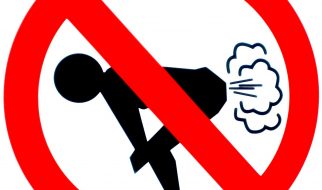Conspiracy theorists have been researching about this online and have come up with some wild ideas. This is a look into the actual facts and the info that is available about this medieval country.
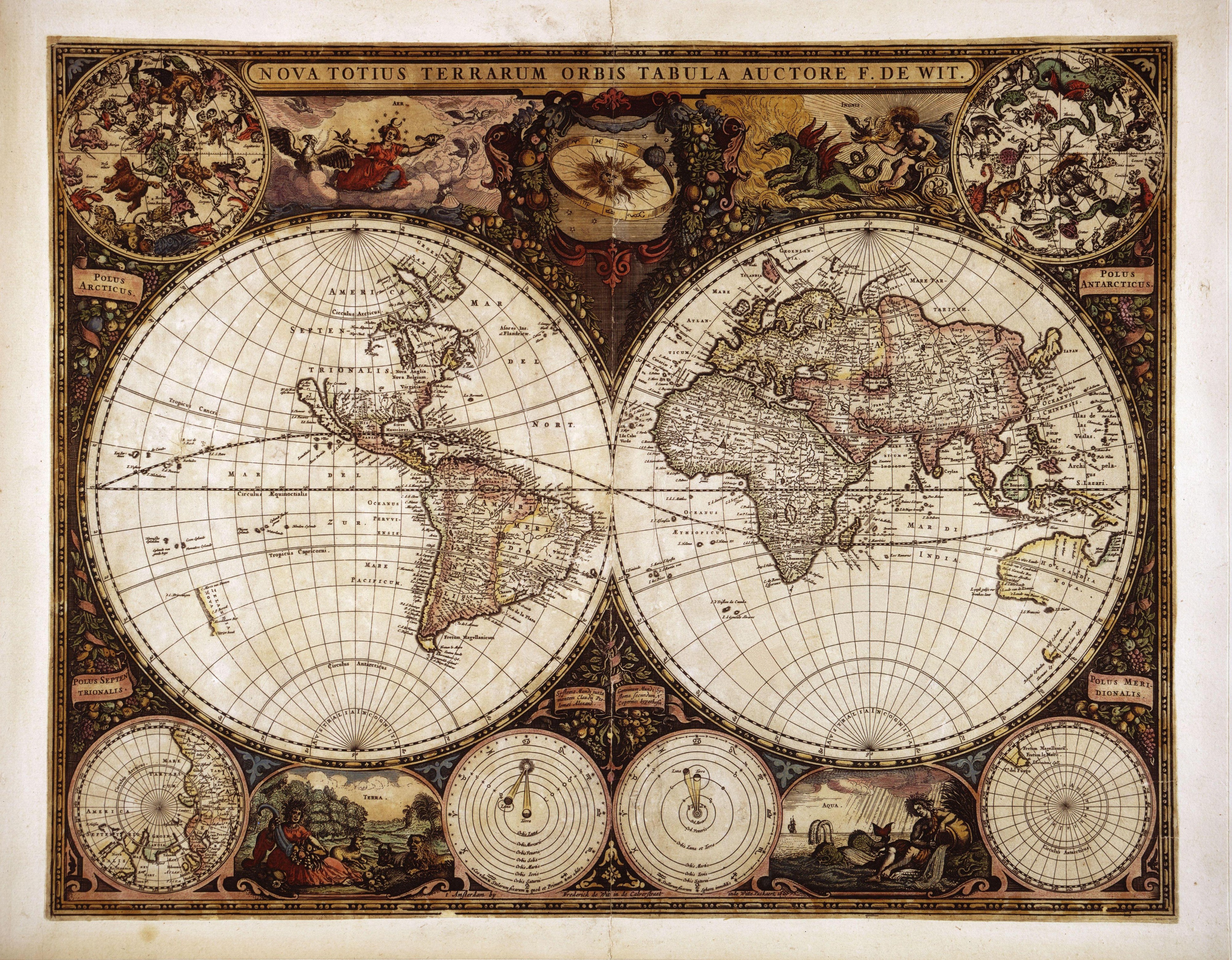 World Map (mentioning Tartaria and the Tartaric ocean) by Frederik de Wit
World Map (mentioning Tartaria and the Tartaric ocean) by Frederik de Wit
The Chinese have a proverb:
?The longest journey starts with but a single step?.
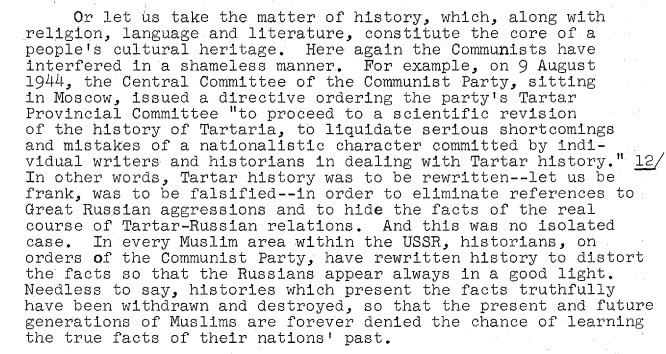 The declassified CIA document about Tartaria was declassified in 1998. (Source: https://www.cia.gov/library)
The declassified CIA document about Tartaria was declassified in 1998. (Source: https://www.cia.gov/library)
According to Wikipedia:
?Tartary (Latin: Tartaria) or Great Tartary (Latin: Tartaria Magna) was a historical region in Asia located between the Caspian Sea-Ural Mountains and the Pacific Ocean. Tartary was a blanket term used by Europeans for the areas of Central Asia, North Asia, and East Asia unknown to European geography. It encompassed the vast region of the Pontic-Caspian steppe, the Volga-Urals, the Caucasus, Siberia, Inner Asia, Mongolia and Manchuria.
Knowledge of Manchuria, Siberia and Central Asia in Europe prior to the 18th century was limited. The entire area was known simply as ?Tartary? and its inhabitants ?Tartars?. In the Early modern period, as understanding of the geography increased, Europeans began to subdivide Tartary into sections with prefixes denoting the name of the ruling power or the geographical location. Thus, Siberia was Great Tartary or Russian Tartary, the Crimean Khanate was Little Tartary, Manchuria was Chinese Tartary, and western Central Asia (prior to becoming Russian Central Asia) was known as Independent Tartary.?
Wikipedia claims that Tartaria was a blanket term and that not much knowledge was available to Europeans but in this book below written by Giovanni da Pian del Carpine in 1252 we can find an extensive research made about the Tartars and their empire.
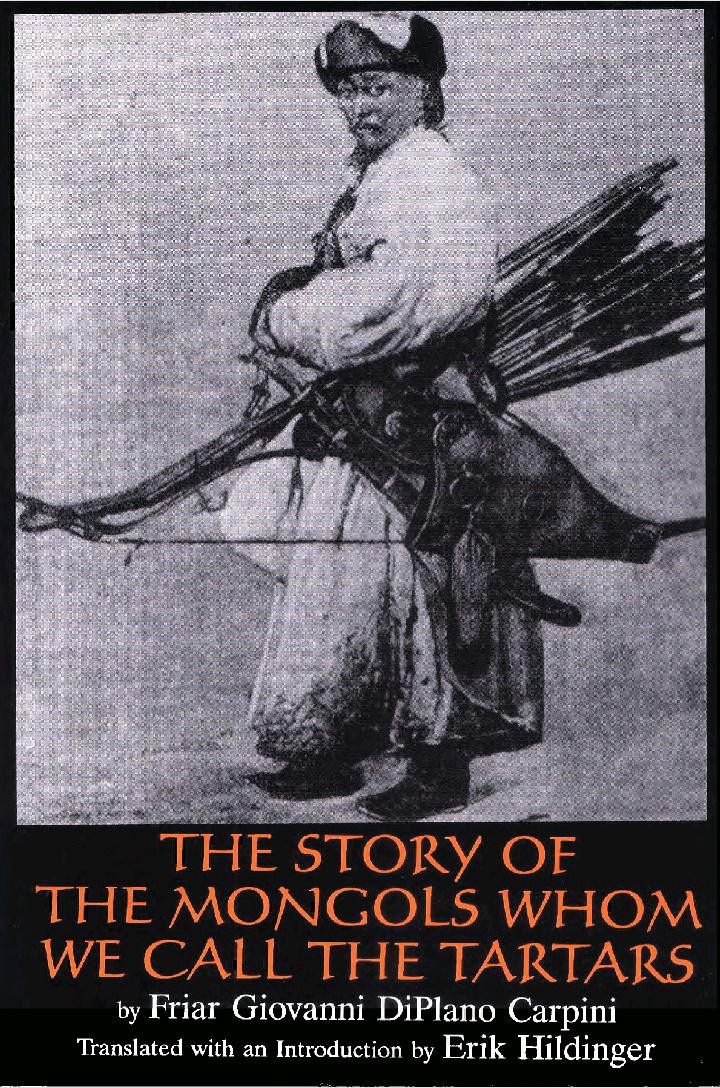 ?The Story of the Mongols whom we call the Tartars? (book, Friar Giovanni) (You can read it in pdf here.)
?The Story of the Mongols whom we call the Tartars? (book, Friar Giovanni) (You can read it in pdf here.)
Maps
From a vast Tartaria / Grand Tartaria / Grande Tartary in the beginning, it later splits into:
- Siberia & Russian Tartary / Tartaria Moscovite
- Chinese Tartary / Eastern Tartary
- Independent Tartaria / Tartary / Western
We can also see that north of modern Russia the Sea of Tartary becomes the Frozen Ocean / Ice Sea, modern Arctic ocean.
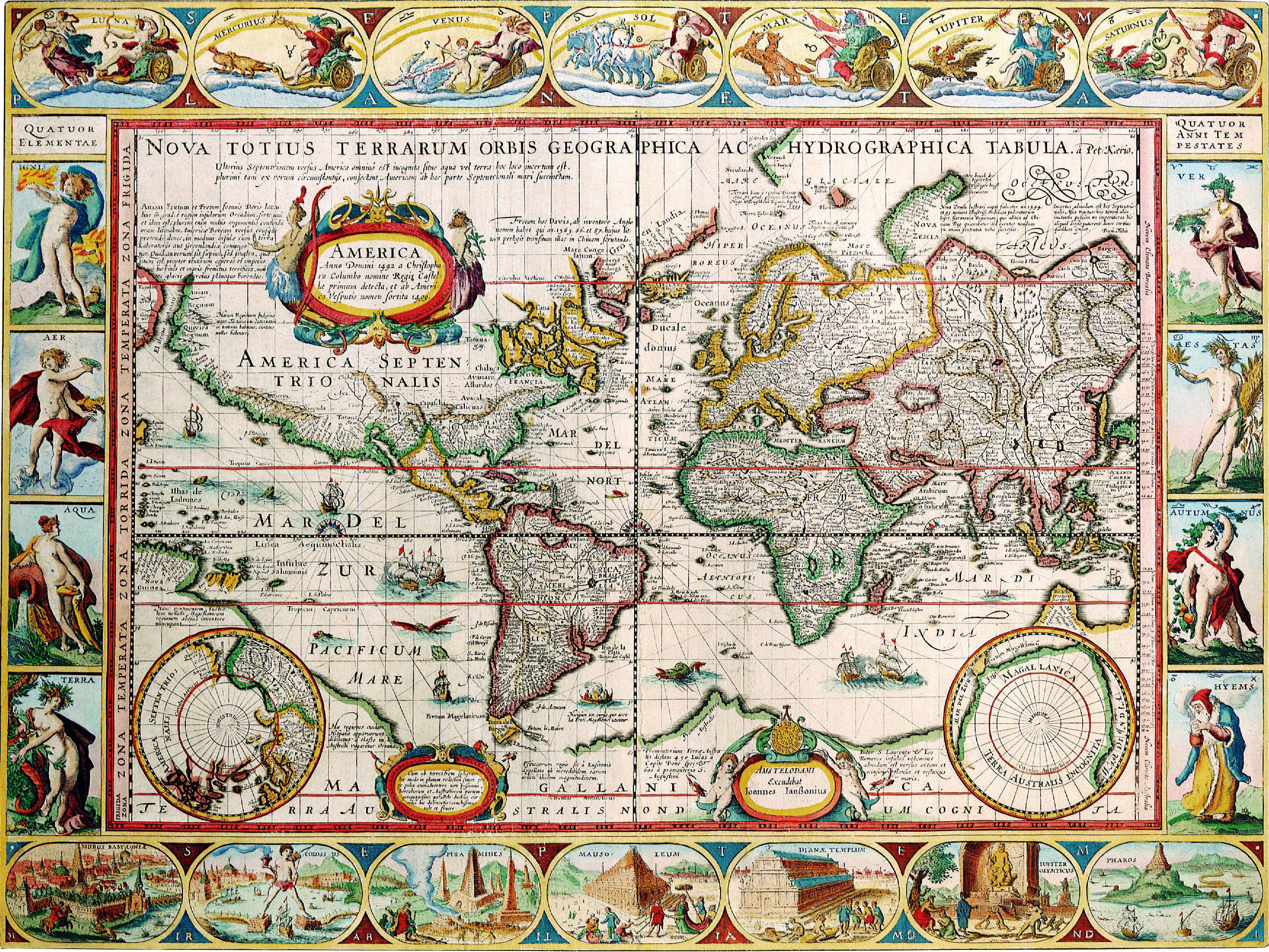
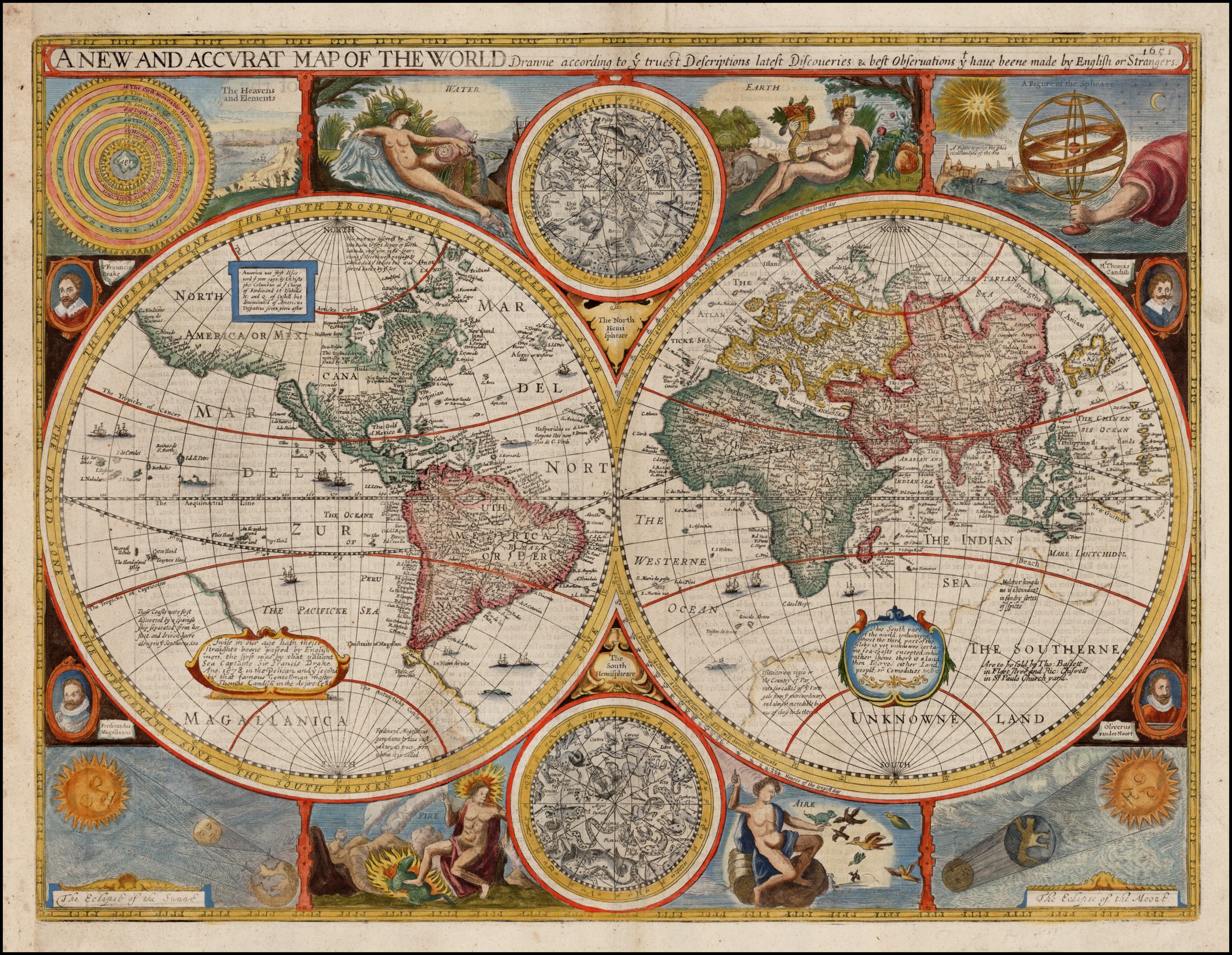
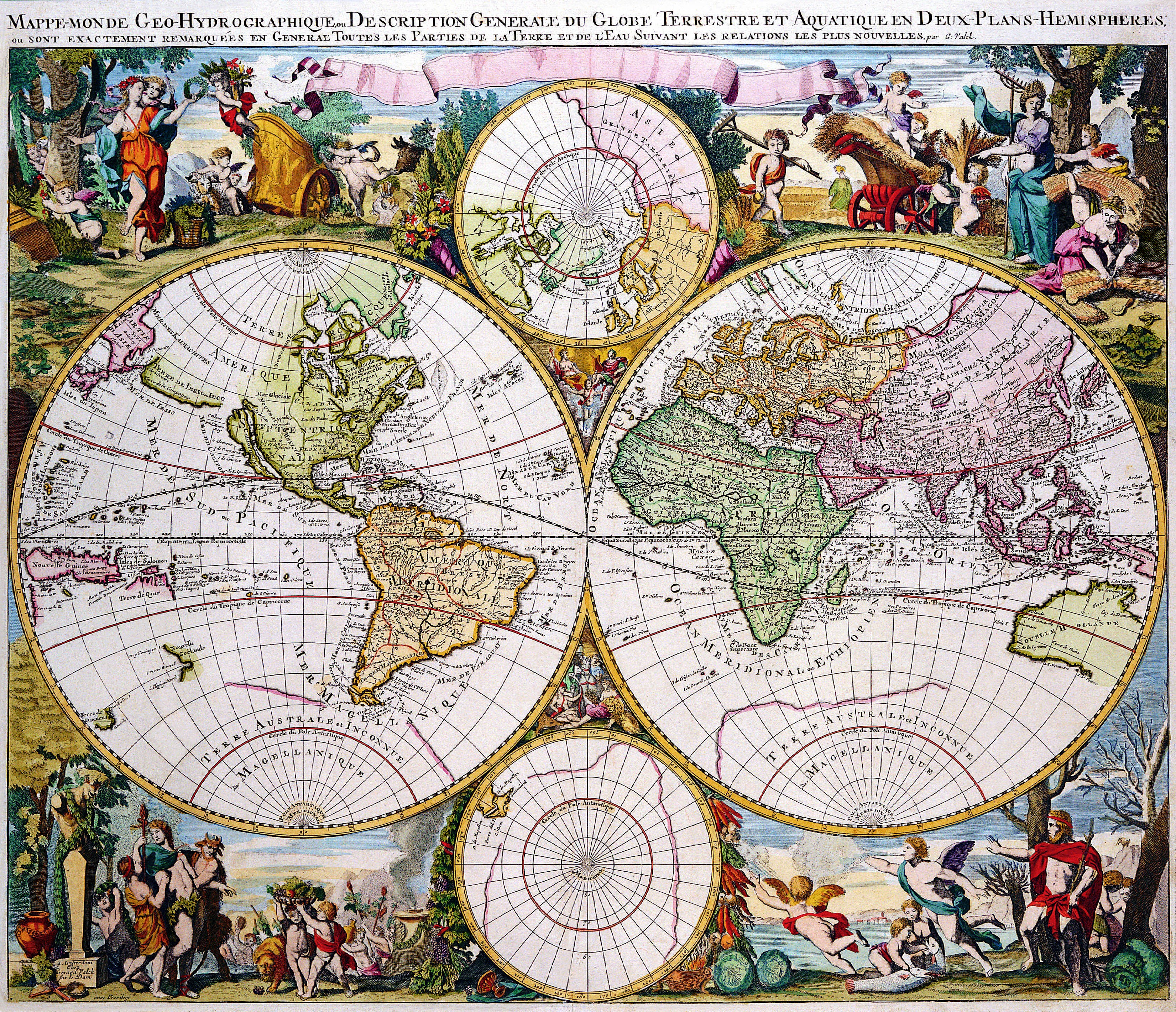
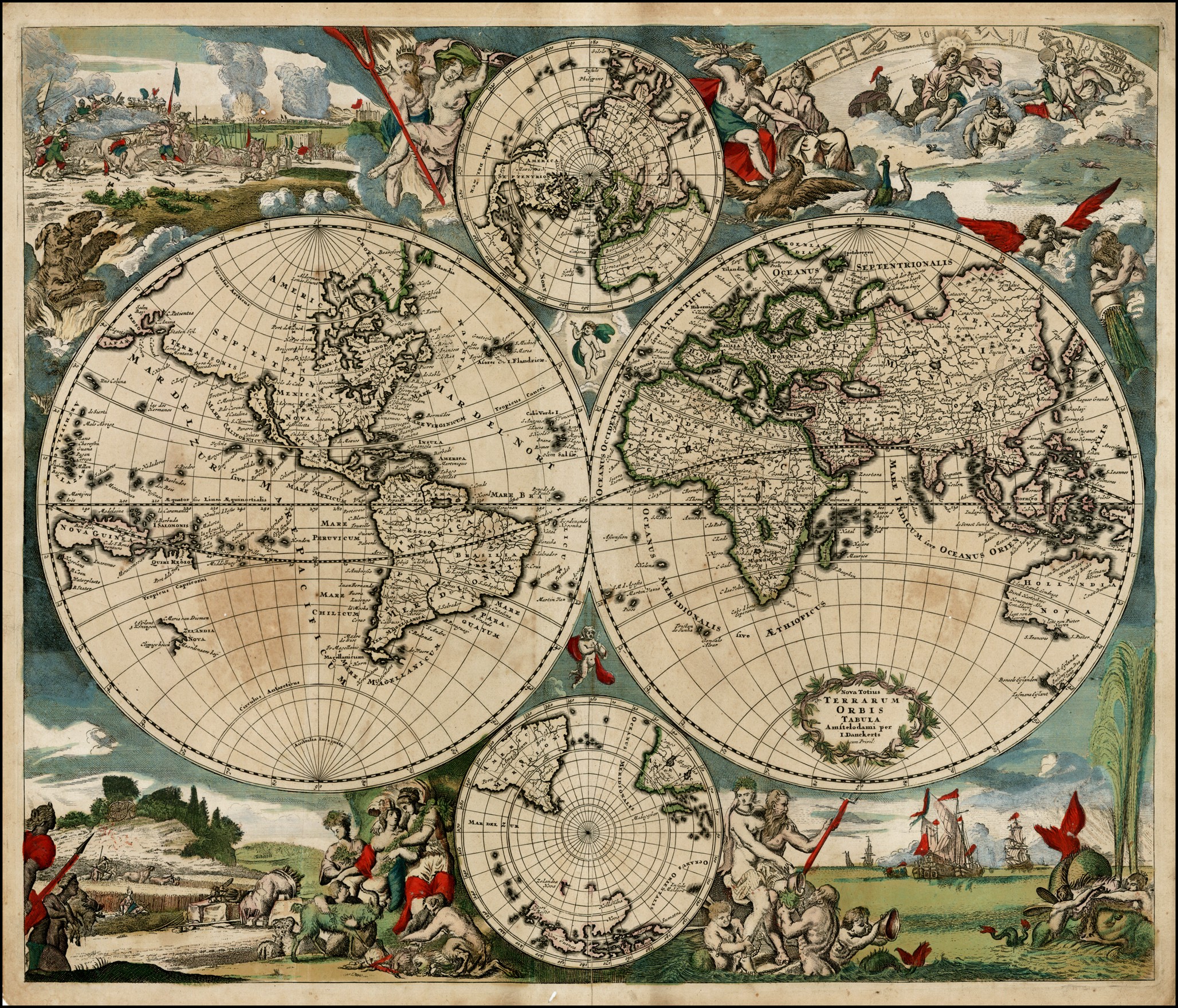
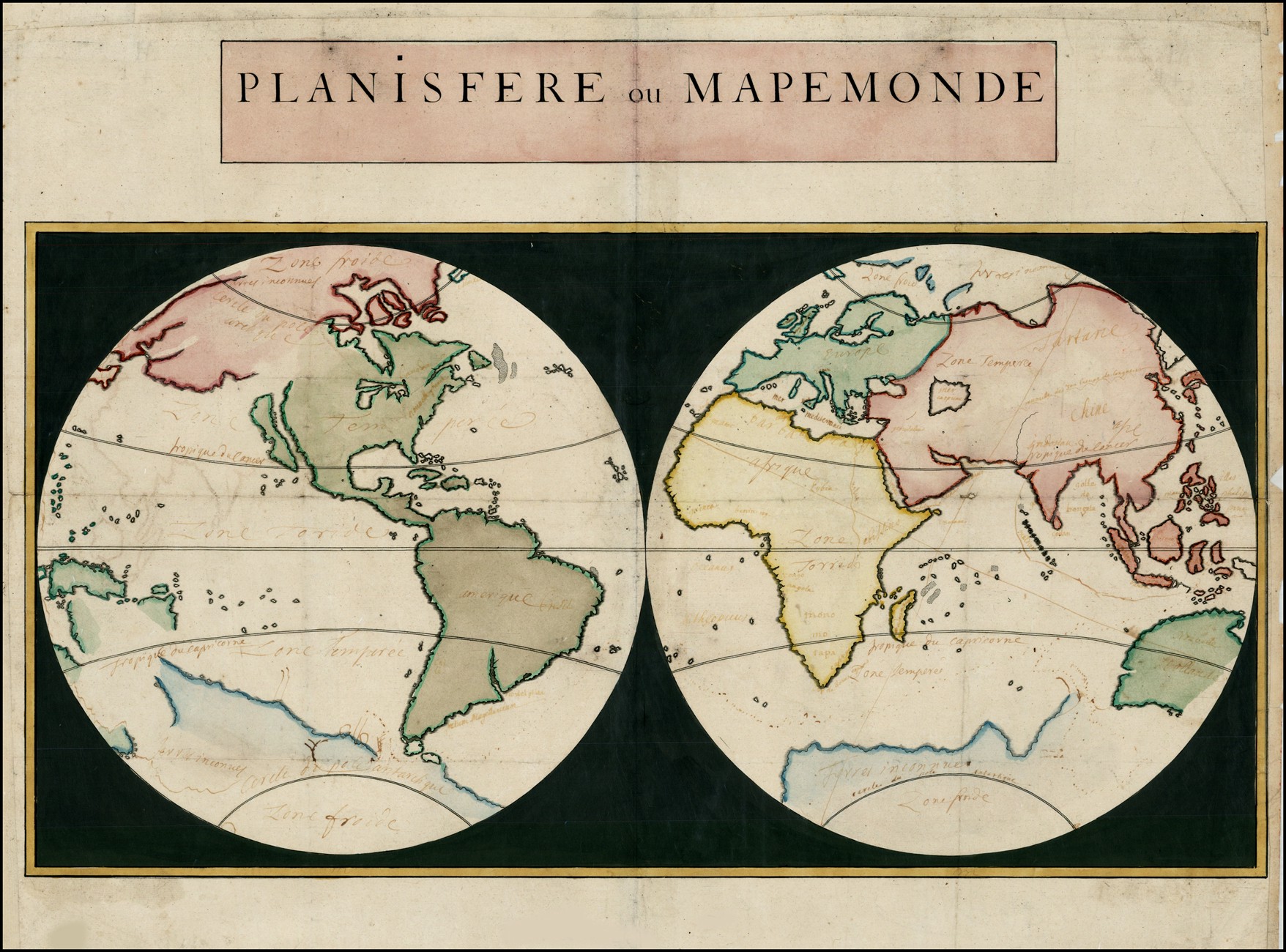
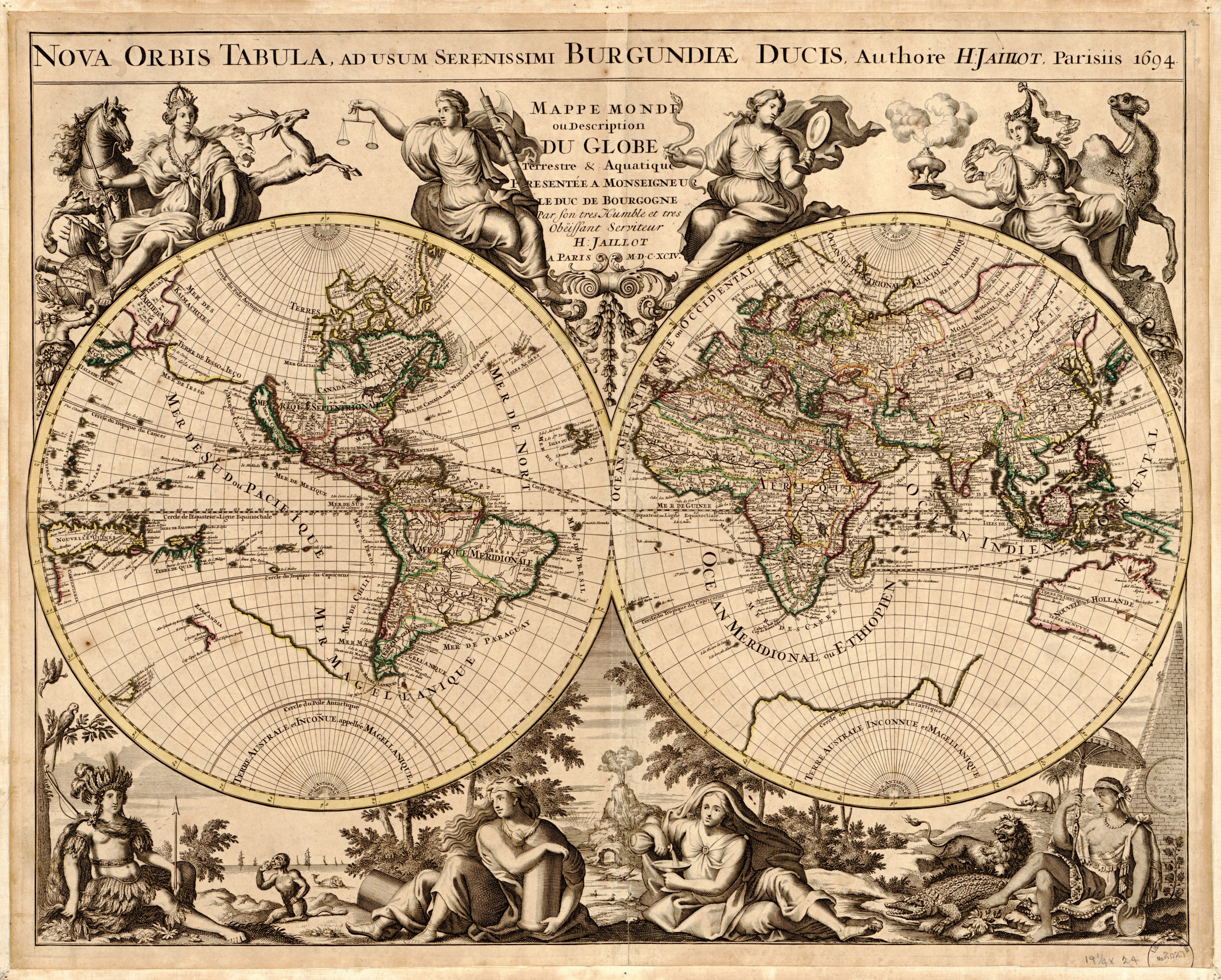
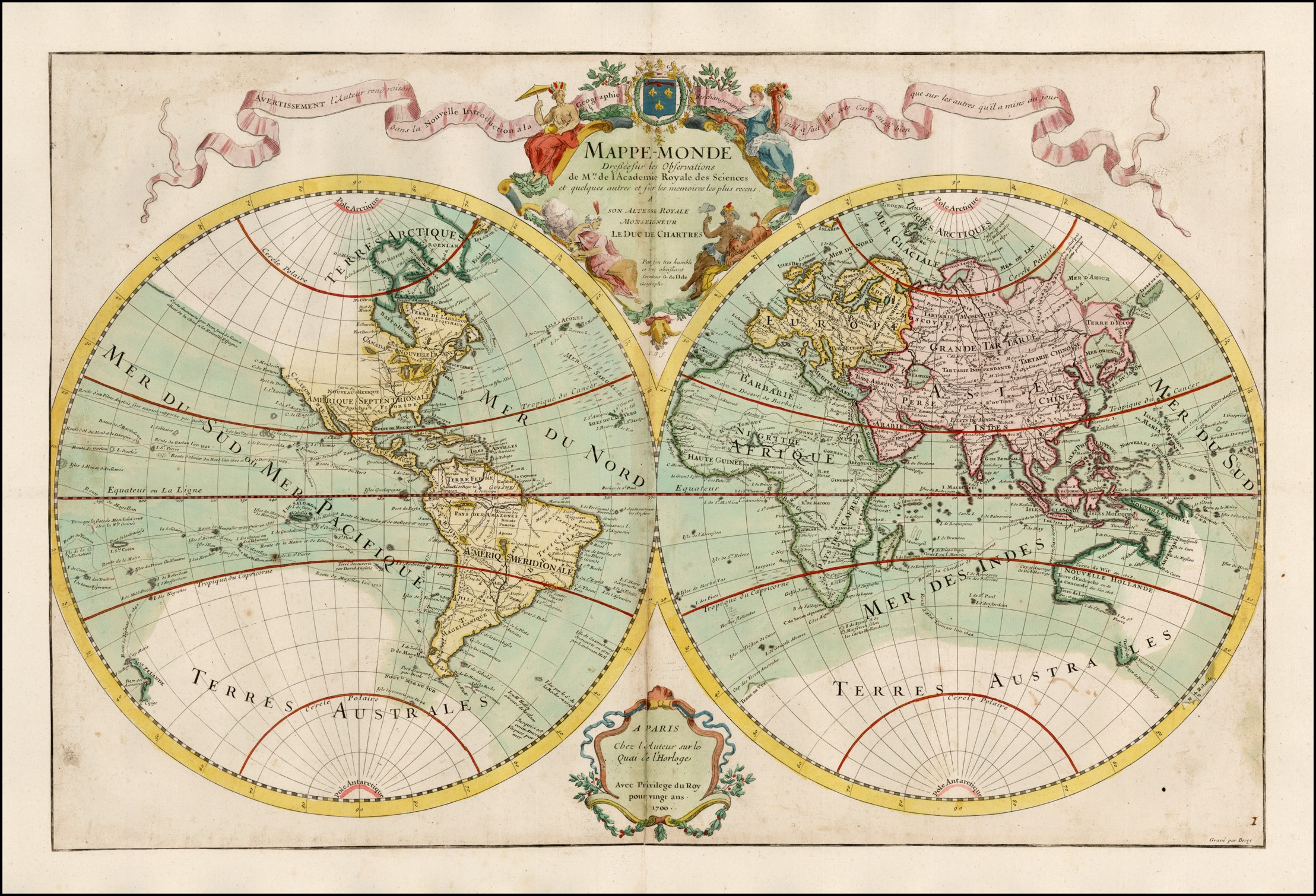
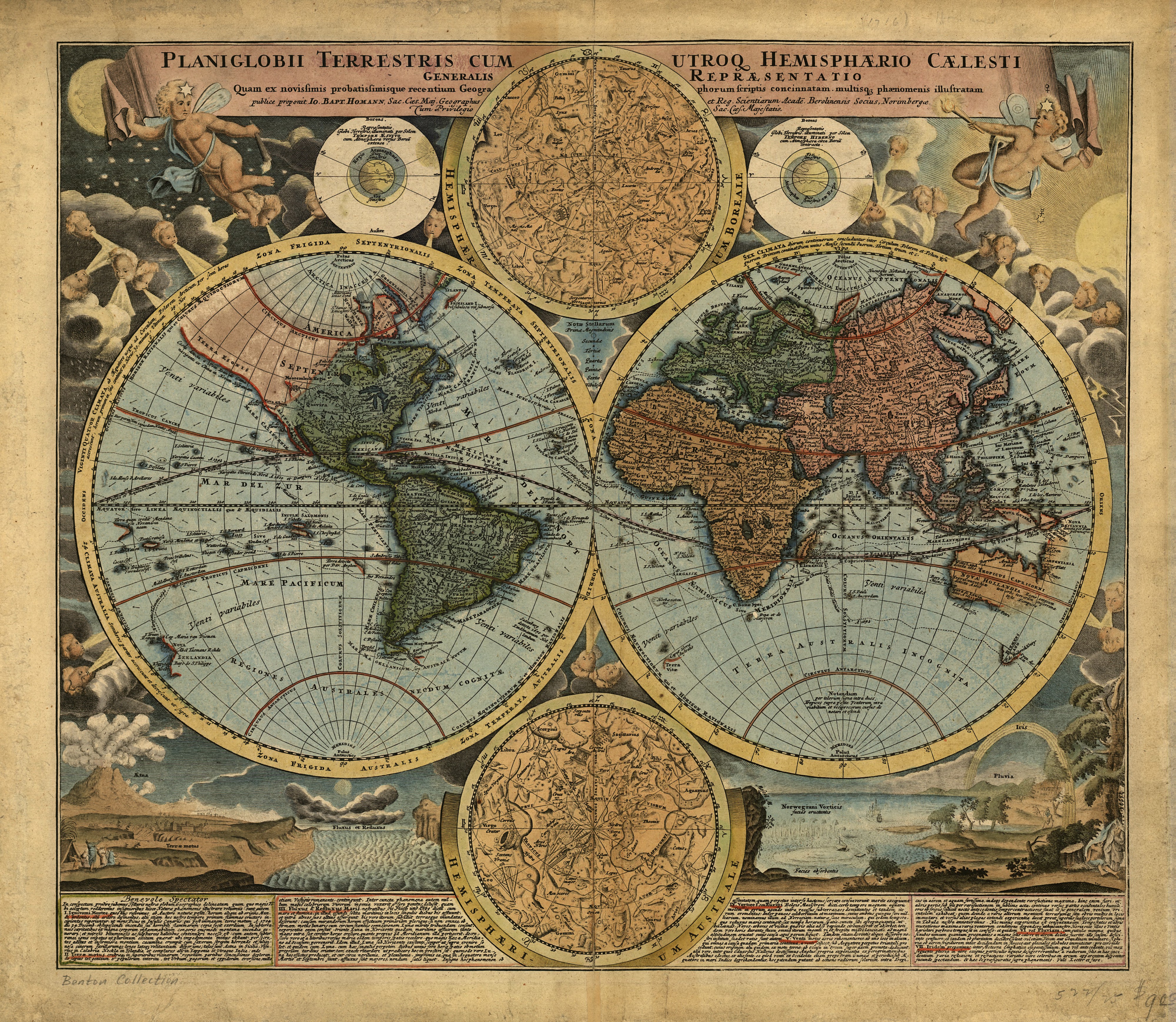
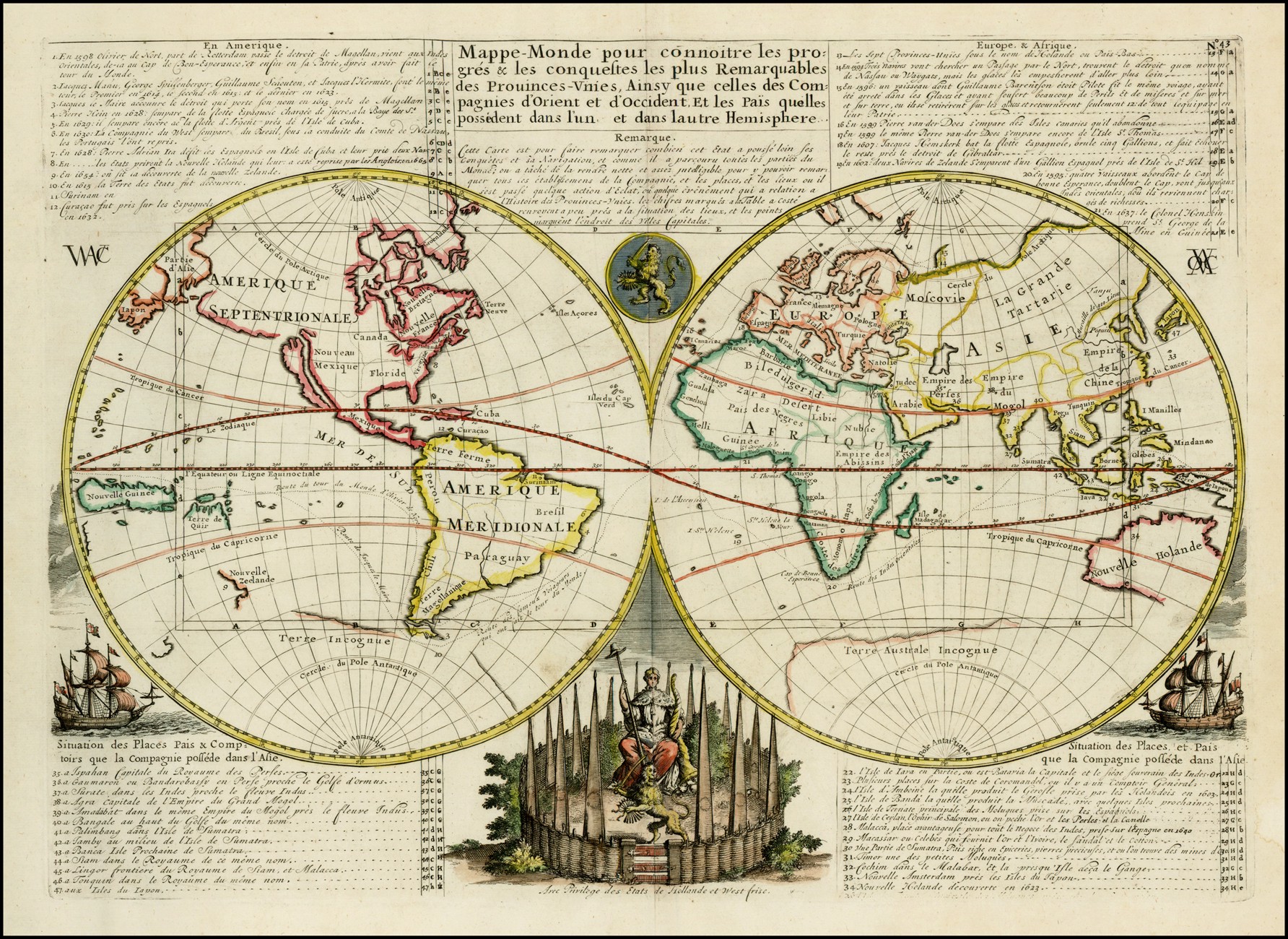
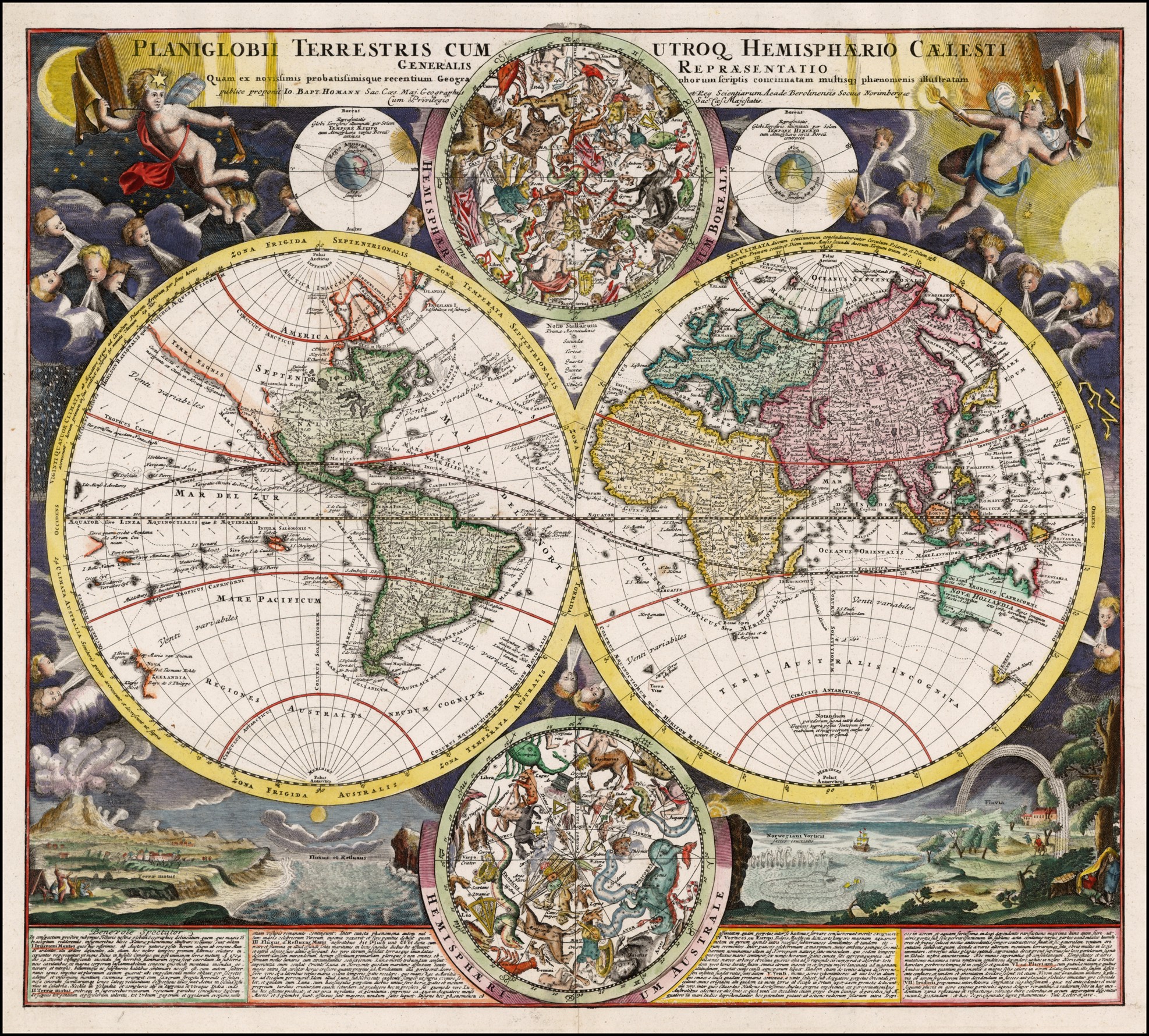
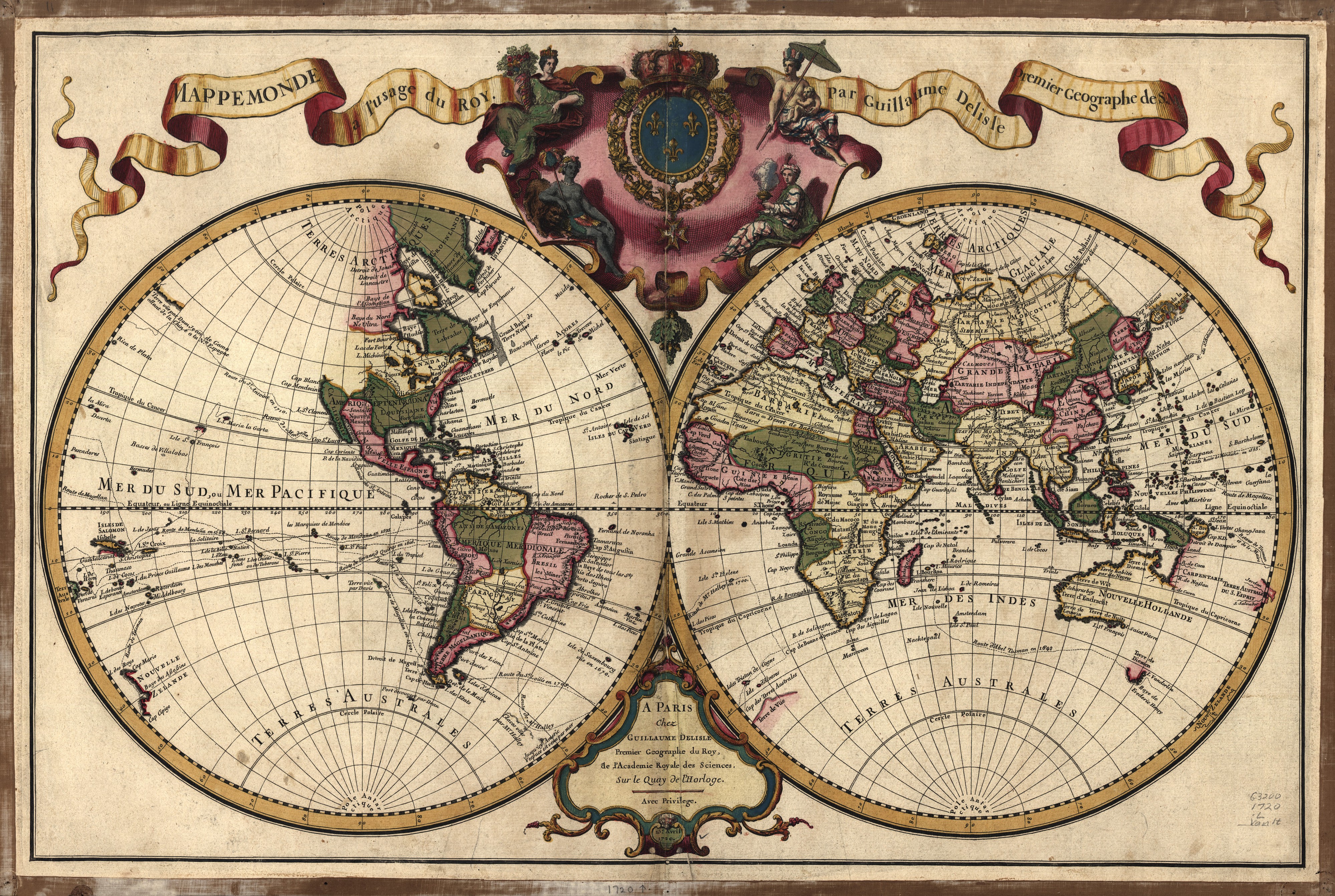
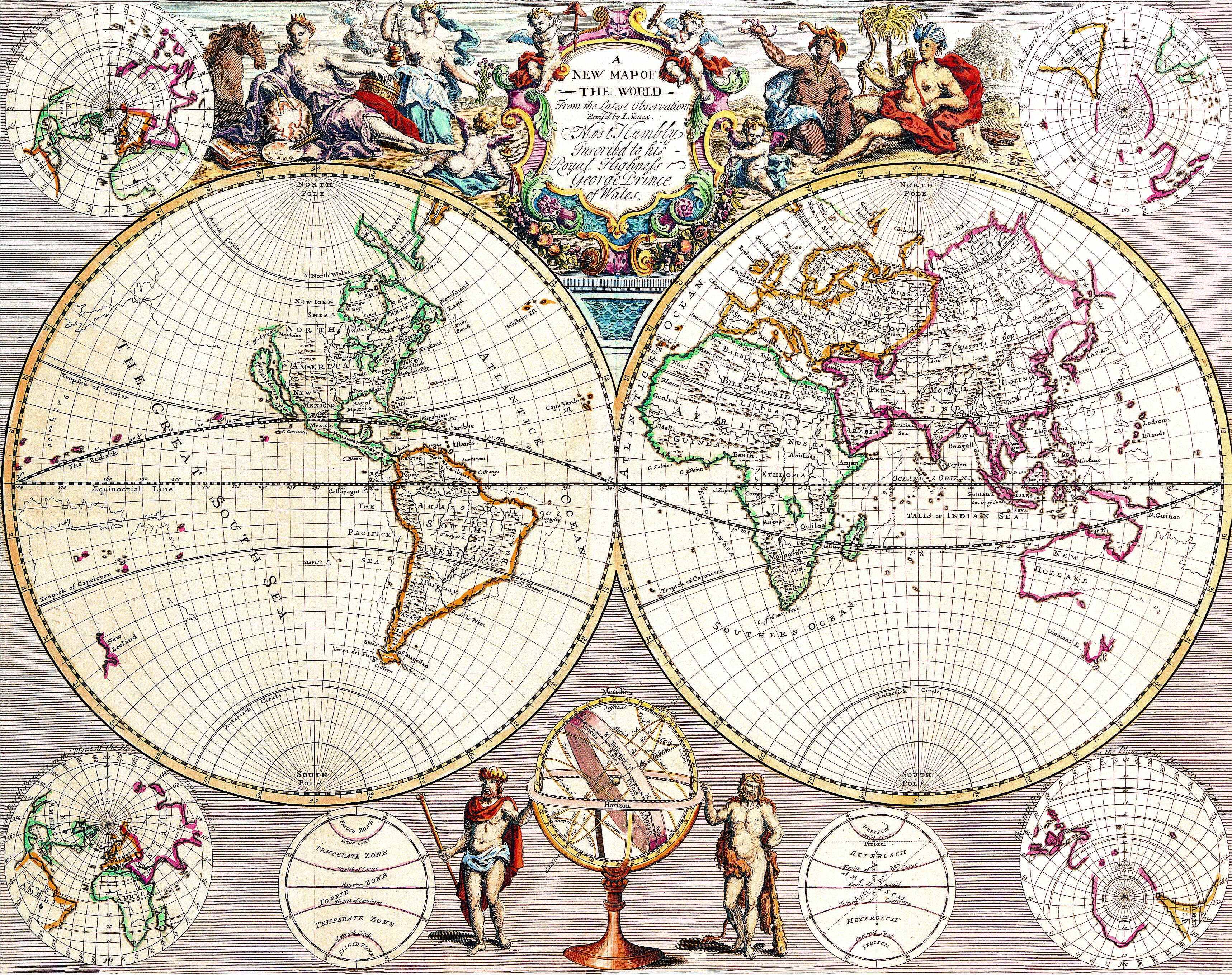
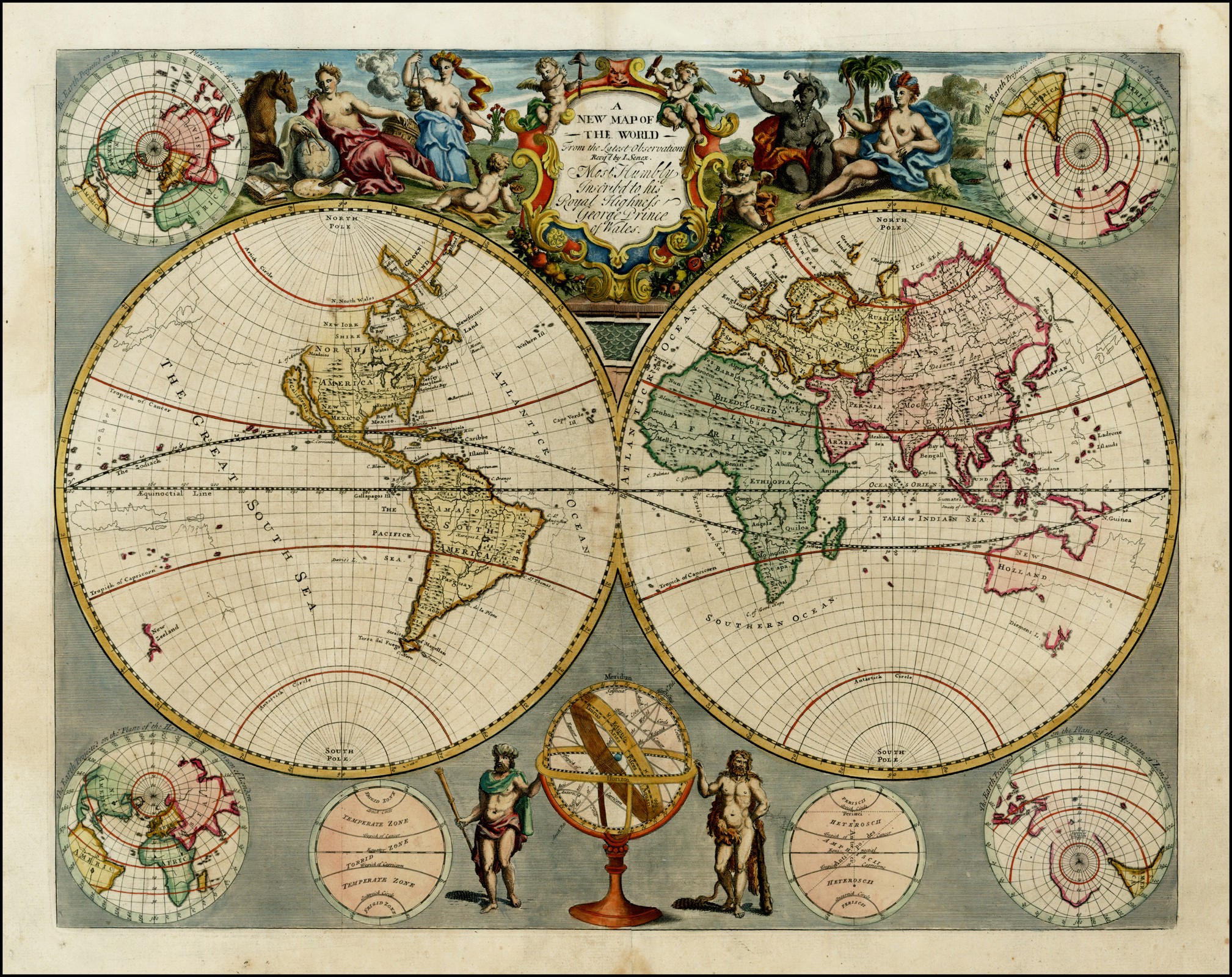
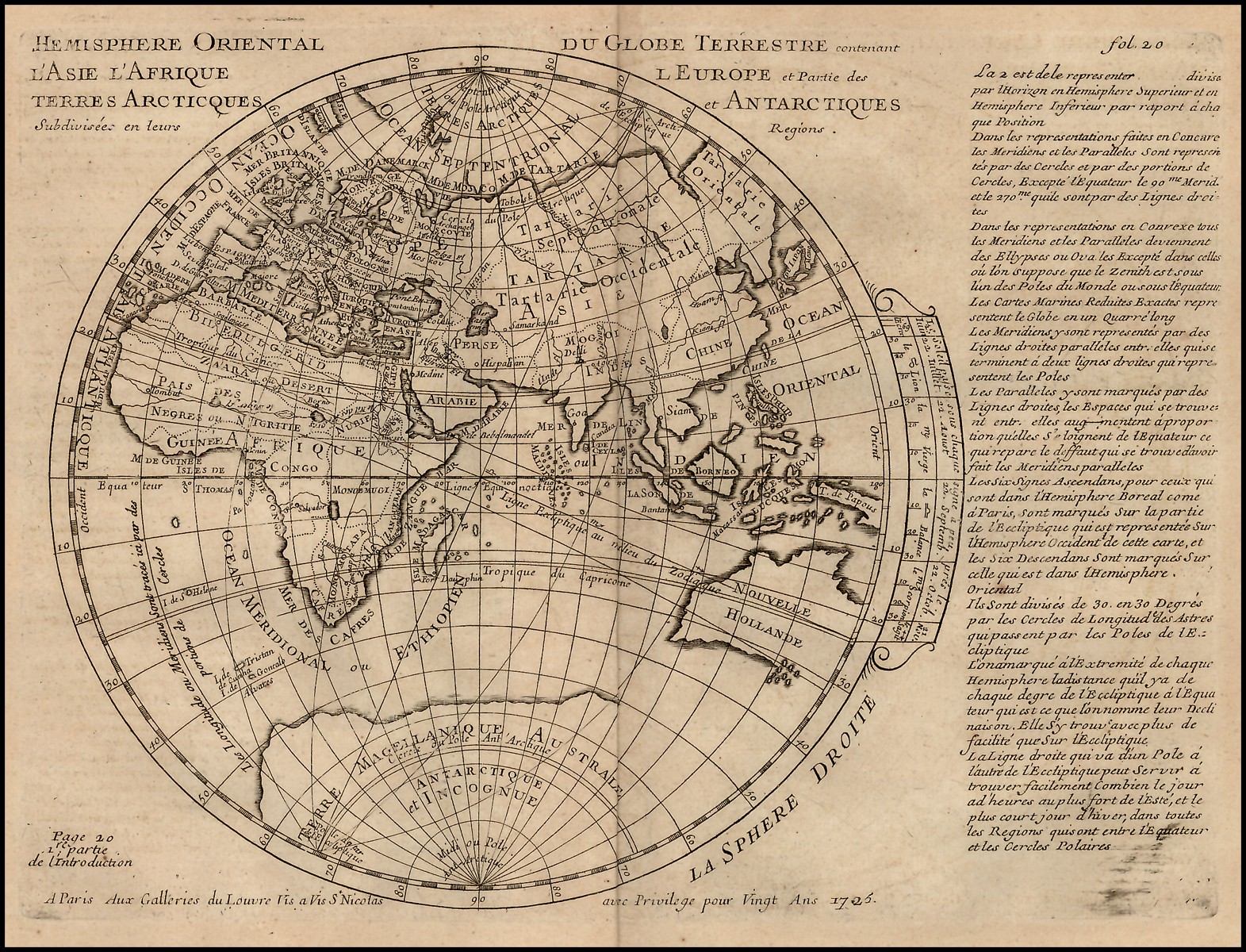
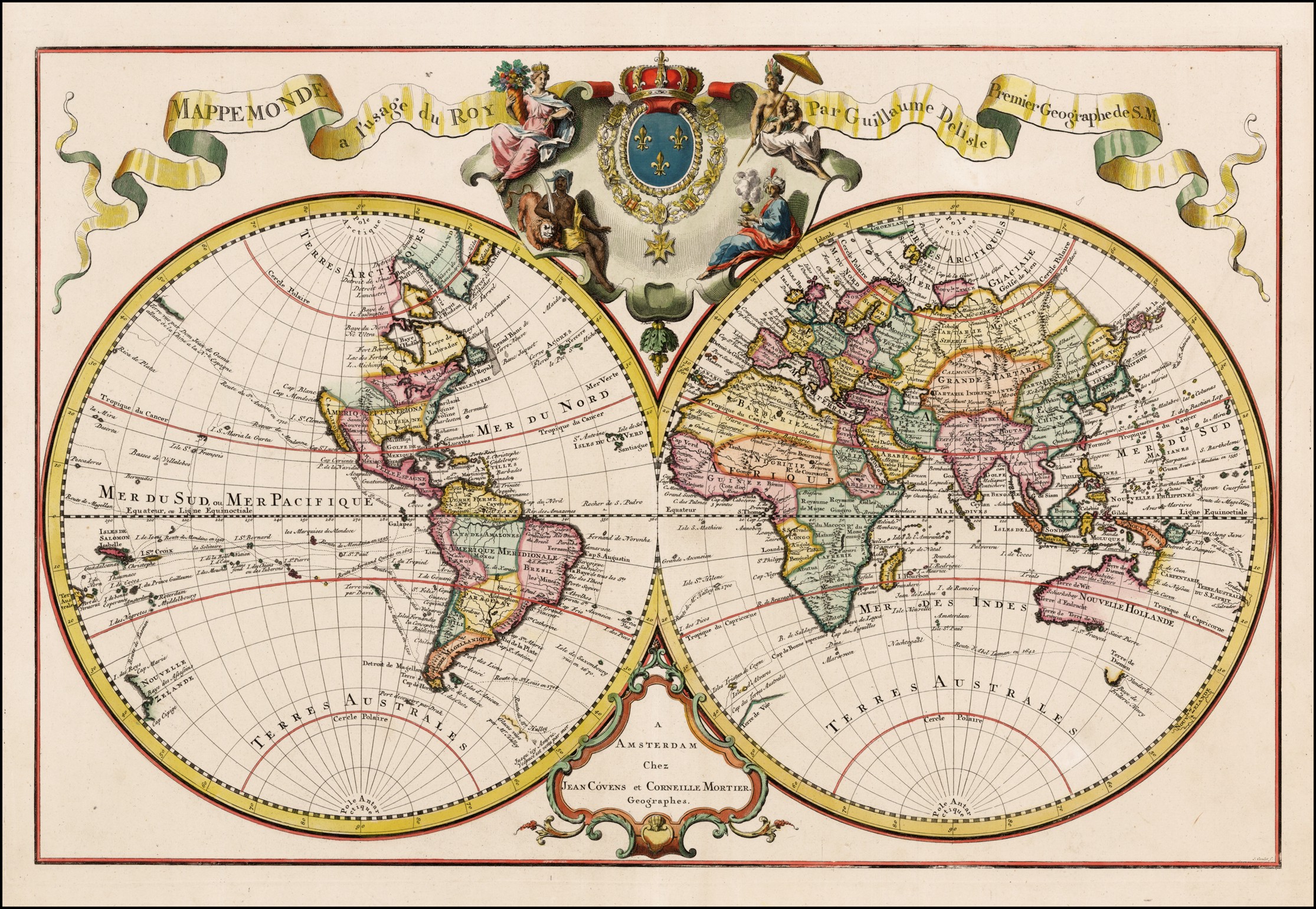
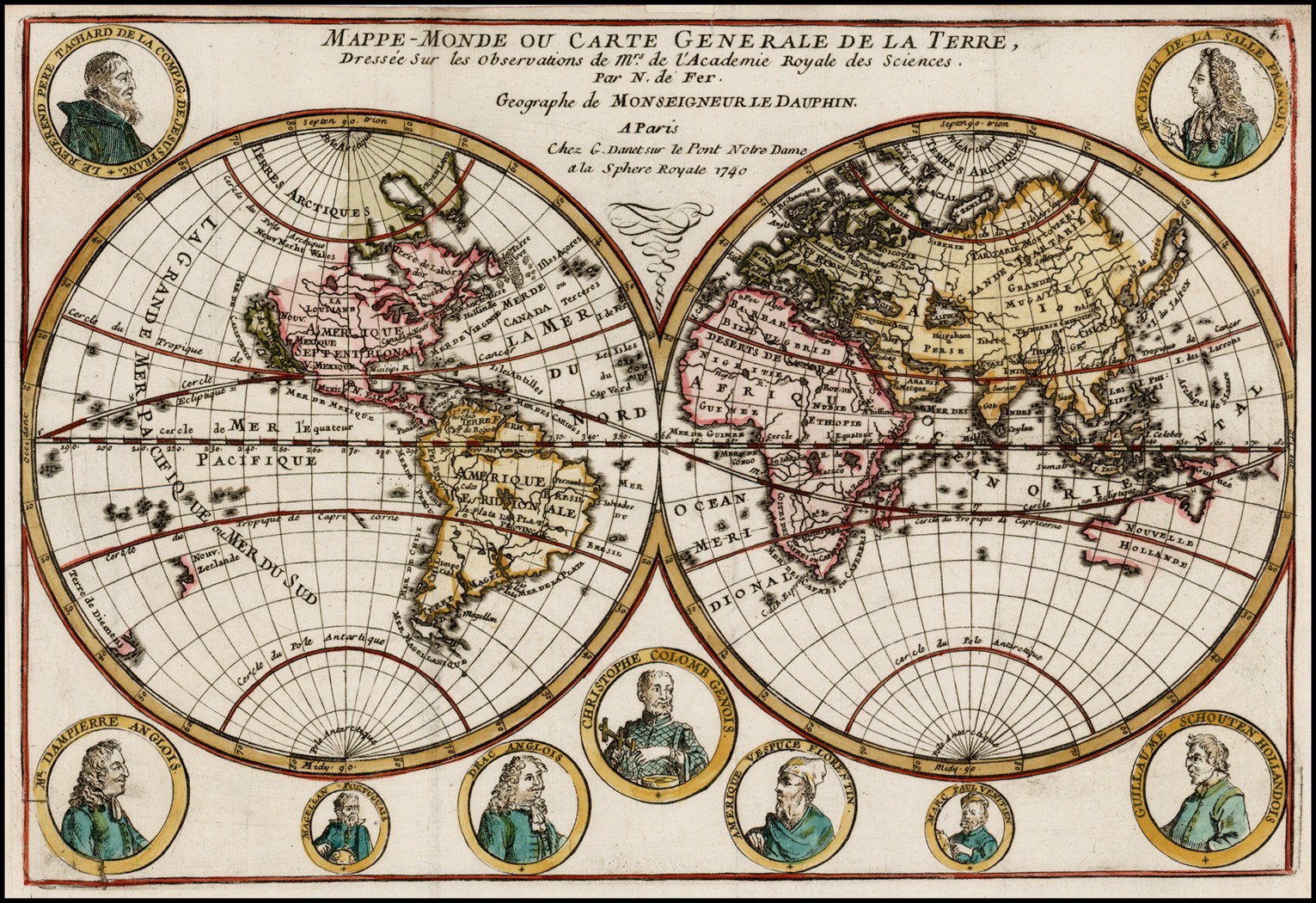
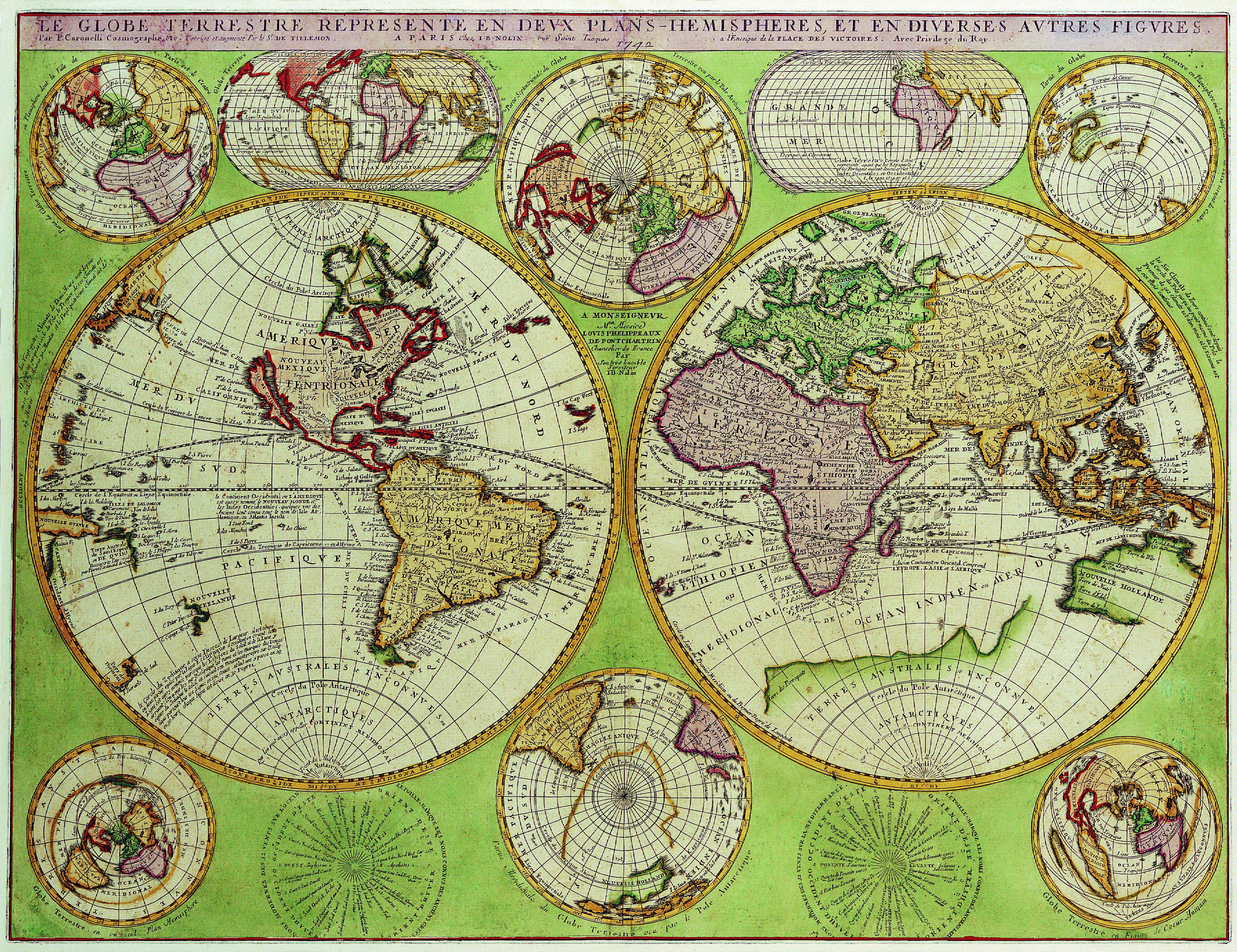
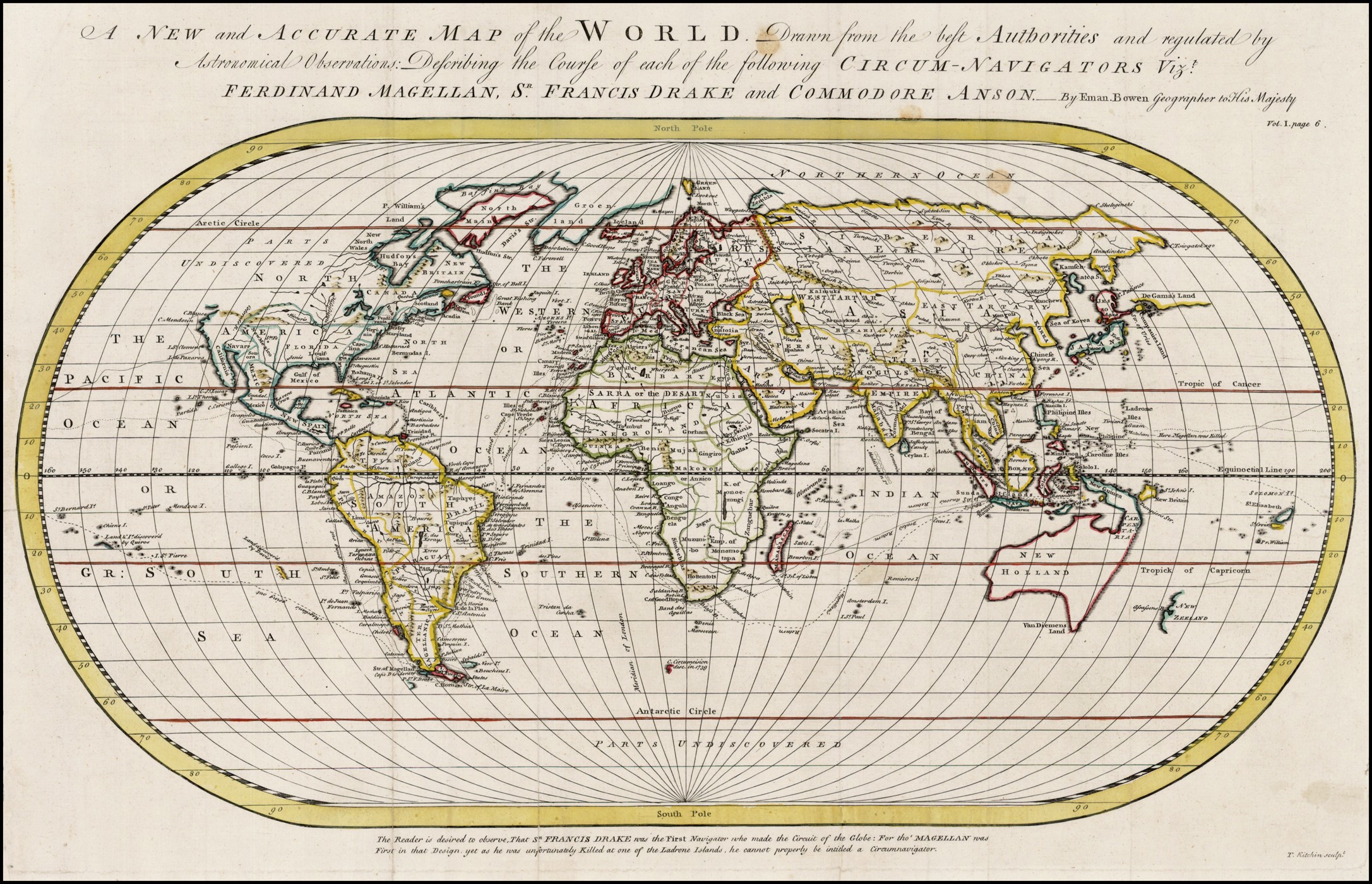
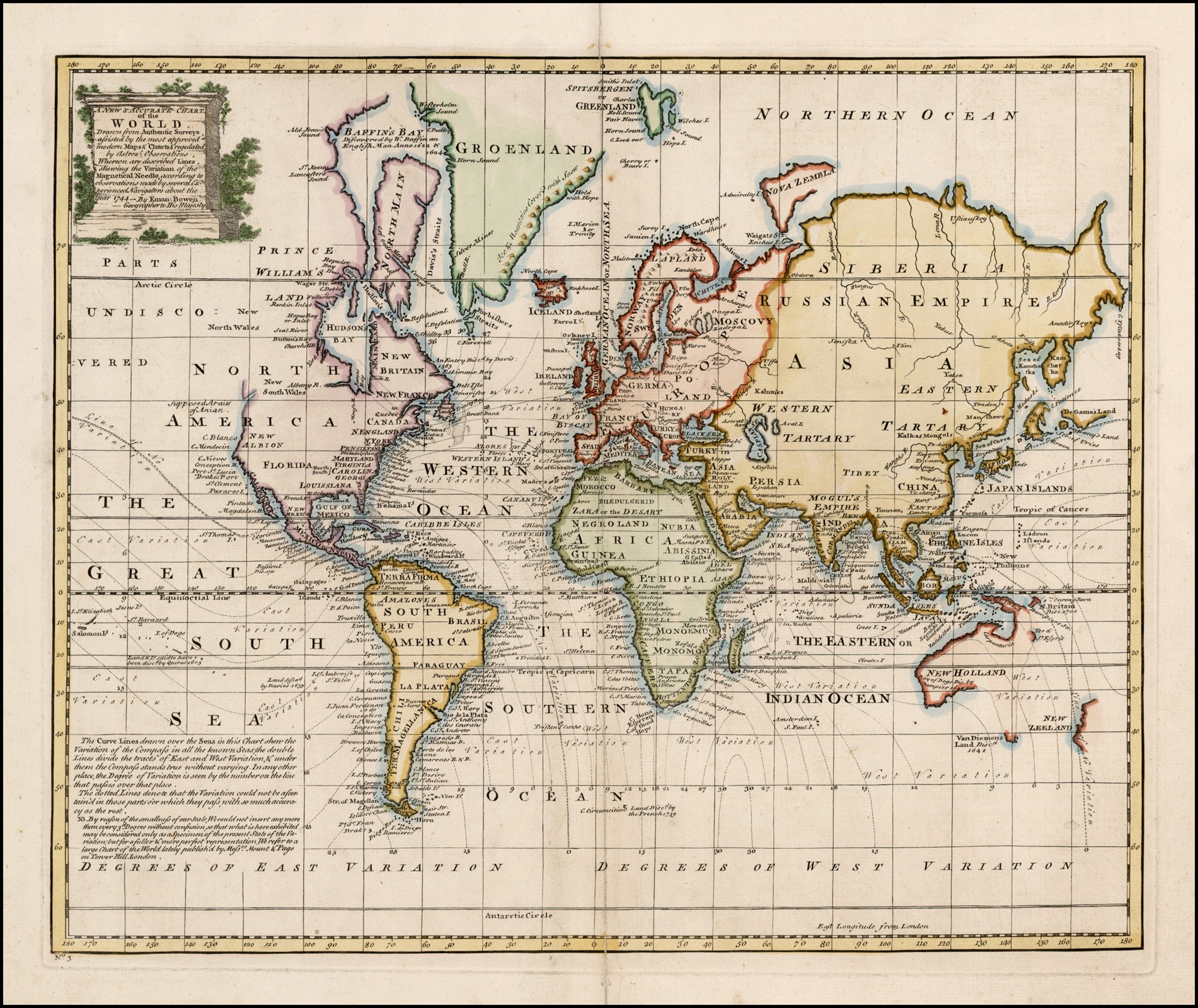
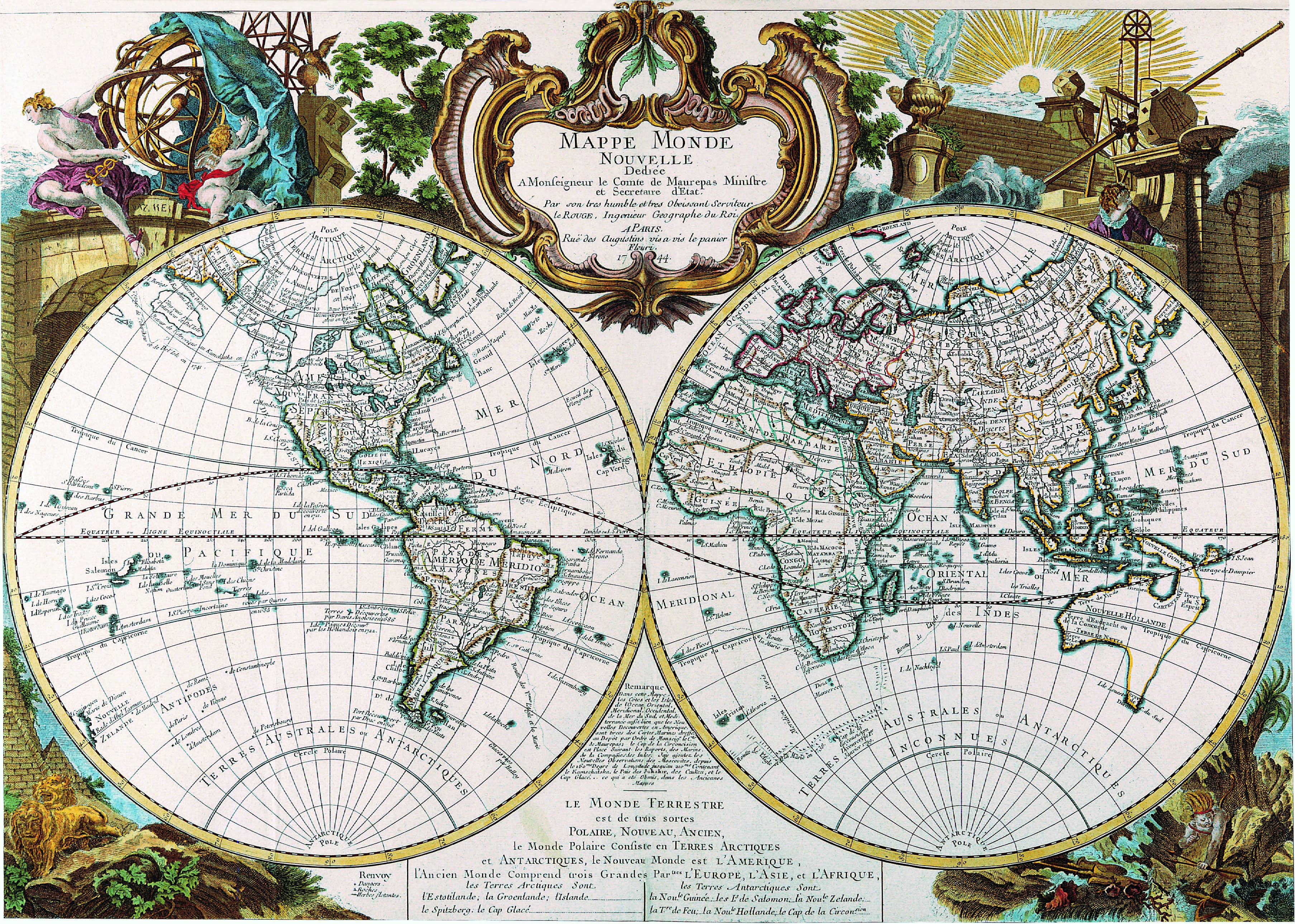
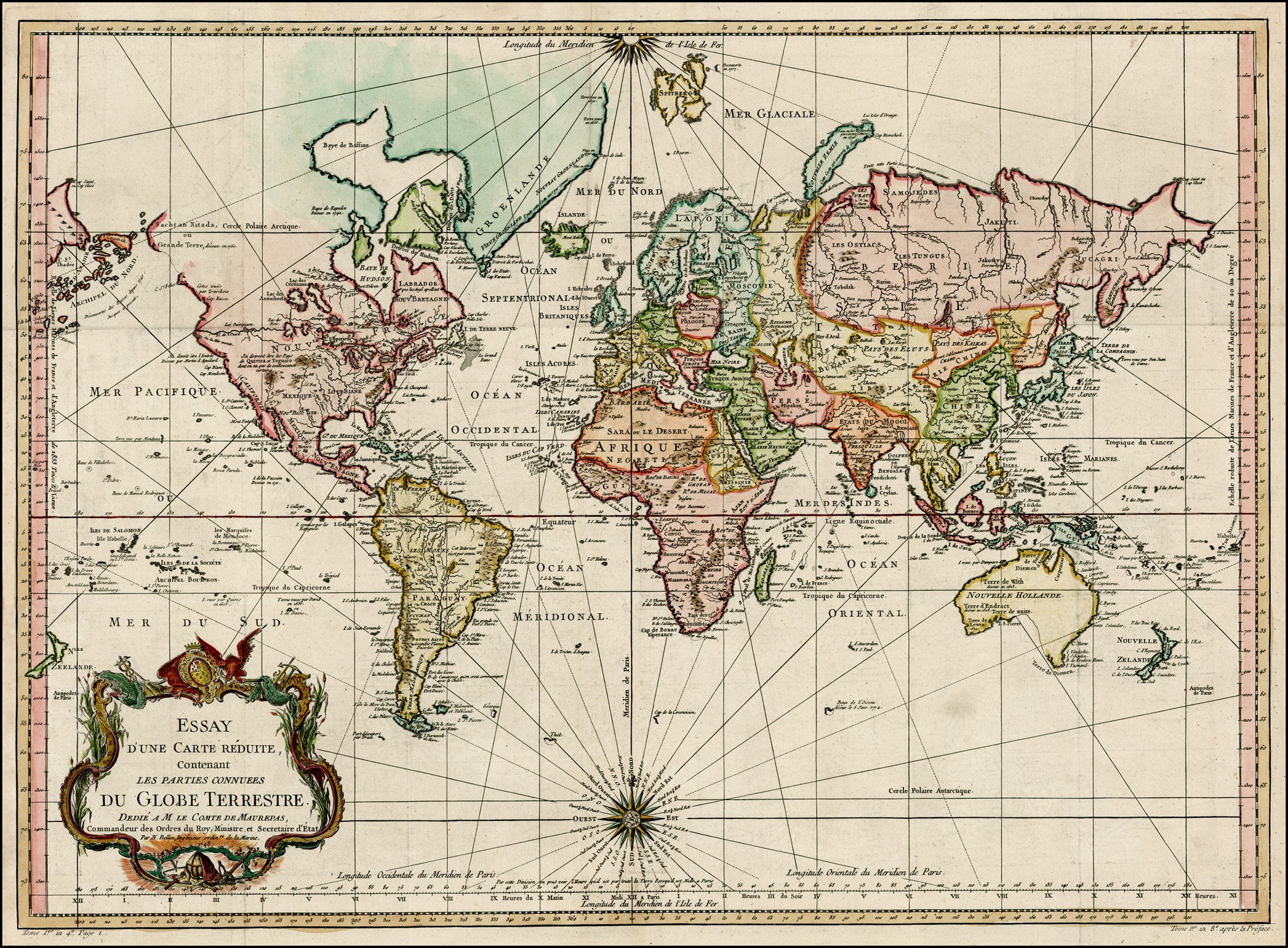
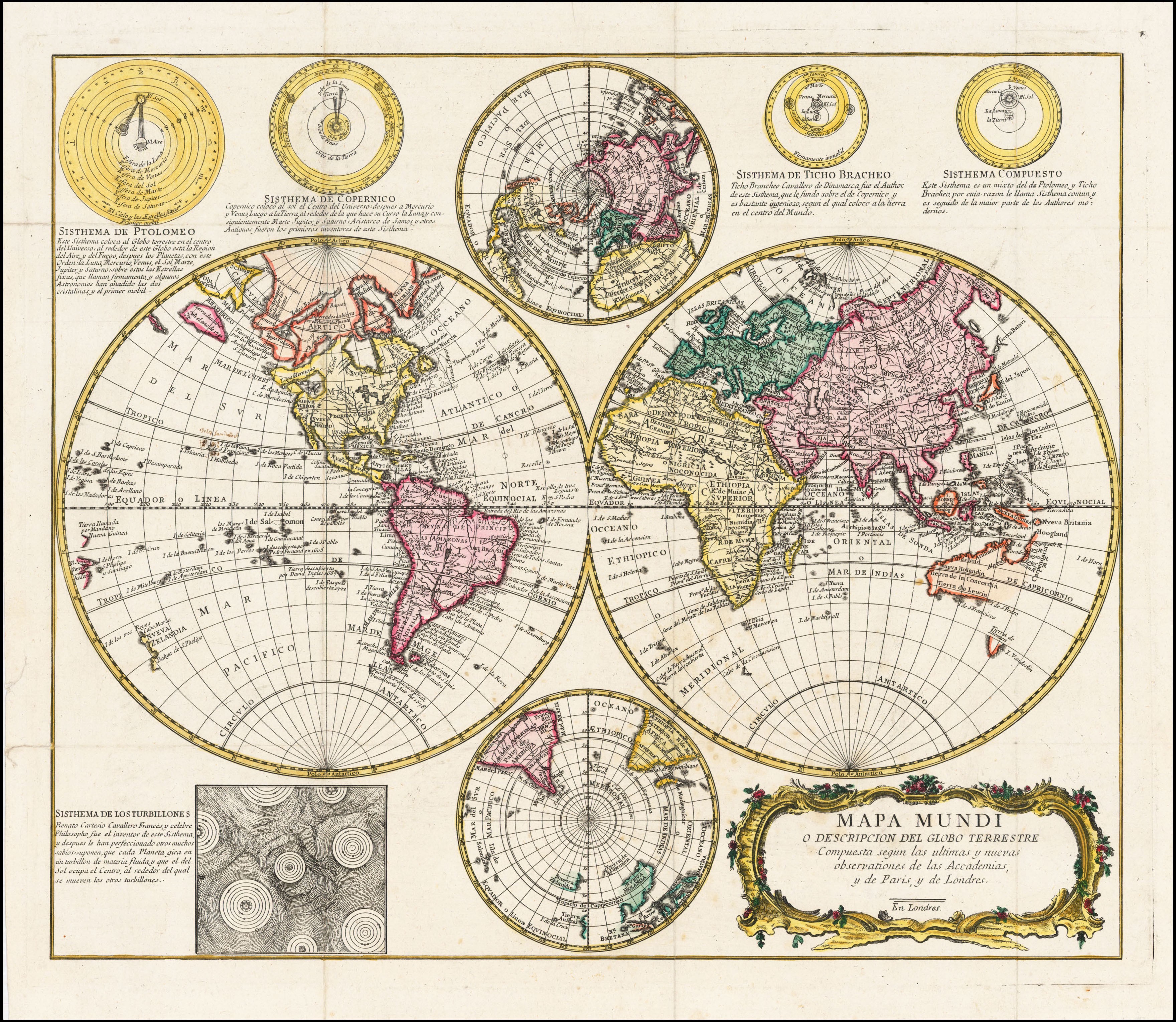
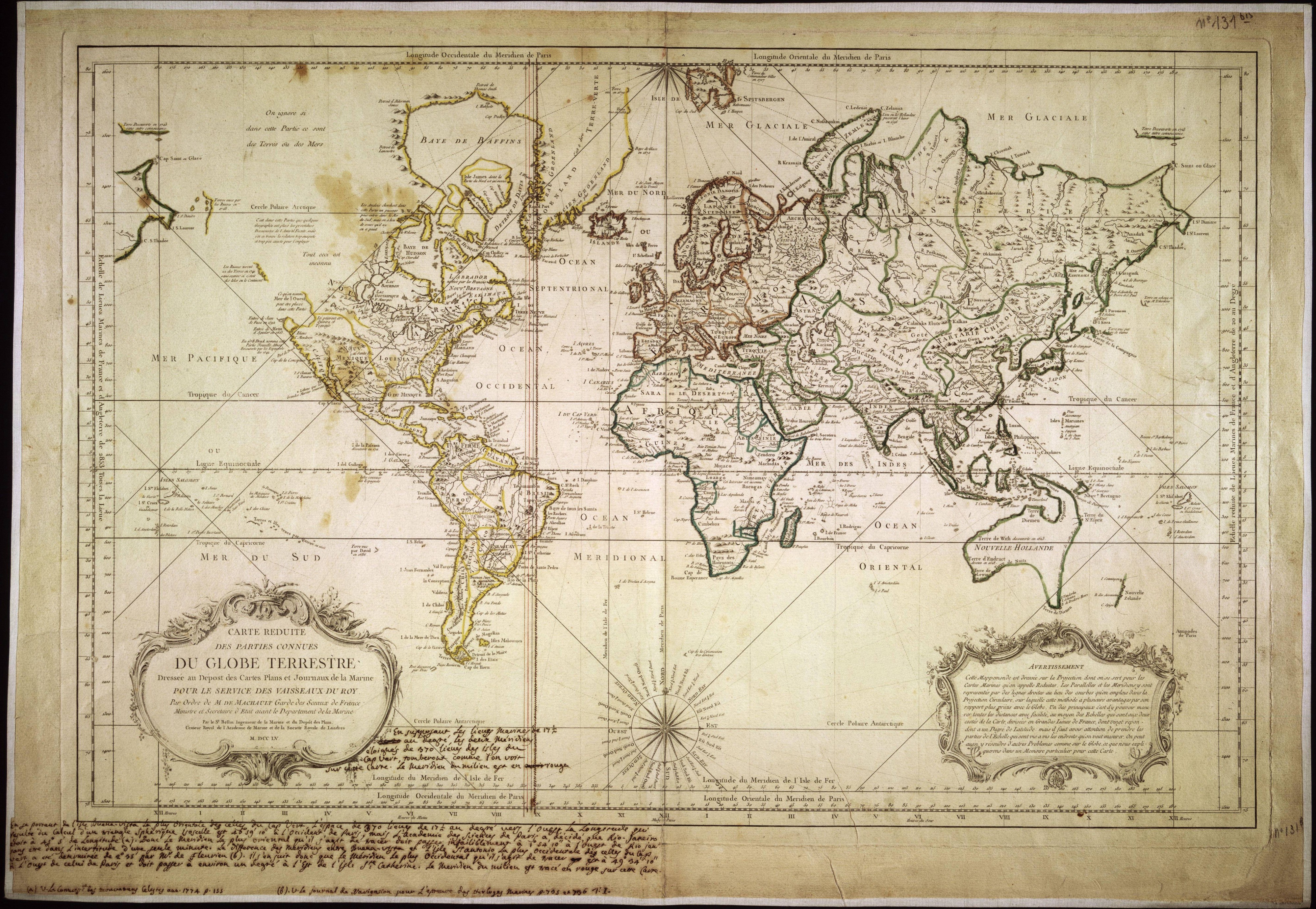
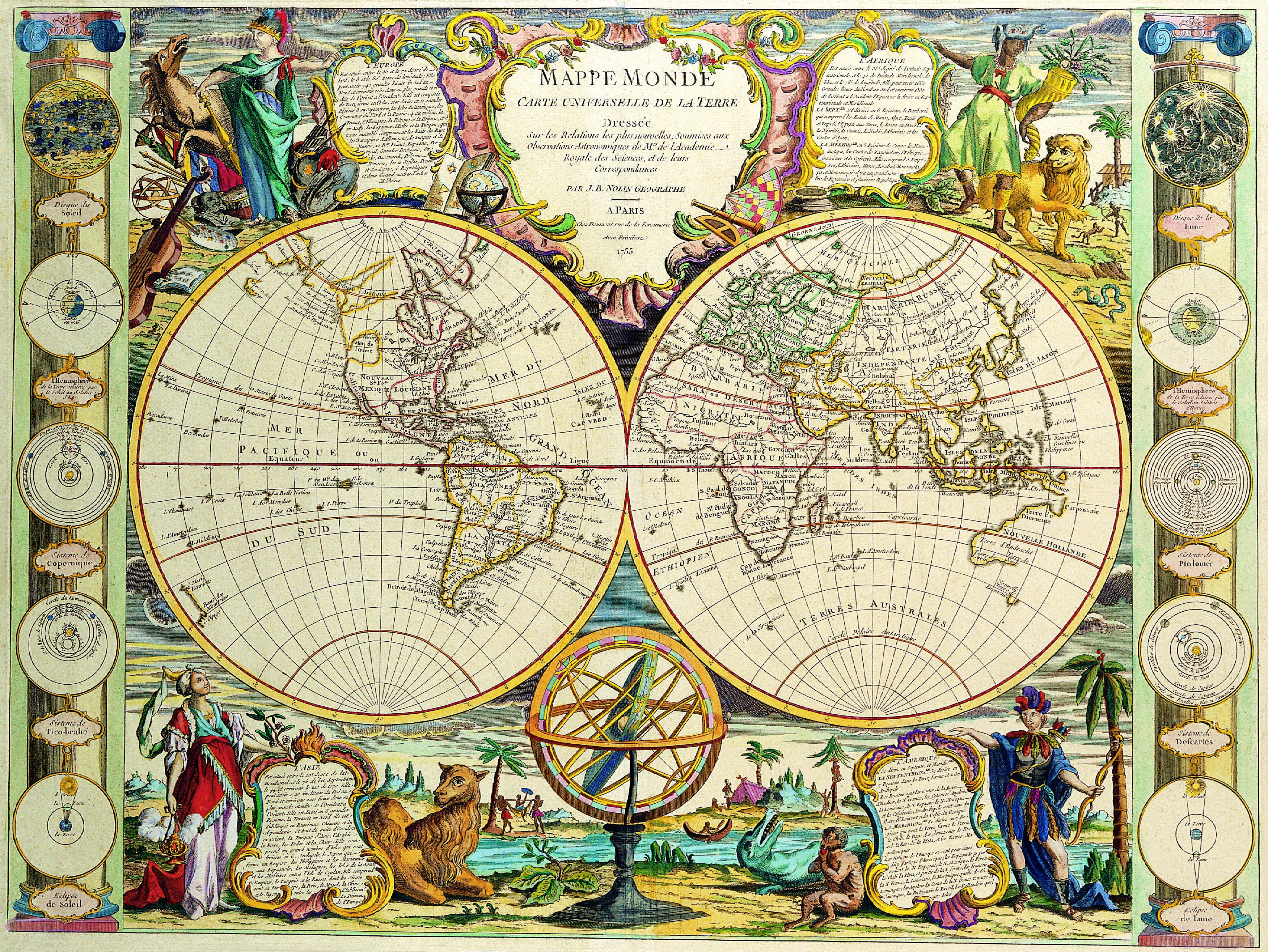
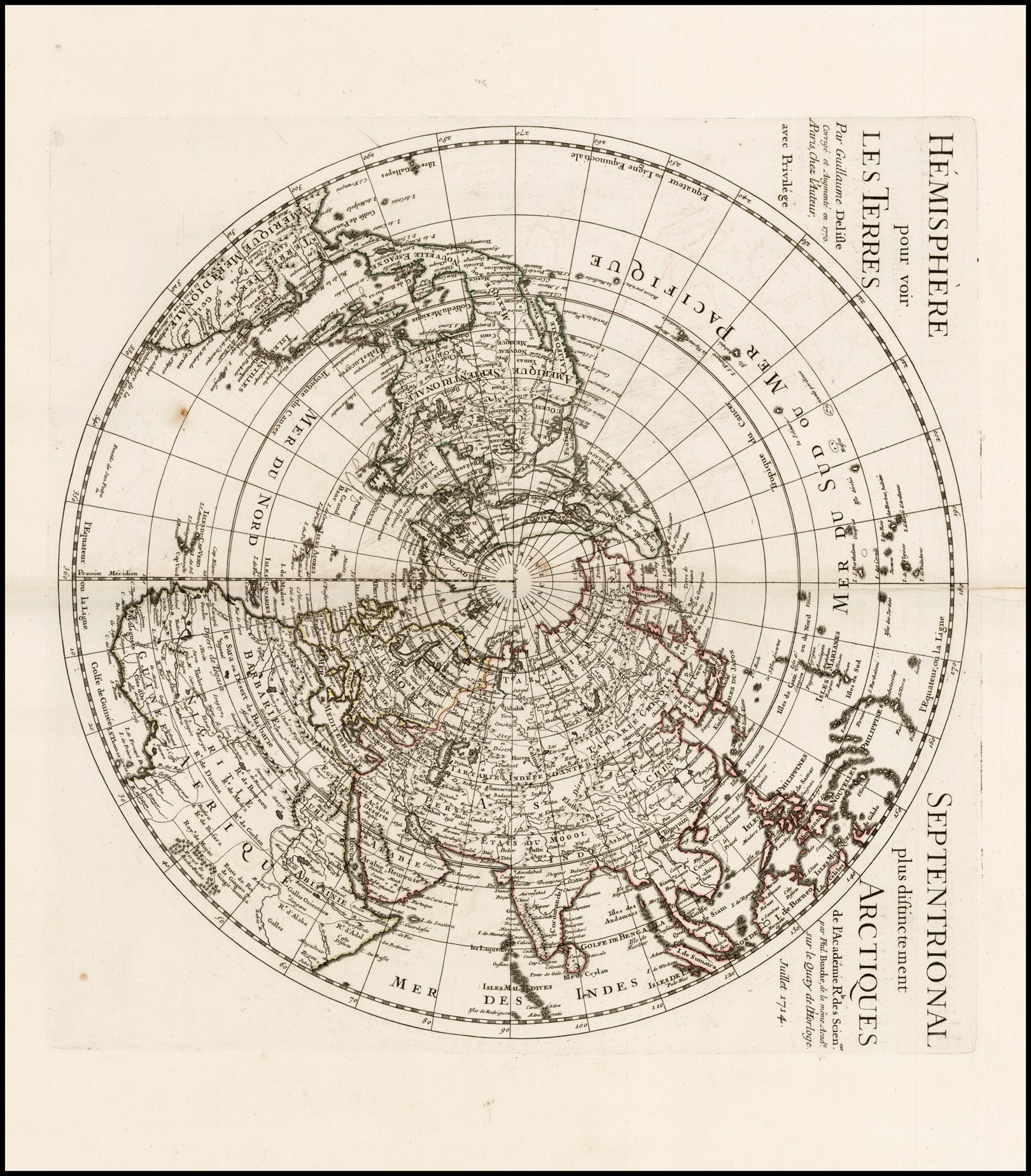
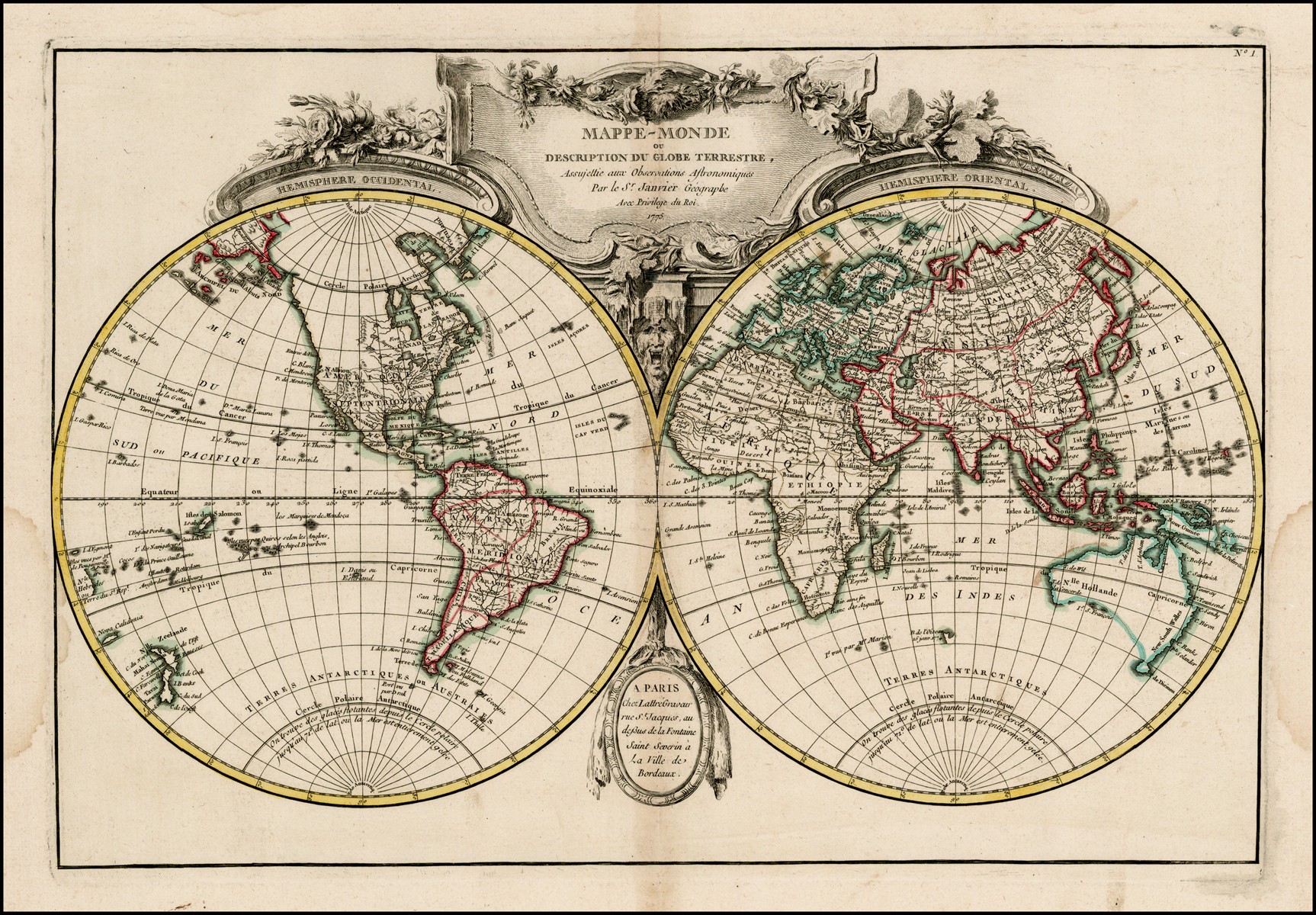
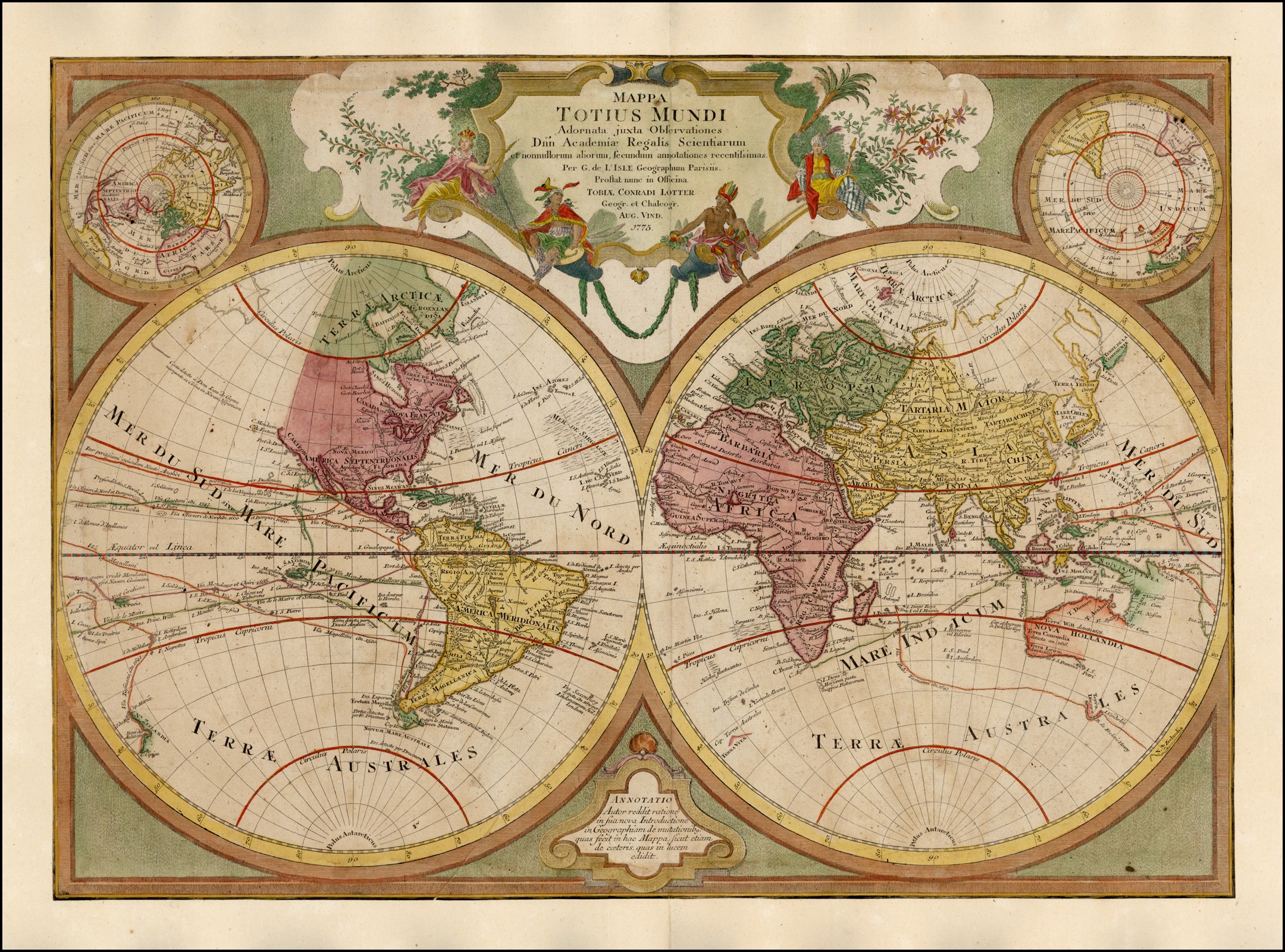
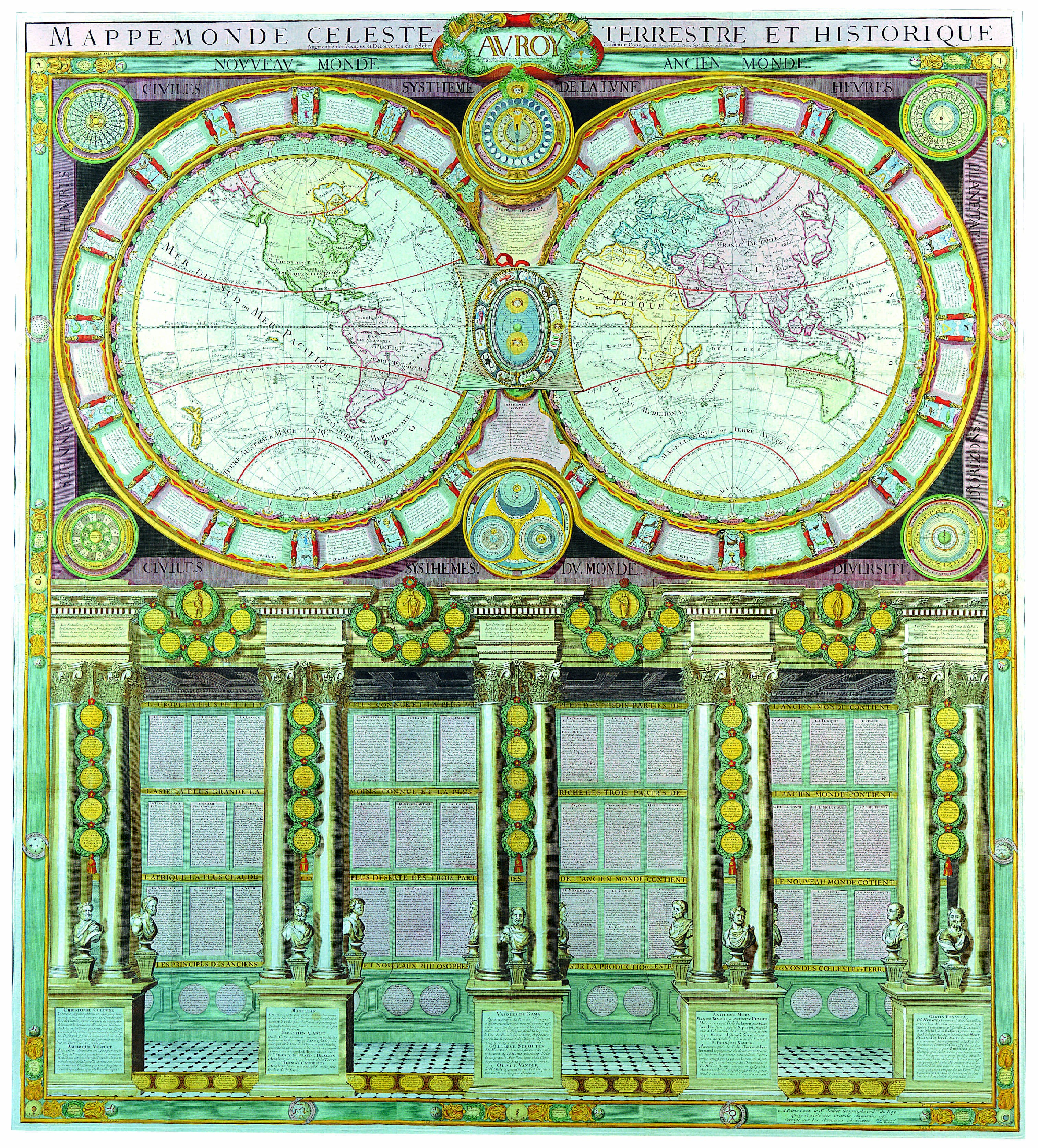
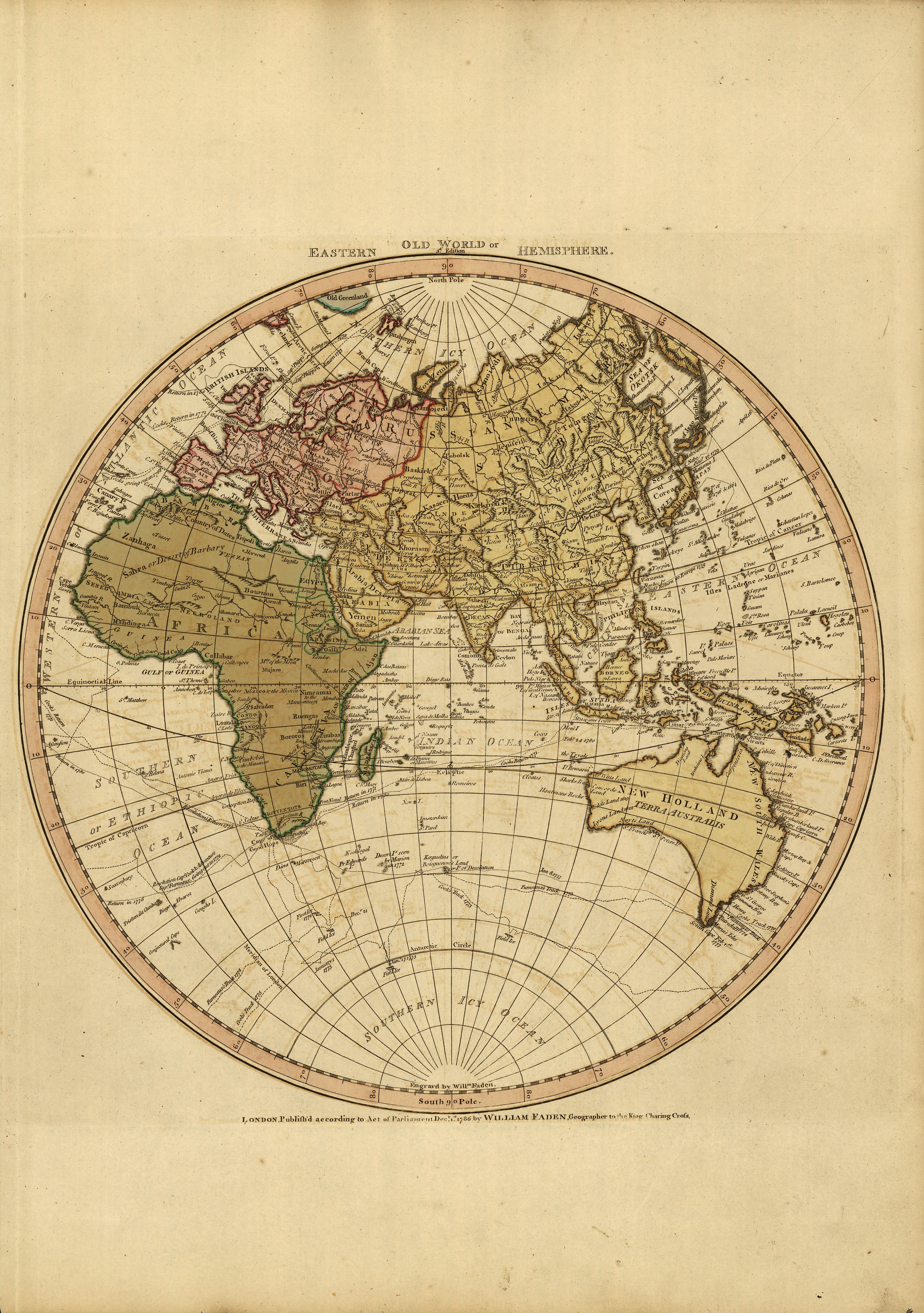
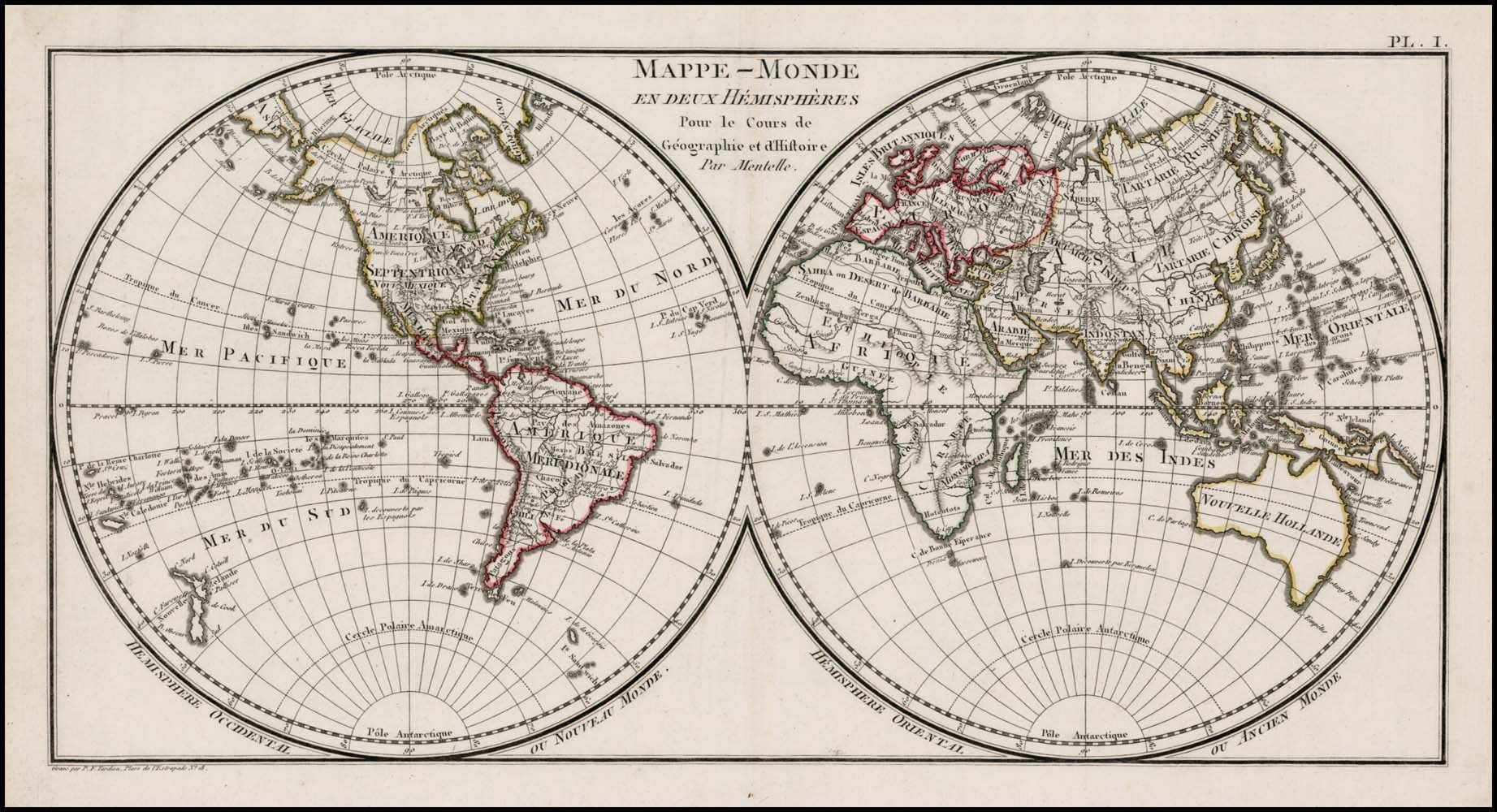
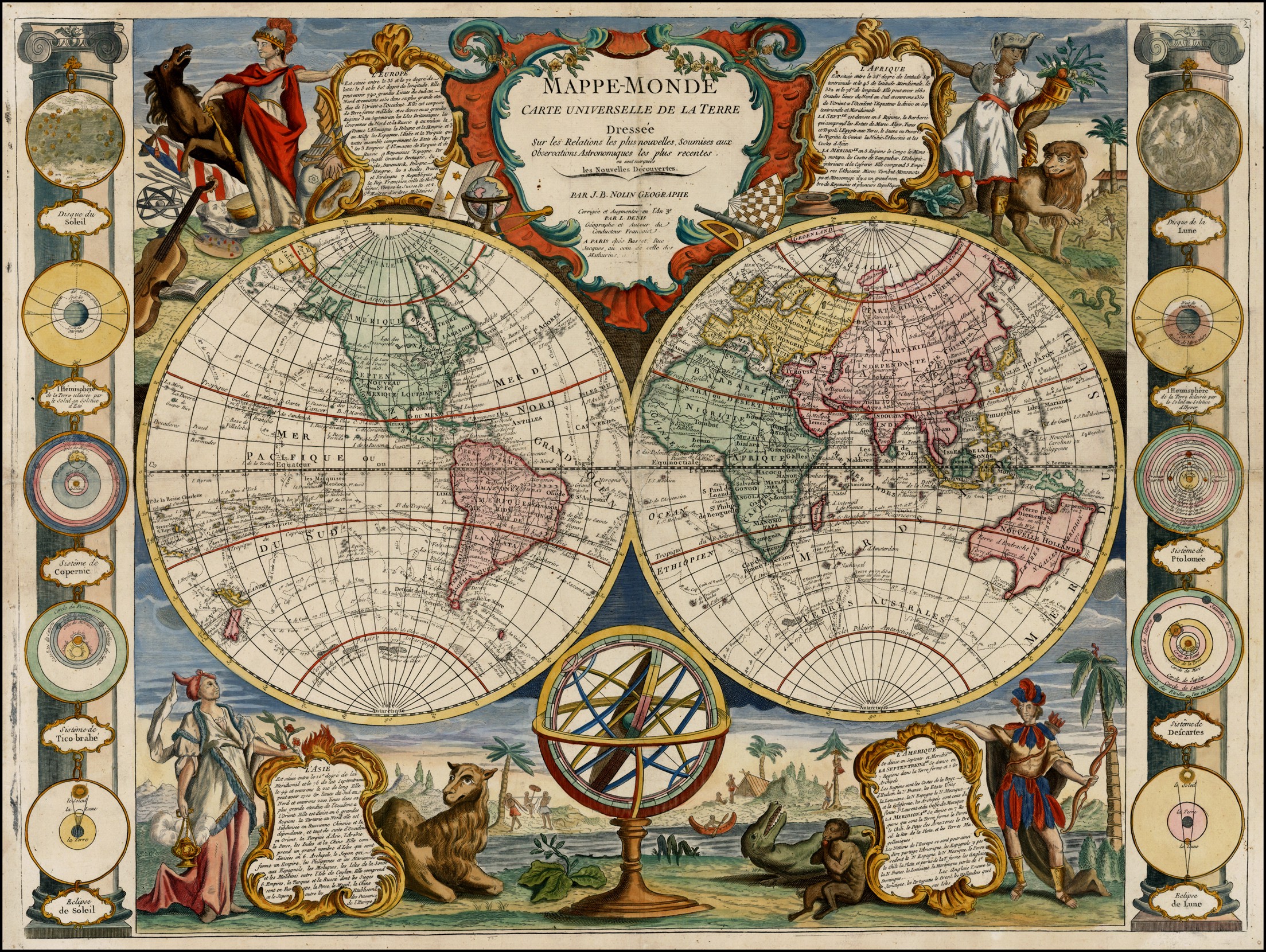
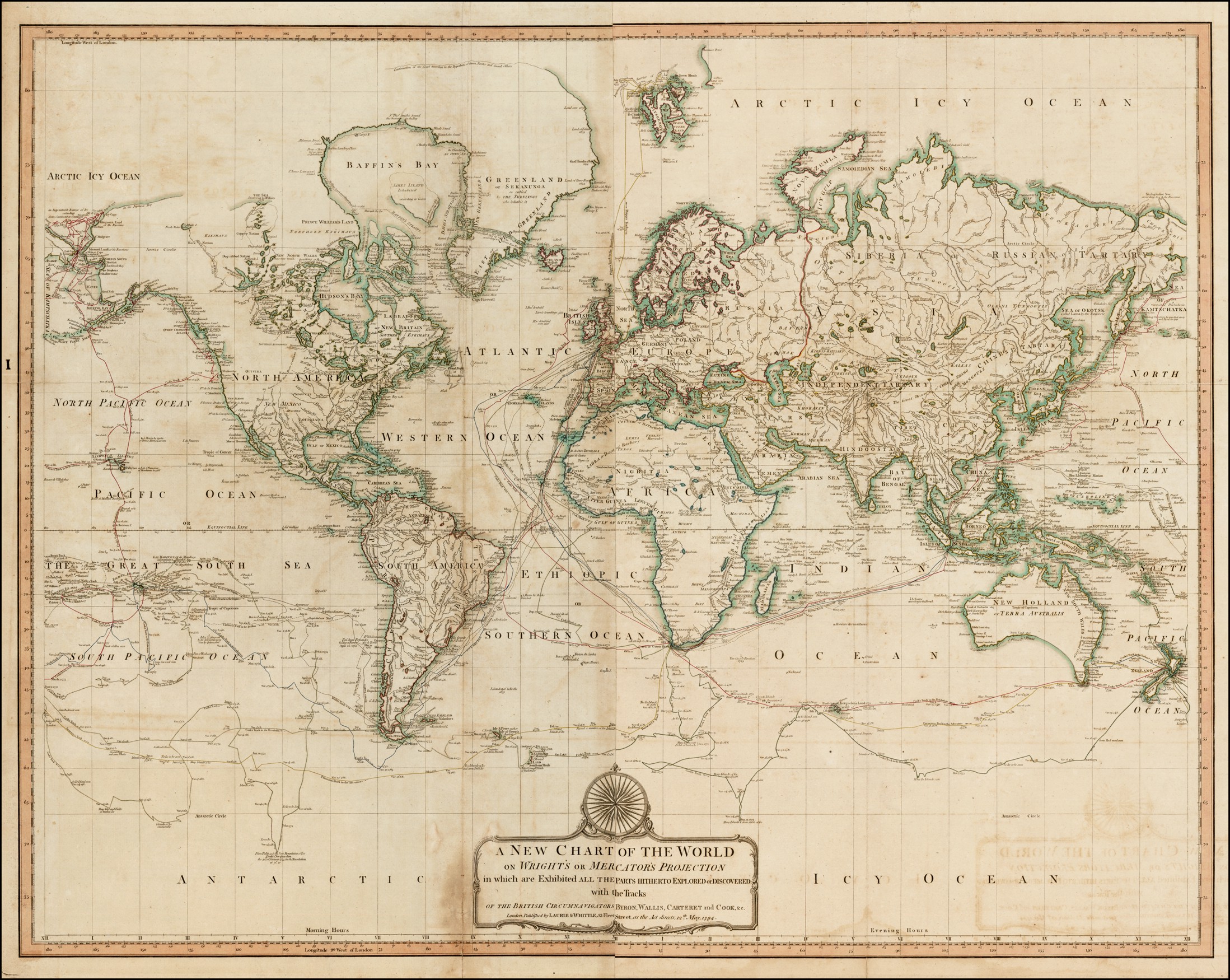
The Khanate of Khazan (1438?1552) (previously Volga Bulgaria), now named Tatarstan, a republic of the Russian Federation, had the same flag as the Empire of Tartarie.
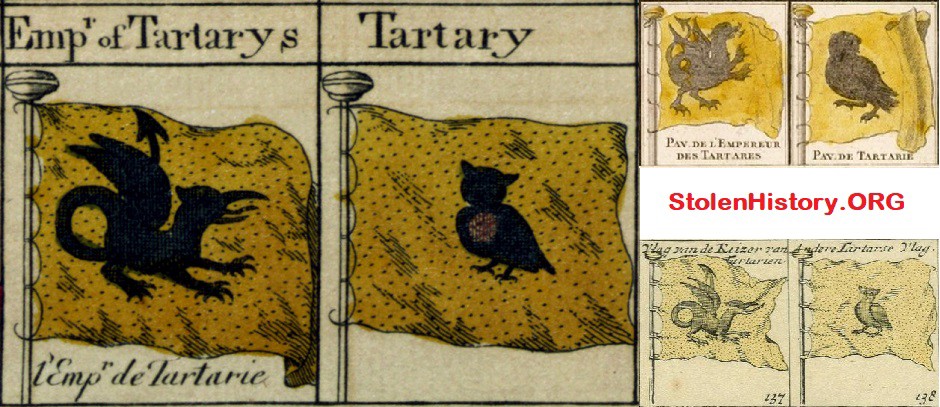
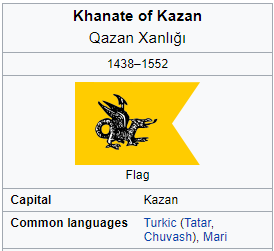 Tartary?s Flag (Source: https://www.stolenhistory.org)
Tartary?s Flag (Source: https://www.stolenhistory.org)
In a 1824 map Tataria, Chinese Tataria and China seem to co-exist on the map.
In 1850 Mongolia starts to appear where Independent Tartary was before, and China seems to be expanding and becoming an Empire.
In 1852 the Chinese Empire consists of Mongolia, China bordering with Tartary on the west and the Russian empire on the north.
According to a 1875 map, Independent Tartary is located east of the Caspian sea, where modern Turkmenistan, Tajikistan and Uzbekistan are. They belong to the larger area of Turkestan.
Turkestan, also spelled Turkistan (Persian: ????????, romanized: Torkestn, lit. ?Land of the Turks?), is a historical region in Central Asia between Ural and Siberia to the north; the Gobi Desert to the east; Tibet, Kashmir, Afghanistan, and Iran to the south; and the Caspian Sea to the west.
Turkestan includes present-day Kazakhstan, Kyrgyzstan, Tajikistan, Turkmenistan, Uzbekistan, the Tarim Basin of China (also known as East Turkestan), and parts of northern Afghanistan (known as Afghan Turkestan).
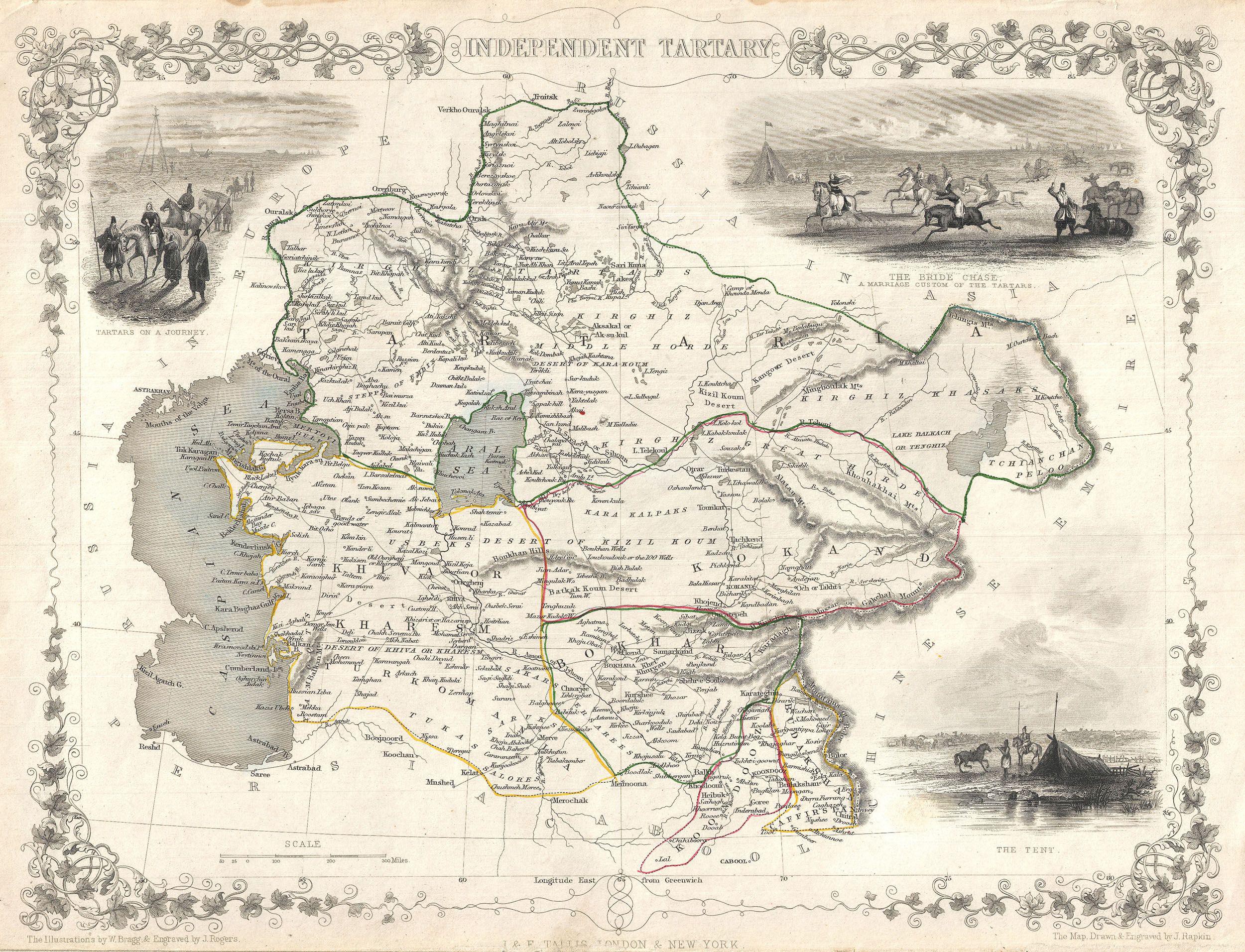 A highly decorative 1851 map of Independent Tartary by John Tallis and John Rapkin. Covers the regions between the Caspian Sea and Lake Bakquash and between Russia and Afghanistan. These include the ancient Silk Route kingdoms of Khiva, Tartaria, Kokand, and Bokhara. Today this region roughly includes Kazakhstan, Uzbekistan, Turkmenistan, Kyrgyzstan, and Tajikistan. This wonderful map offers a wealth of detail for anyone with an interest in the Central Asian portion of the ancient Silk Road. Identifies various caravan routes, deserts, wells, and stopping points, including the cities of Bokhara and Samarkand. Three vignettes by W. Bragg decorate the map, these including an image of Tartars on a Journey, a horseback Bride Chase, and a tartar camp site. Surrounded by a vine motif border. Engraved by J. Rapkin for John Tallis?s 1851 Illustrated Atlas.
A highly decorative 1851 map of Independent Tartary by John Tallis and John Rapkin. Covers the regions between the Caspian Sea and Lake Bakquash and between Russia and Afghanistan. These include the ancient Silk Route kingdoms of Khiva, Tartaria, Kokand, and Bokhara. Today this region roughly includes Kazakhstan, Uzbekistan, Turkmenistan, Kyrgyzstan, and Tajikistan. This wonderful map offers a wealth of detail for anyone with an interest in the Central Asian portion of the ancient Silk Road. Identifies various caravan routes, deserts, wells, and stopping points, including the cities of Bokhara and Samarkand. Three vignettes by W. Bragg decorate the map, these including an image of Tartars on a Journey, a horseback Bride Chase, and a tartar camp site. Surrounded by a vine motif border. Engraved by J. Rapkin for John Tallis?s 1851 Illustrated Atlas.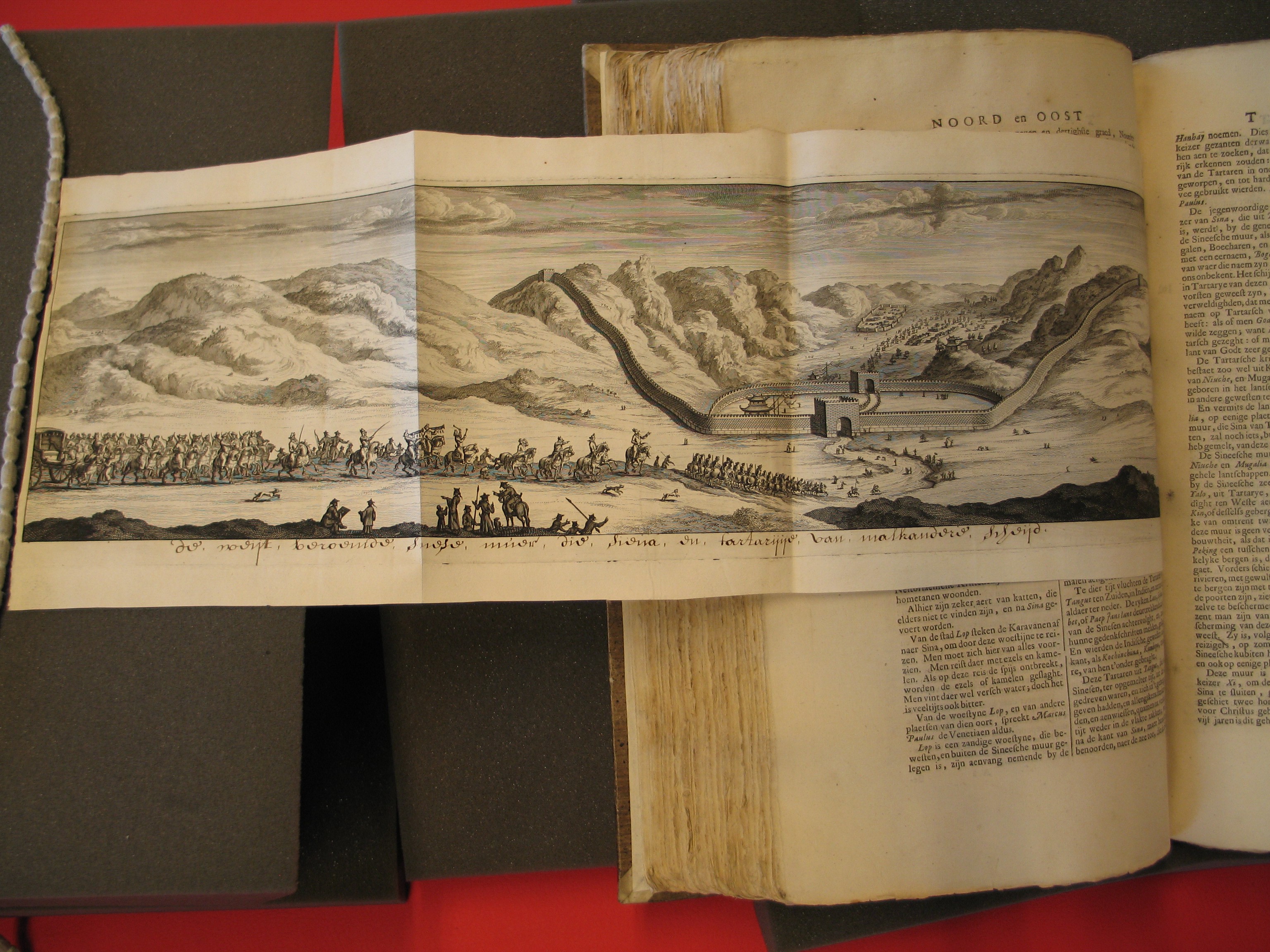 The famous Chinese wall separating China from Tartary. (Source: Book by Nicolaas Witsen ? Noord en Oost Tartarye)
The famous Chinese wall separating China from Tartary. (Source: Book by Nicolaas Witsen ? Noord en Oost Tartarye)
Tartarian language
There are some mentions of the Tartarian language from different sources but it is still unclear which was their actual language. There are many nations, tribes, dialects and languages in Asia during the 15?18th centuries, so only expert researchers could make a study to find out more about this language.
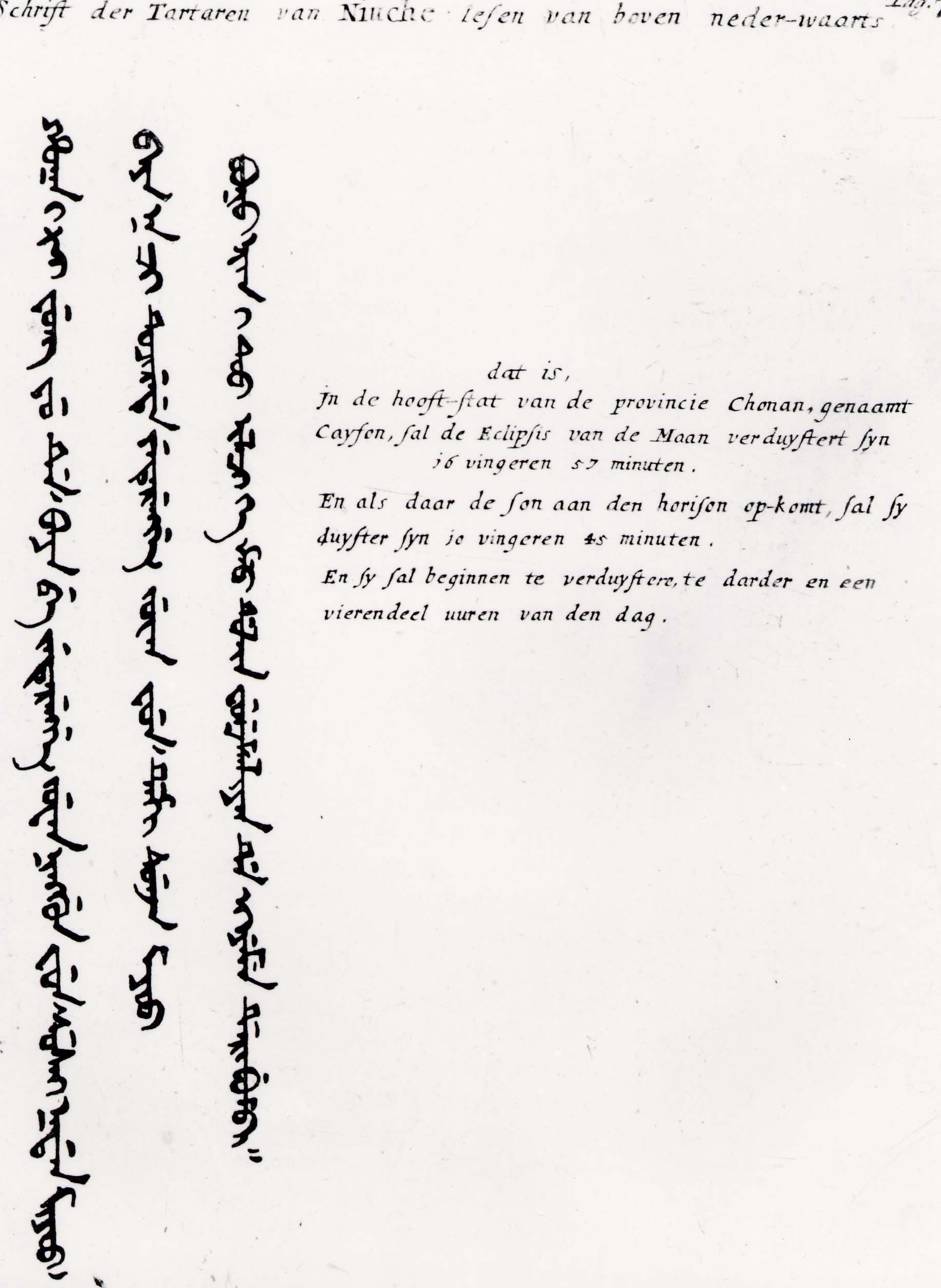
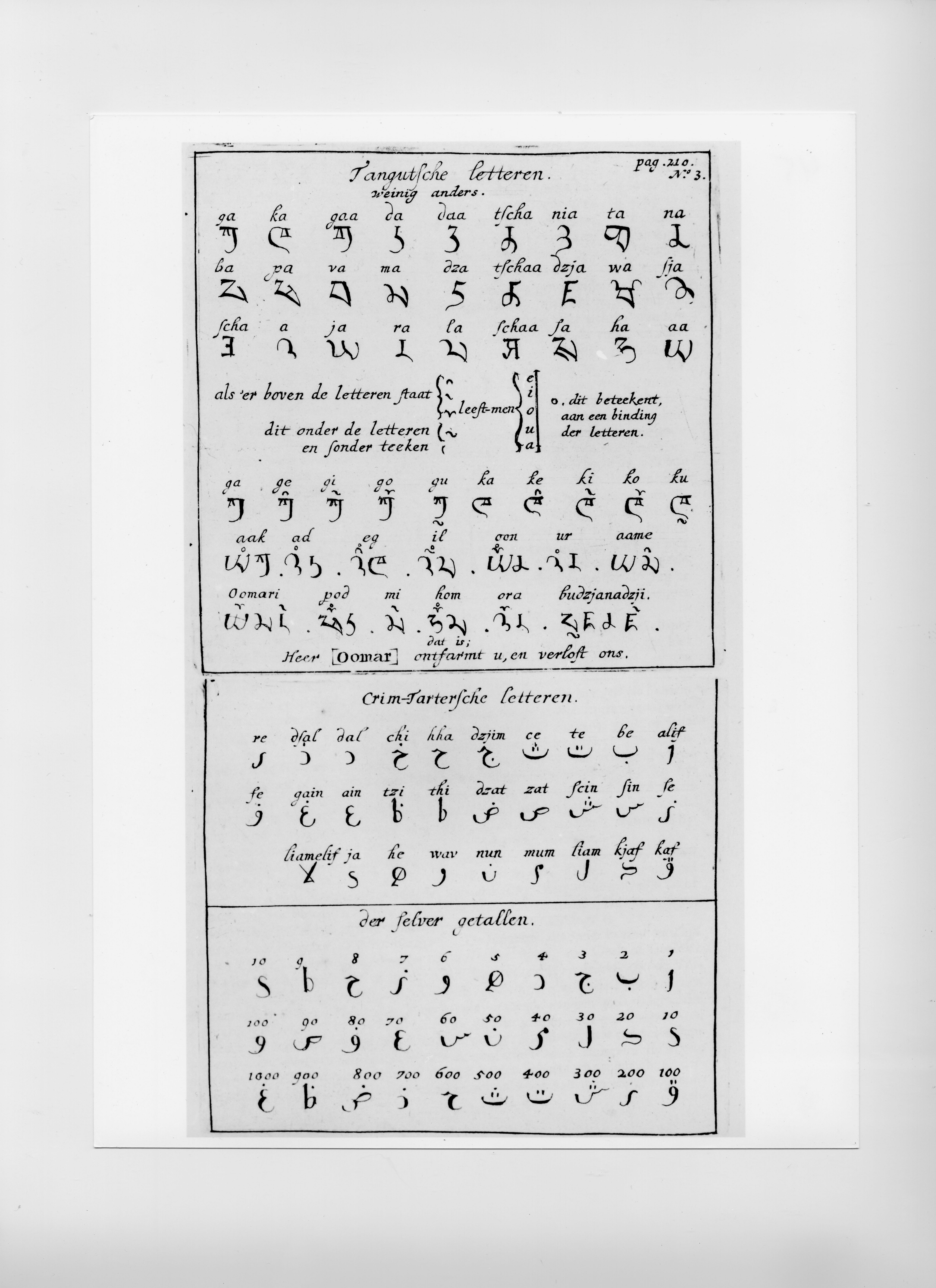 Left: Writing of the Tartars of Niuche (Manchuria), to be read from top to bottom. Right: Tangut letters. Slightly different Crimean Tartar letters Crimean Tartar numbers. (Source: (Source: Book by Nicolaas Witsen – Noord en Oost Tartarye)
Left: Writing of the Tartars of Niuche (Manchuria), to be read from top to bottom. Right: Tangut letters. Slightly different Crimean Tartar letters Crimean Tartar numbers. (Source: (Source: Book by Nicolaas Witsen – Noord en Oost Tartarye)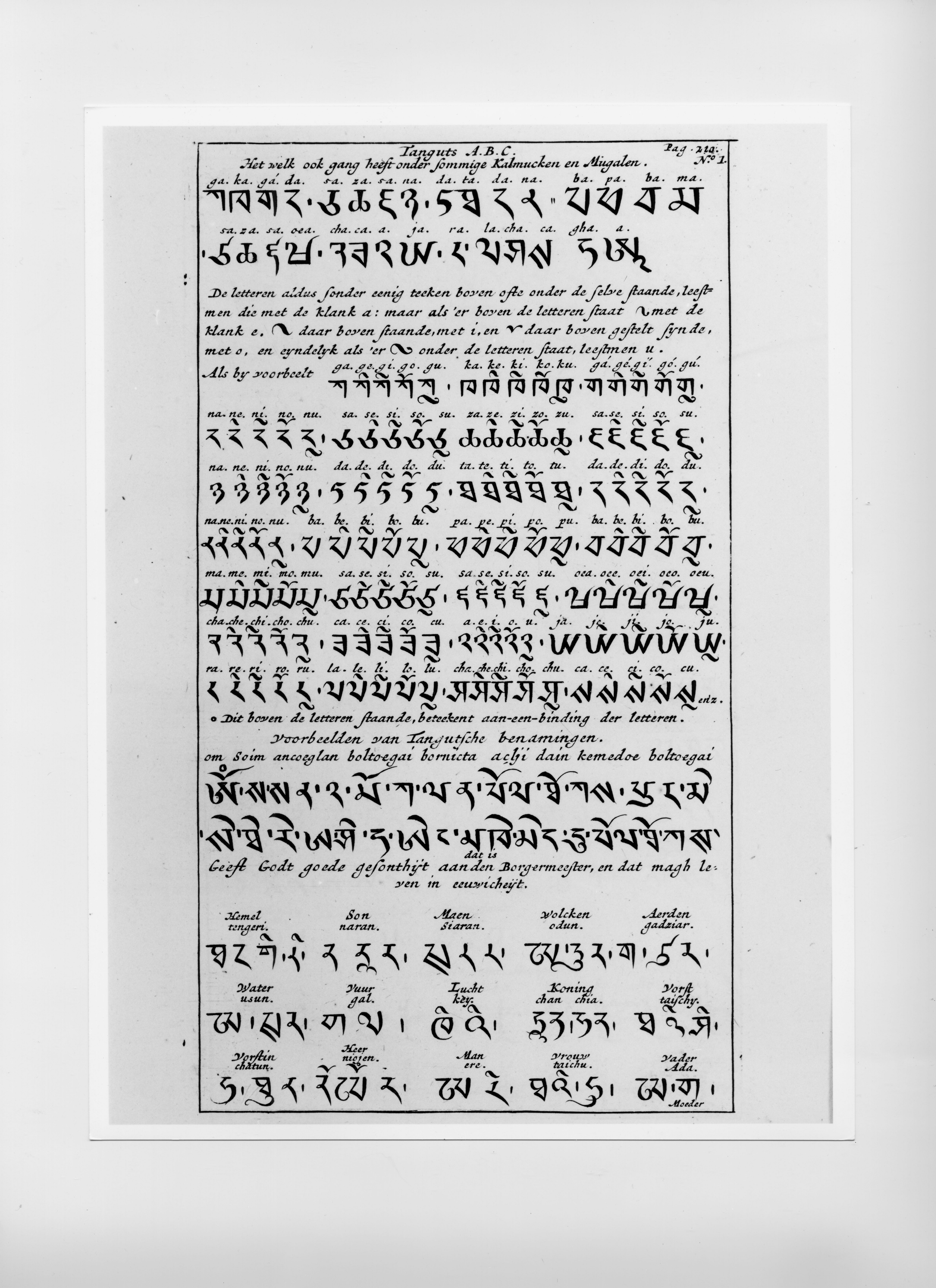 Tangut alphabet. Which is also in use among certain Calmucks and Mongols.
Tangut alphabet. Which is also in use among certain Calmucks and Mongols.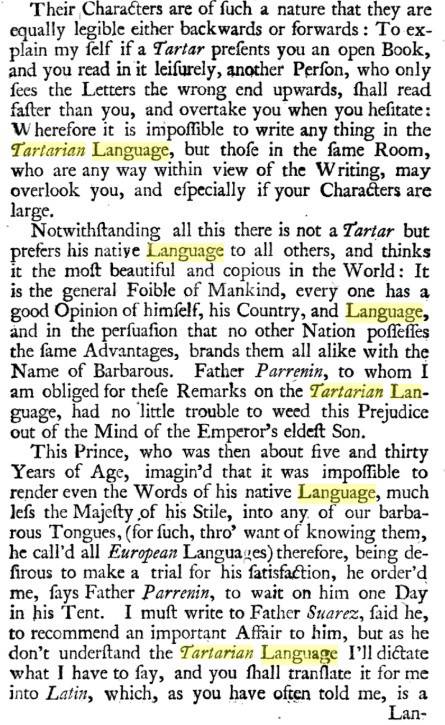 (Source: The General History of China, book by Jean-Baptiste Du Halde)
(Source: The General History of China, book by Jean-Baptiste Du Halde)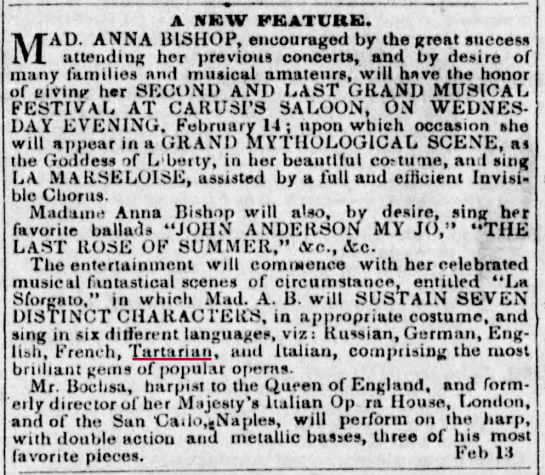 The Washington Union: Washington, District of Columbia, Tuesday, February 13, 1849 ? Page 3
The Washington Union: Washington, District of Columbia, Tuesday, February 13, 1849 ? Page 3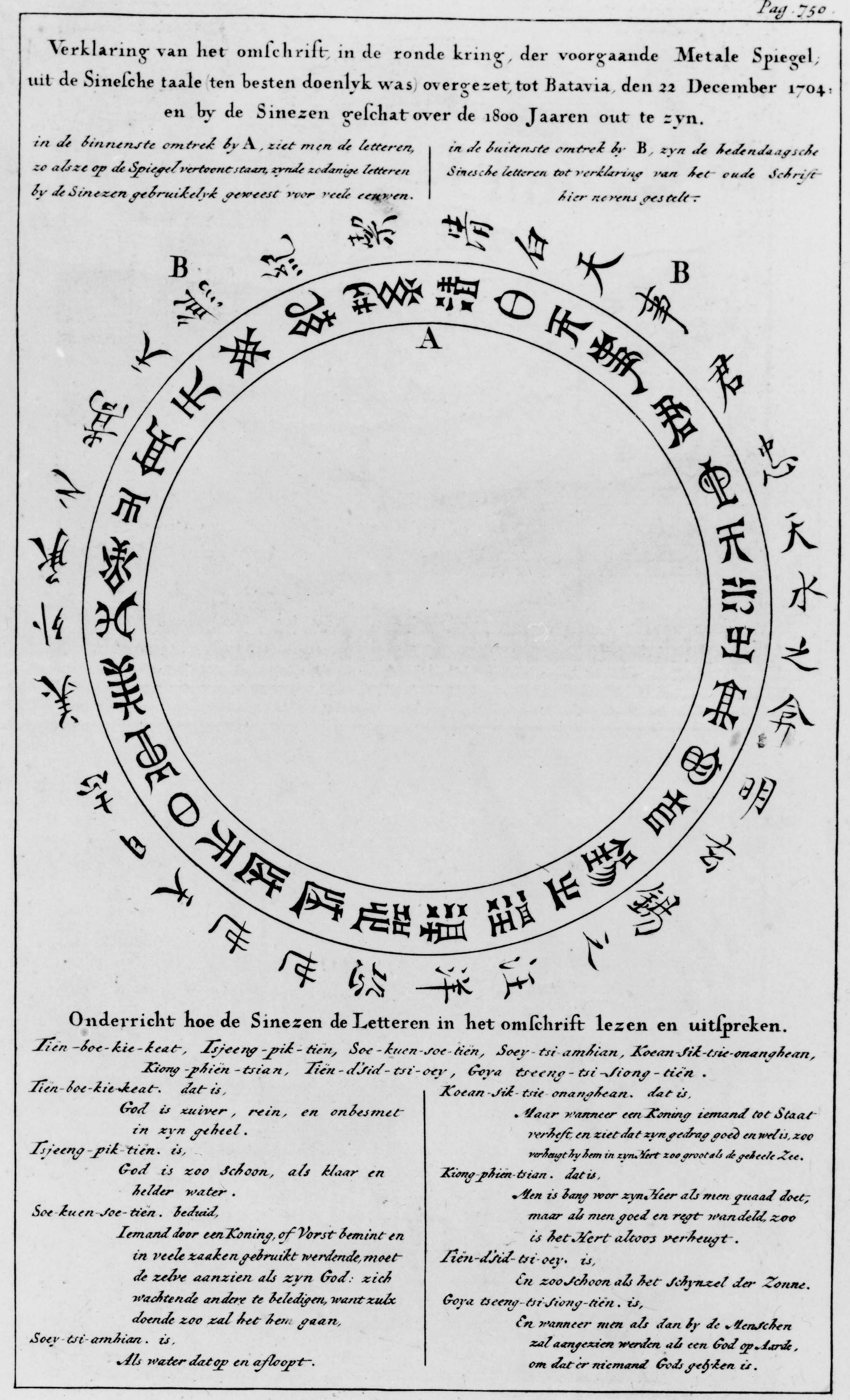 (Off-topic but interesting) Top text: Explanation of the text in the Chinese language in the circle on the previous metal mirror as good as possible translated in Batavia on 22 December 1704 and of which the age was estimated by the Chinese to be more than 1800 years. In the inner circle near A one sees the letters which are engraved in the mirror and which were used by the Chinese many ages ago. In the outer circle one sees the modern Chinese characters which correspond with the ancient text and explain it. Bottom text: Instruction how the Chinese read and pronounce the text in the circle. Circle Text: God is totally pure, clean and immaculate. God is so beautiful like clear and bright water. One who is loved by a King or Prince and is involved in many affairs should consider his master to be his God and refrain from insulting other people if he does not want to be treated in the same way. Like water running up and down. But when a King elevates someone to a high position and sees that his behavior is just he receives him with joy in his heart, which is as big as the whole sea. When doing wrong one is afraid of his Lord, but when doing the right and proper things the heart always enjoys. And as beautiful as the rays of the sun. And when one is considered by the people to be a God on earth because nobody is God?s equal.
(Off-topic but interesting) Top text: Explanation of the text in the Chinese language in the circle on the previous metal mirror as good as possible translated in Batavia on 22 December 1704 and of which the age was estimated by the Chinese to be more than 1800 years. In the inner circle near A one sees the letters which are engraved in the mirror and which were used by the Chinese many ages ago. In the outer circle one sees the modern Chinese characters which correspond with the ancient text and explain it. Bottom text: Instruction how the Chinese read and pronounce the text in the circle. Circle Text: God is totally pure, clean and immaculate. God is so beautiful like clear and bright water. One who is loved by a King or Prince and is involved in many affairs should consider his master to be his God and refrain from insulting other people if he does not want to be treated in the same way. Like water running up and down. But when a King elevates someone to a high position and sees that his behavior is just he receives him with joy in his heart, which is as big as the whole sea. When doing wrong one is afraid of his Lord, but when doing the right and proper things the heart always enjoys. And as beautiful as the rays of the sun. And when one is considered by the people to be a God on earth because nobody is God?s equal.
Culture
The following images are taken from Nicolaen Witsen?s book North and East Tartary and can be found here.
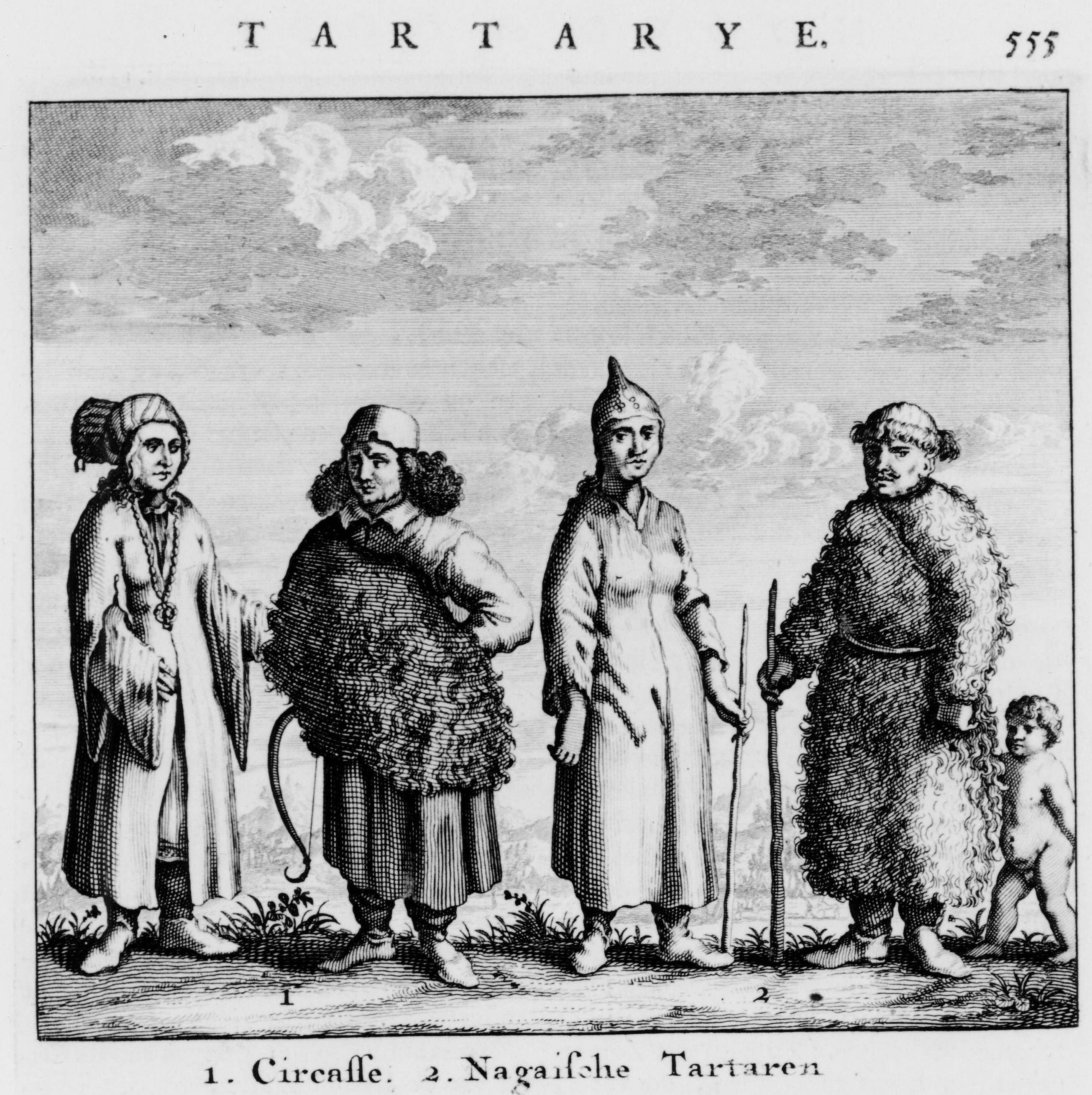 1. Circassian 2. Nagai Tartars
1. Circassian 2. Nagai Tartars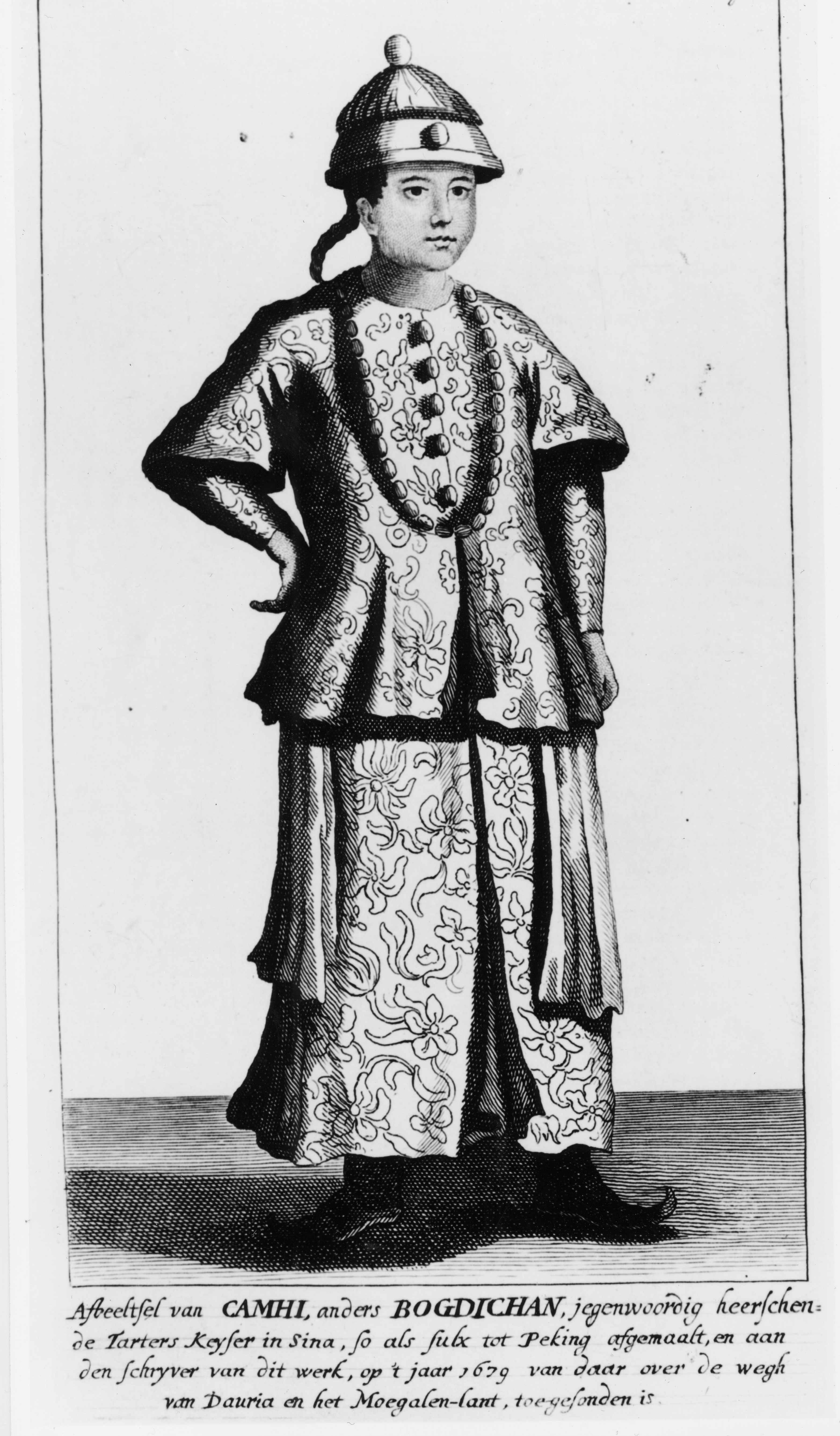 Portret of CAMHI, otherwise BOGDICHAN, the presently ruling Tartarian Emperor in China, which was drawn in Peking in 1679 and sent by way of Dauria and Mongol-land to the author of this work.
Portret of CAMHI, otherwise BOGDICHAN, the presently ruling Tartarian Emperor in China, which was drawn in Peking in 1679 and sent by way of Dauria and Mongol-land to the author of this work.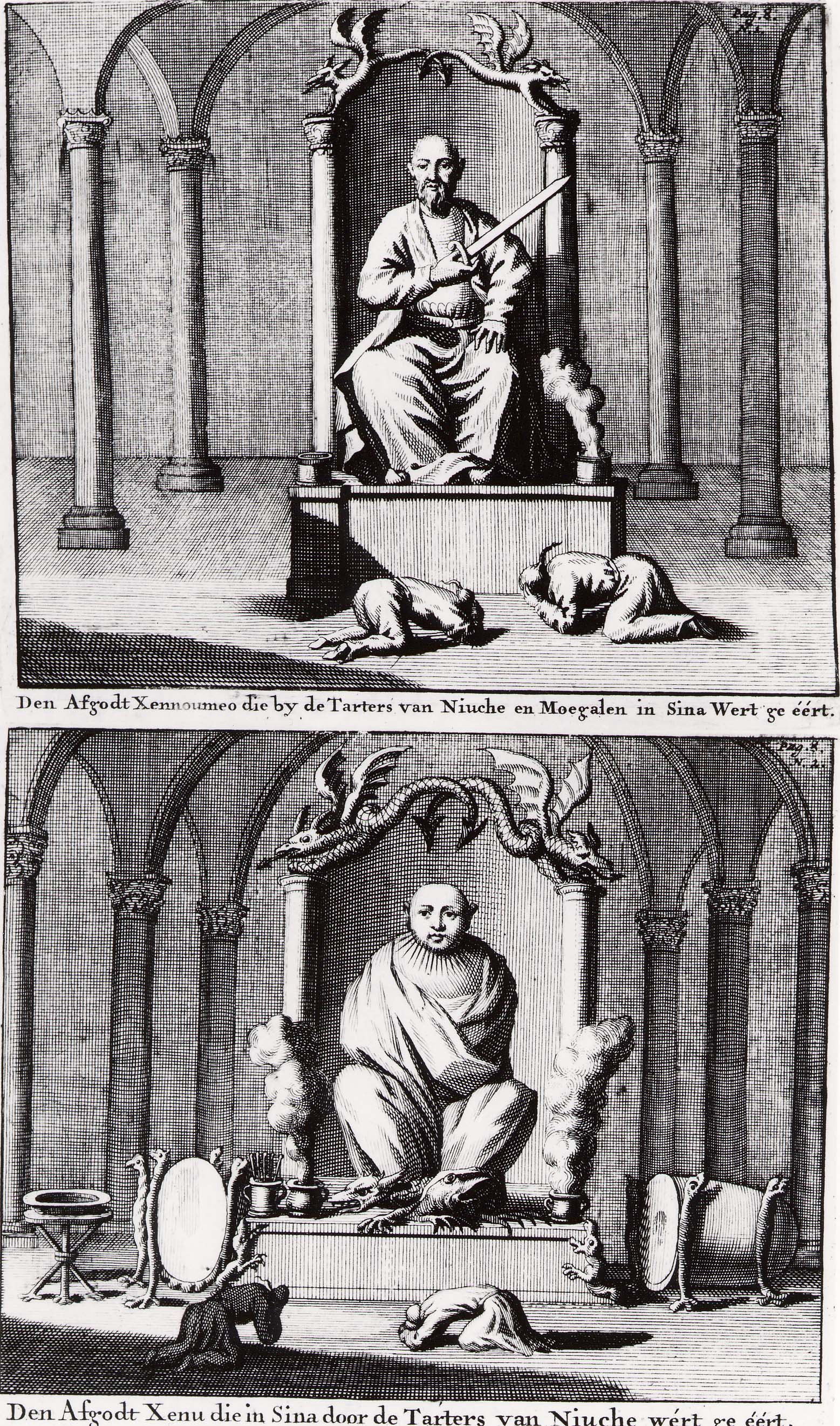 Top: Idol Xennoumeo revered by the Tartars of Niukhe and Mongolia. Bottom: Idol Xenu in China revered by the Tartars of Niukhe.
Top: Idol Xennoumeo revered by the Tartars of Niukhe and Mongolia. Bottom: Idol Xenu in China revered by the Tartars of Niukhe.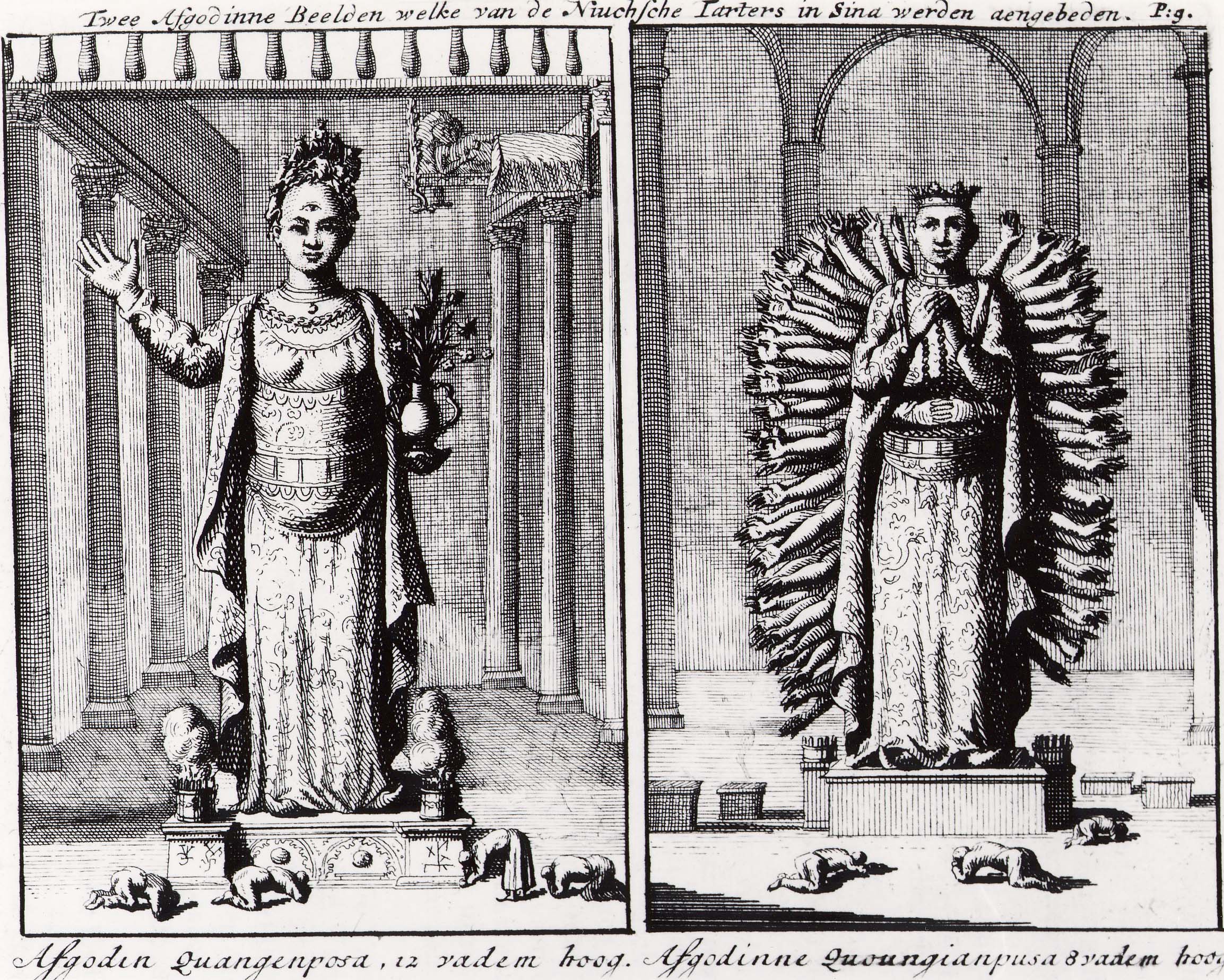 Two female idols revered by Niukhian (Manchurian) Tartars in China. Left: Female idol Quangenposa, 12 fathoms high. Right: Female idol Quoungiapusa, 8 fathoms high.
Two female idols revered by Niukhian (Manchurian) Tartars in China. Left: Female idol Quangenposa, 12 fathoms high. Right: Female idol Quoungiapusa, 8 fathoms high.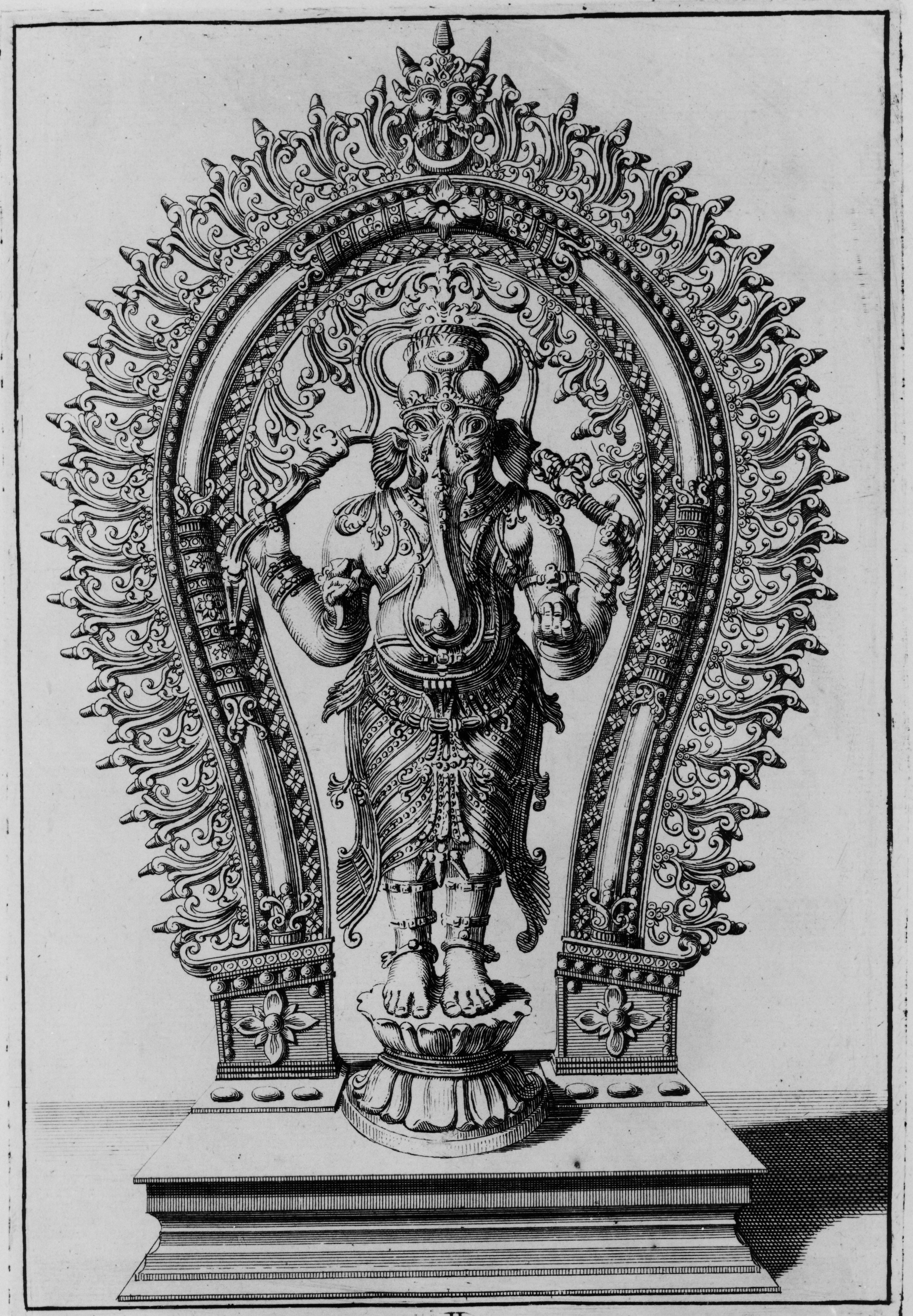 Image of Indian Hindu deity Ganesha or Ganapati. (The idol with the elephant snout is named Quenevady , son of the God Ixora or Elsware , sometimes also called Vievrepedra .)
Image of Indian Hindu deity Ganesha or Ganapati. (The idol with the elephant snout is named Quenevady , son of the God Ixora or Elsware , sometimes also called Vievrepedra .)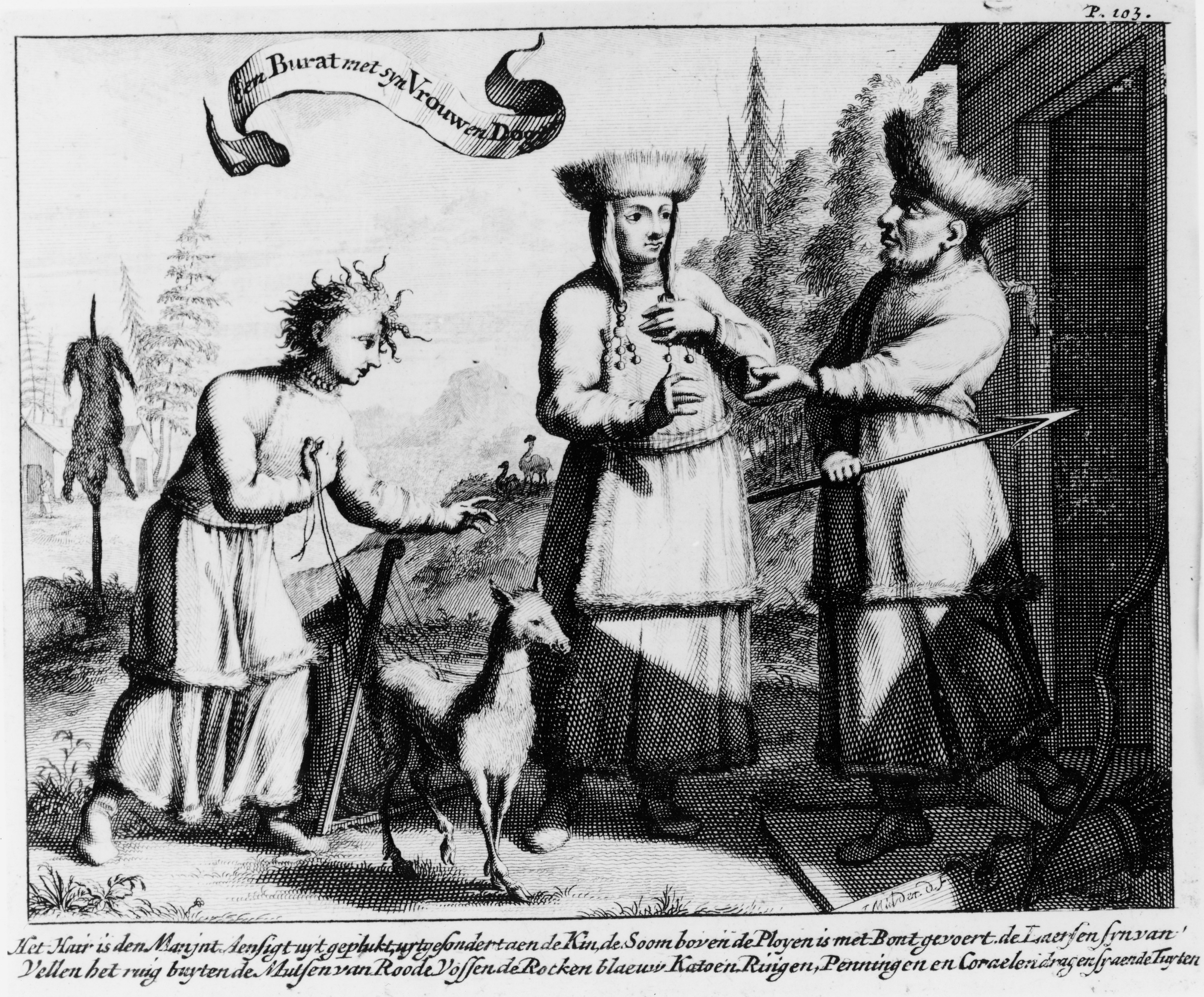 A Buryat with his Wife and Daughter. (Translation of the subtext: The hair is removed from the man?s face except for the chin, The seam above the pleats is lined with fur, The boots are [made] of hides with the rough side outside, The caps are [made] of red fox, The skirts [are made] of blue cotton, Rings, coins and corals they wear in their braids.)
A Buryat with his Wife and Daughter. (Translation of the subtext: The hair is removed from the man?s face except for the chin, The seam above the pleats is lined with fur, The boots are [made] of hides with the rough side outside, The caps are [made] of red fox, The skirts [are made] of blue cotton, Rings, coins and corals they wear in their braids.)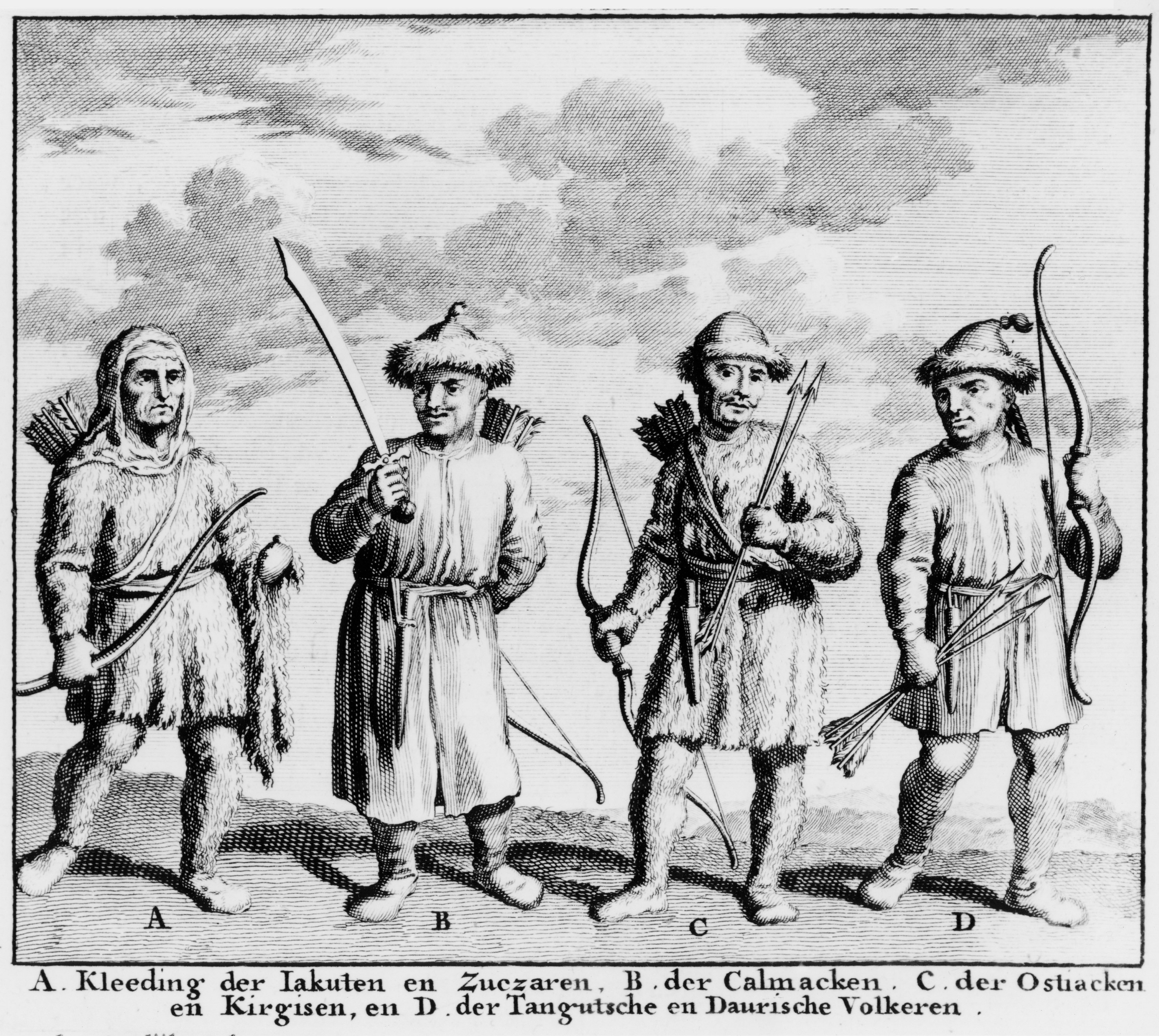 A. Clothing of Iakut and Zuczar. B. of the Calmuck C. of the Ostiak and Kirgiz, and D. of the Tangut and Daur peoples.
A. Clothing of Iakut and Zuczar. B. of the Calmuck C. of the Ostiak and Kirgiz, and D. of the Tangut and Daur peoples.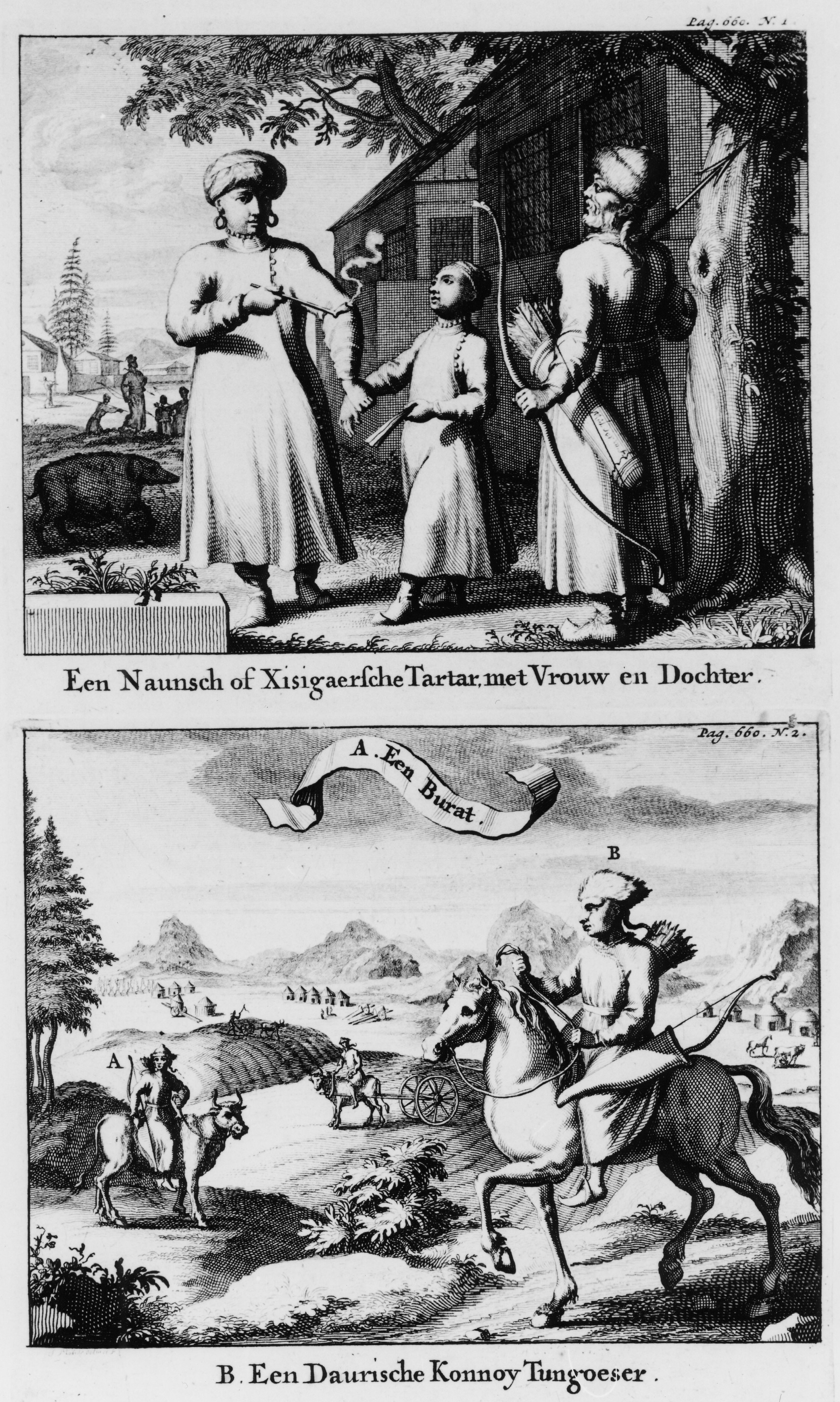 Top: A Naun or Khisigarian Tartar with spouse and daughter Bottom: A. A Buryat. B. A Daurian Konnoi Tungus
Top: A Naun or Khisigarian Tartar with spouse and daughter Bottom: A. A Buryat. B. A Daurian Konnoi Tungus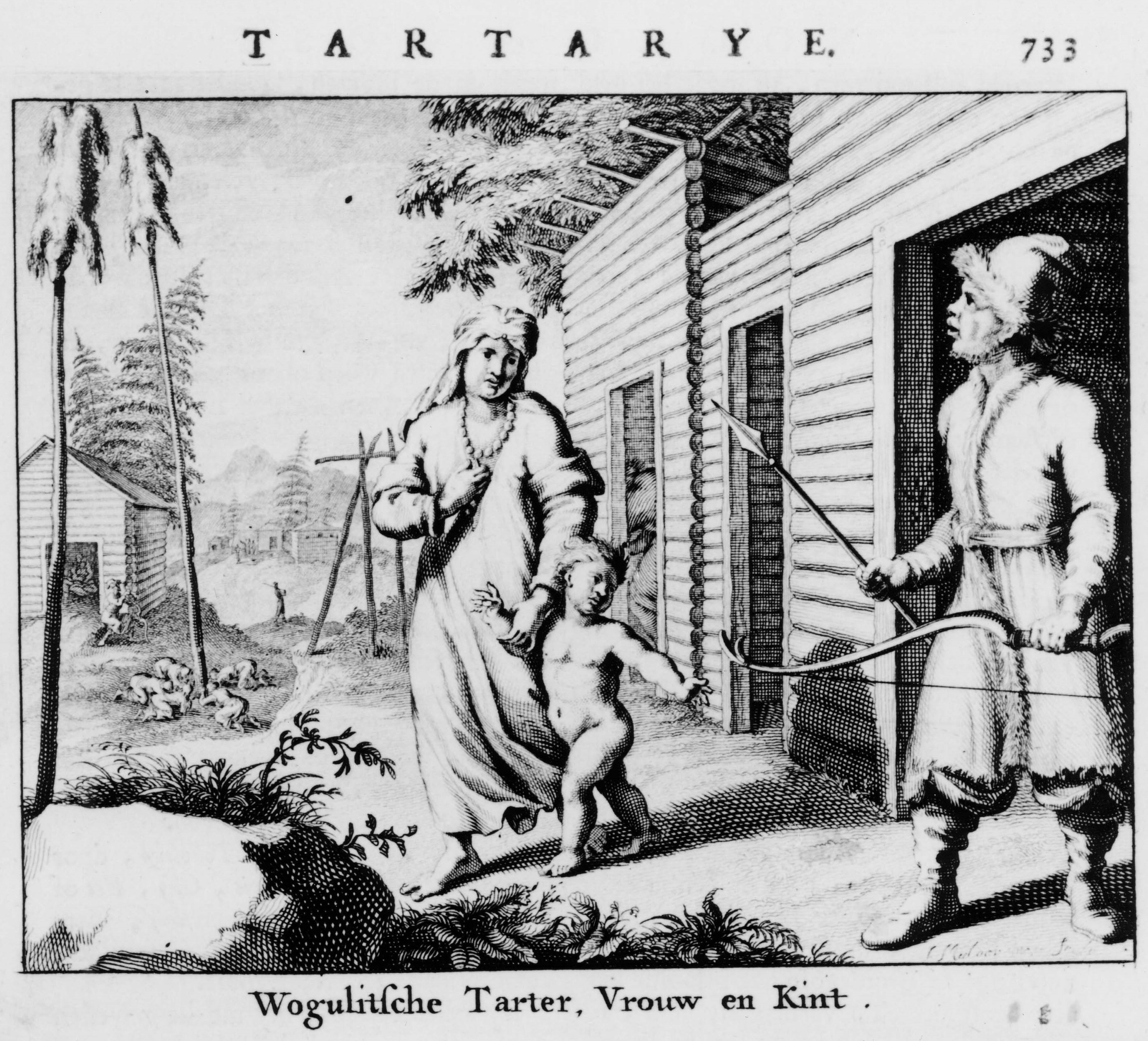 Wogulian Tartar, Woman and Child.
Wogulian Tartar, Woman and Child.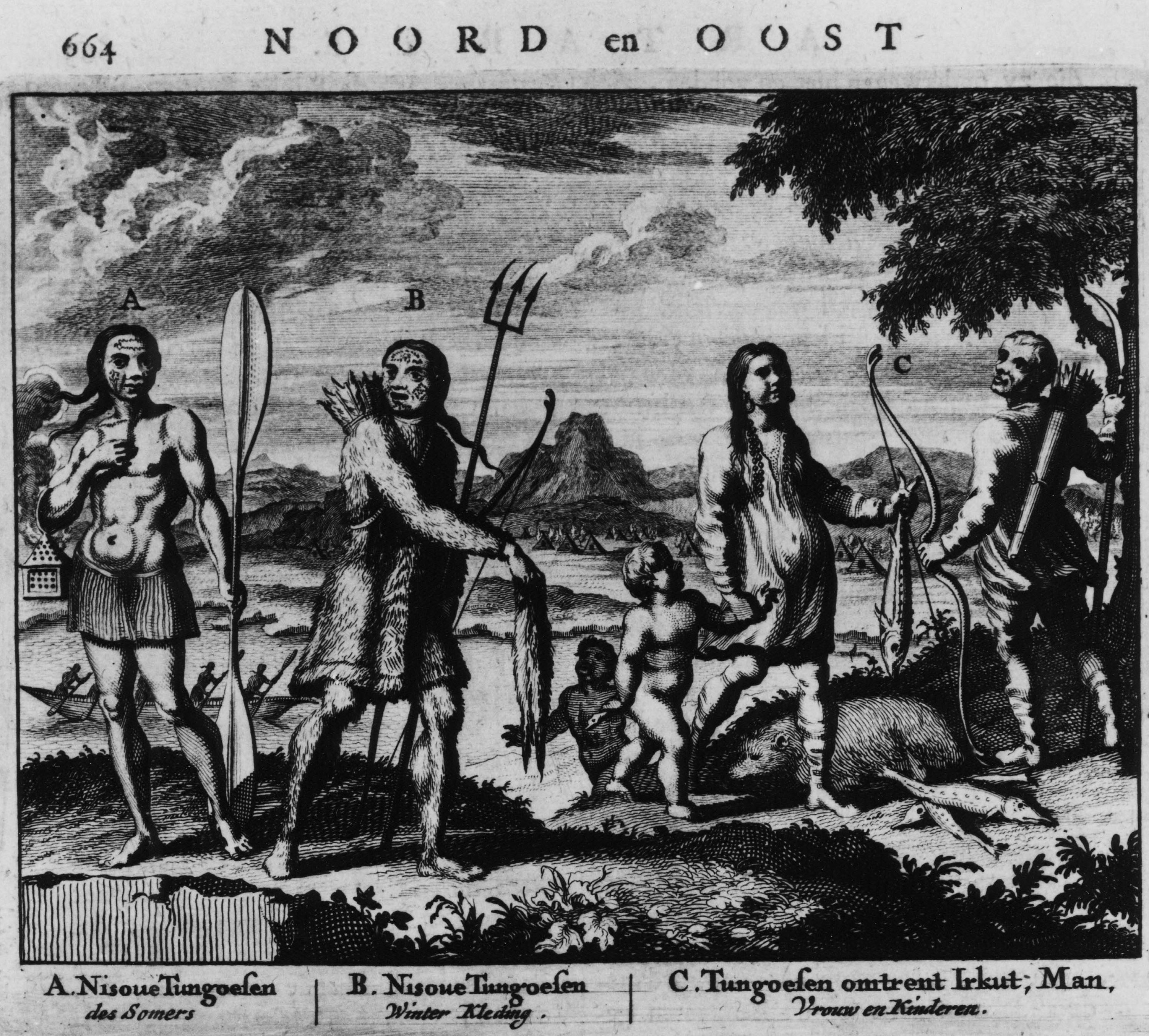 A. Nissou Tungus during the Summer | B. Nissou Tungus during the Winter. | C.Tungus people around Irkut[sk], Man. Spouse and children
A. Nissou Tungus during the Summer | B. Nissou Tungus during the Winter. | C.Tungus people around Irkut[sk], Man. Spouse and children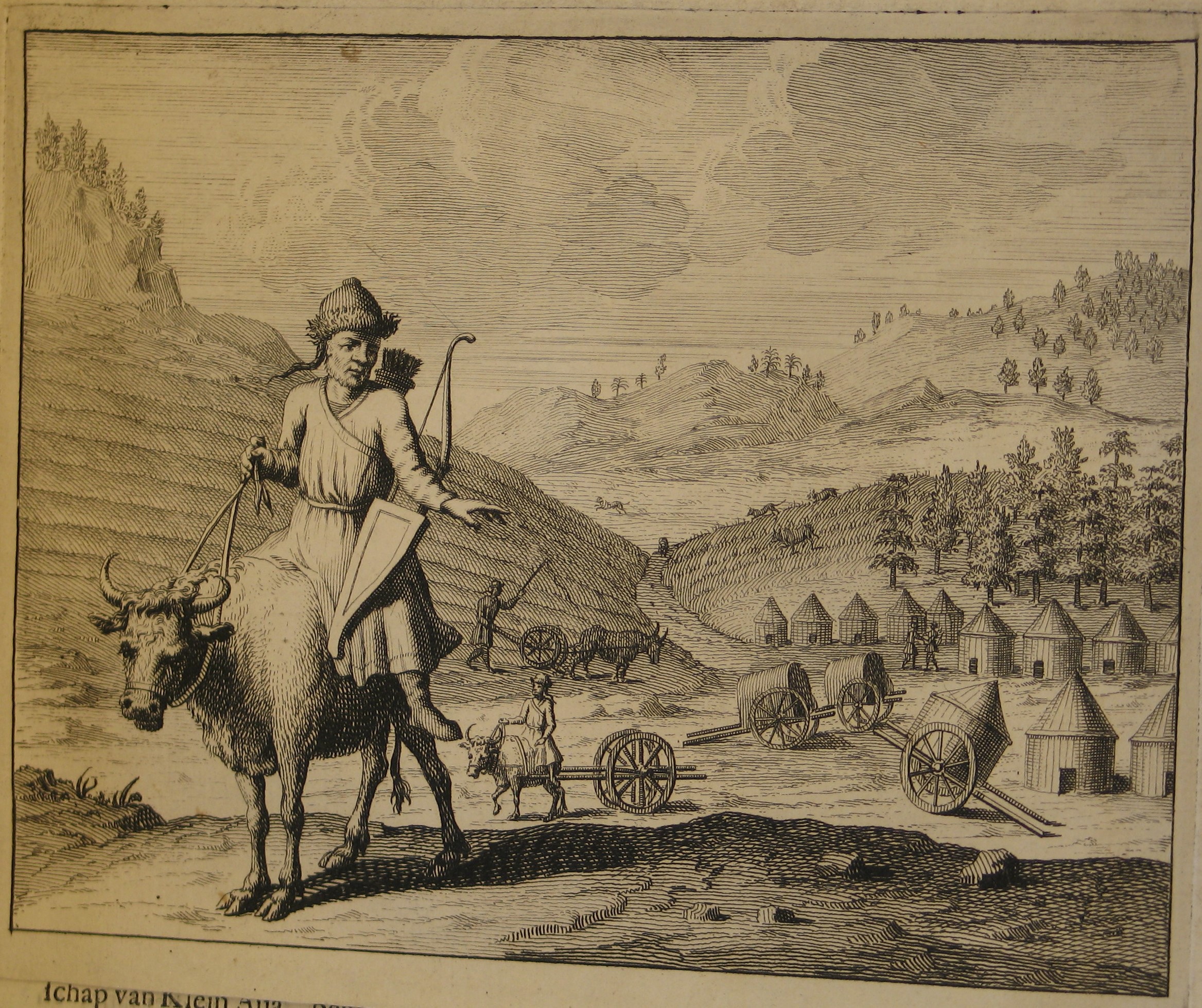 Targaziny or Tungusian horseman and peasants.
Targaziny or Tungusian horseman and peasants.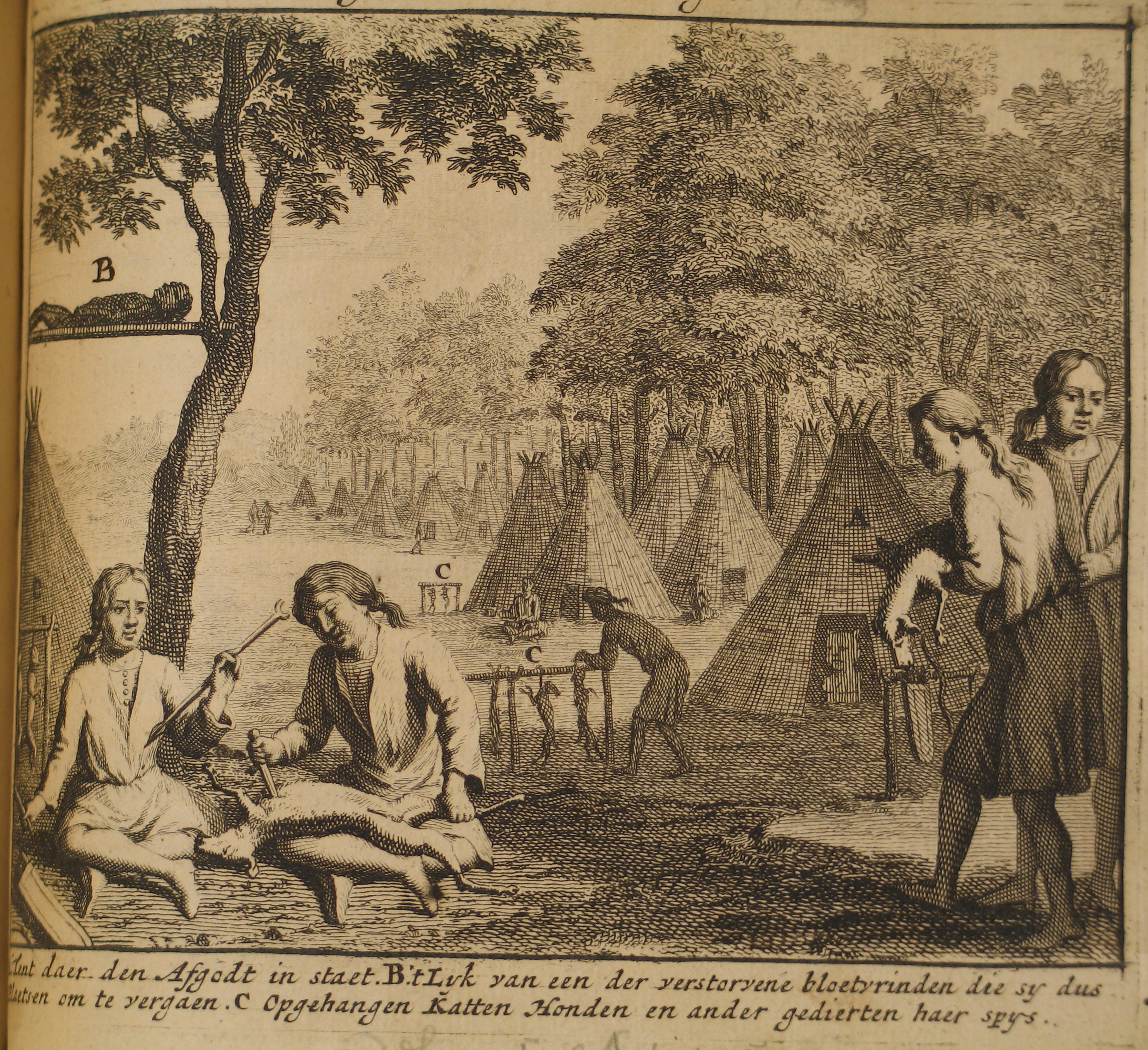 Tungusian dwellings. A. Tent where the idol is situated. B. decaying body of dead relative. C. hanging cats, dogs and other animals which serve them as food.
Tungusian dwellings. A. Tent where the idol is situated. B. decaying body of dead relative. C. hanging cats, dogs and other animals which serve them as food.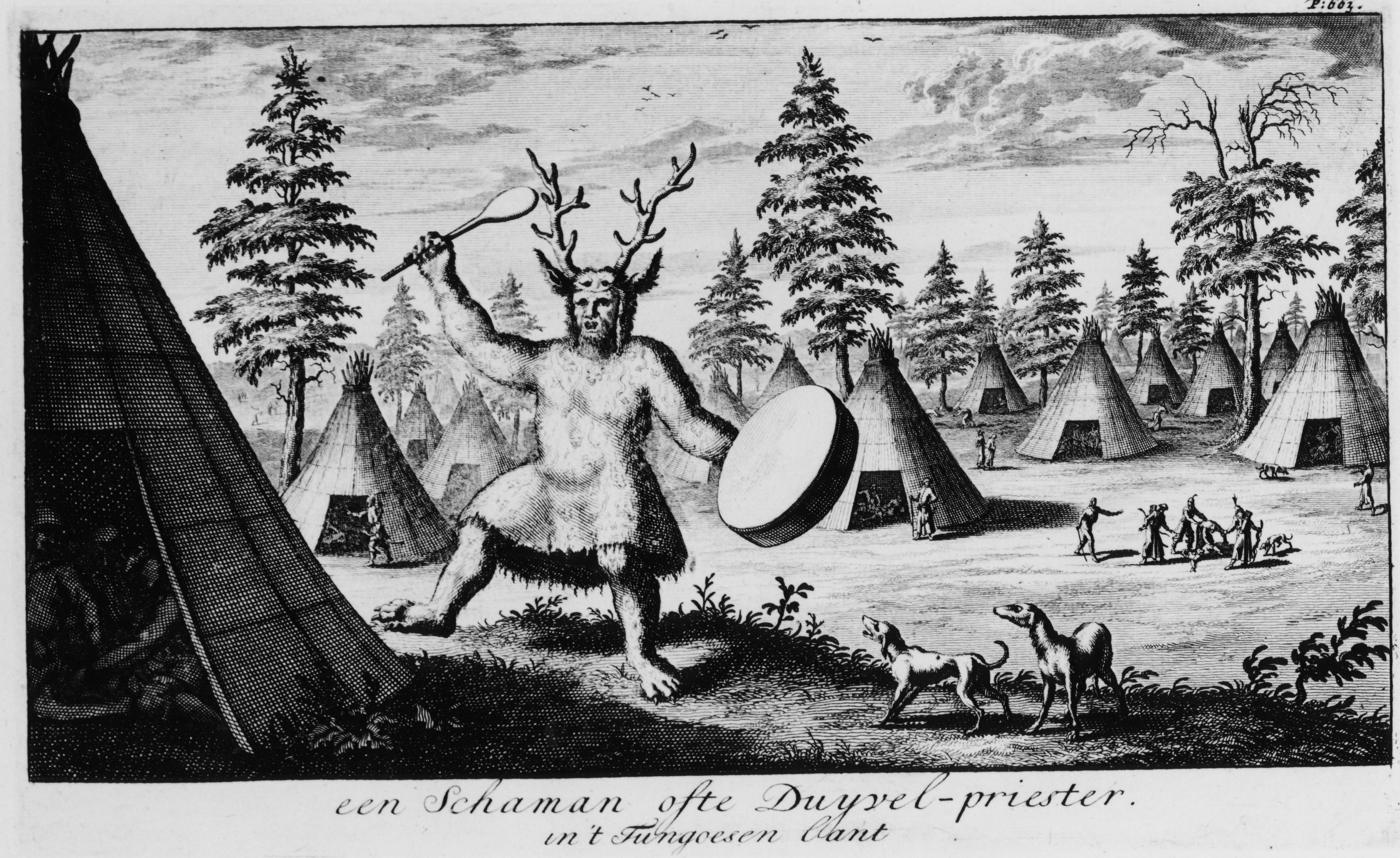 A shaman or Devil-priest in the country of the Tungus. (This is the first picture published in Europe of a Siberian shaman.)
A shaman or Devil-priest in the country of the Tungus. (This is the first picture published in Europe of a Siberian shaman.)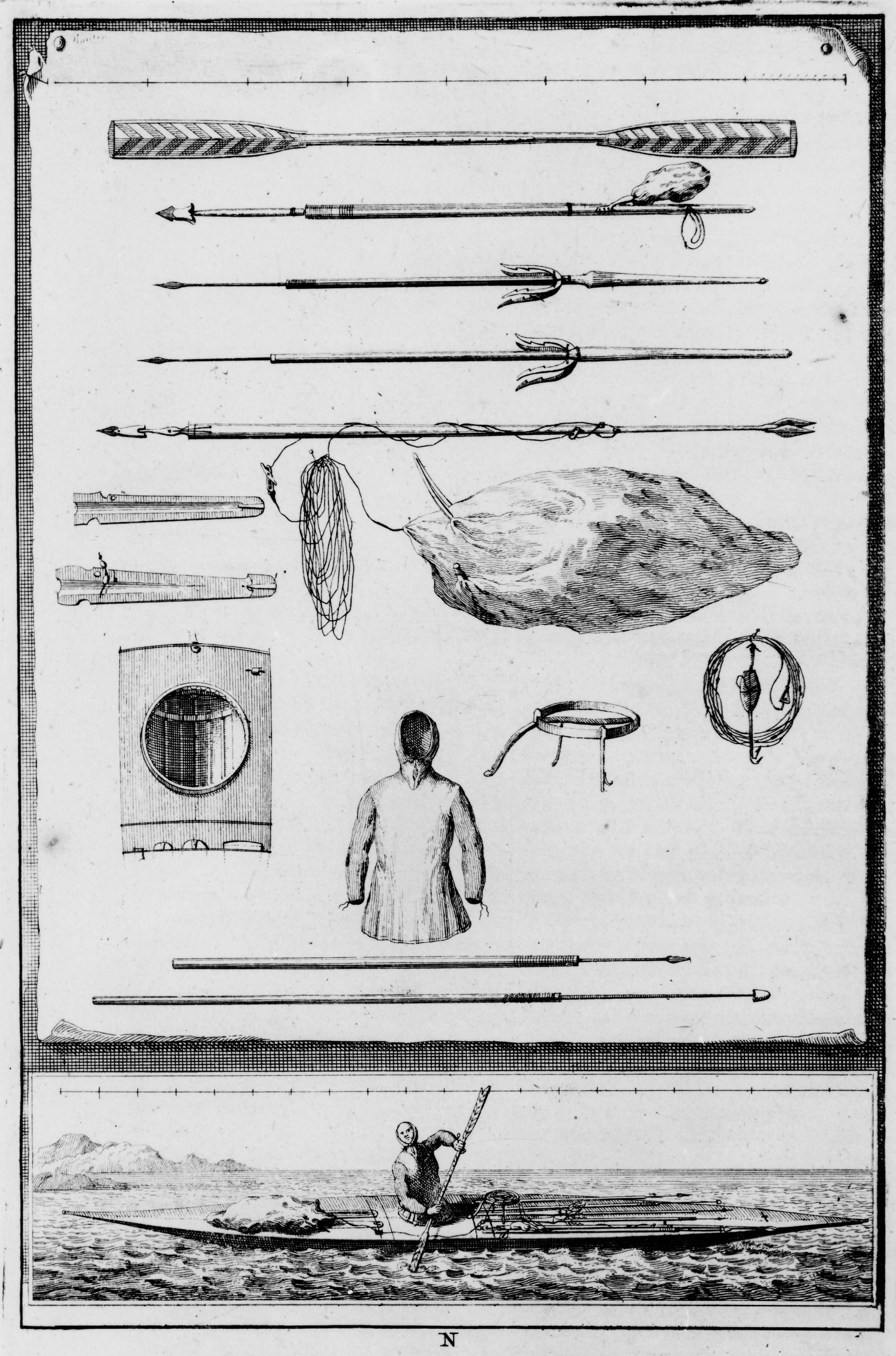 Equipment of a kayak navigator and hunter. The clothing, shoes and the description of a male corpse which was found in a kayak in the Northern Ice Sea.
Equipment of a kayak navigator and hunter. The clothing, shoes and the description of a male corpse which was found in a kayak in the Northern Ice Sea.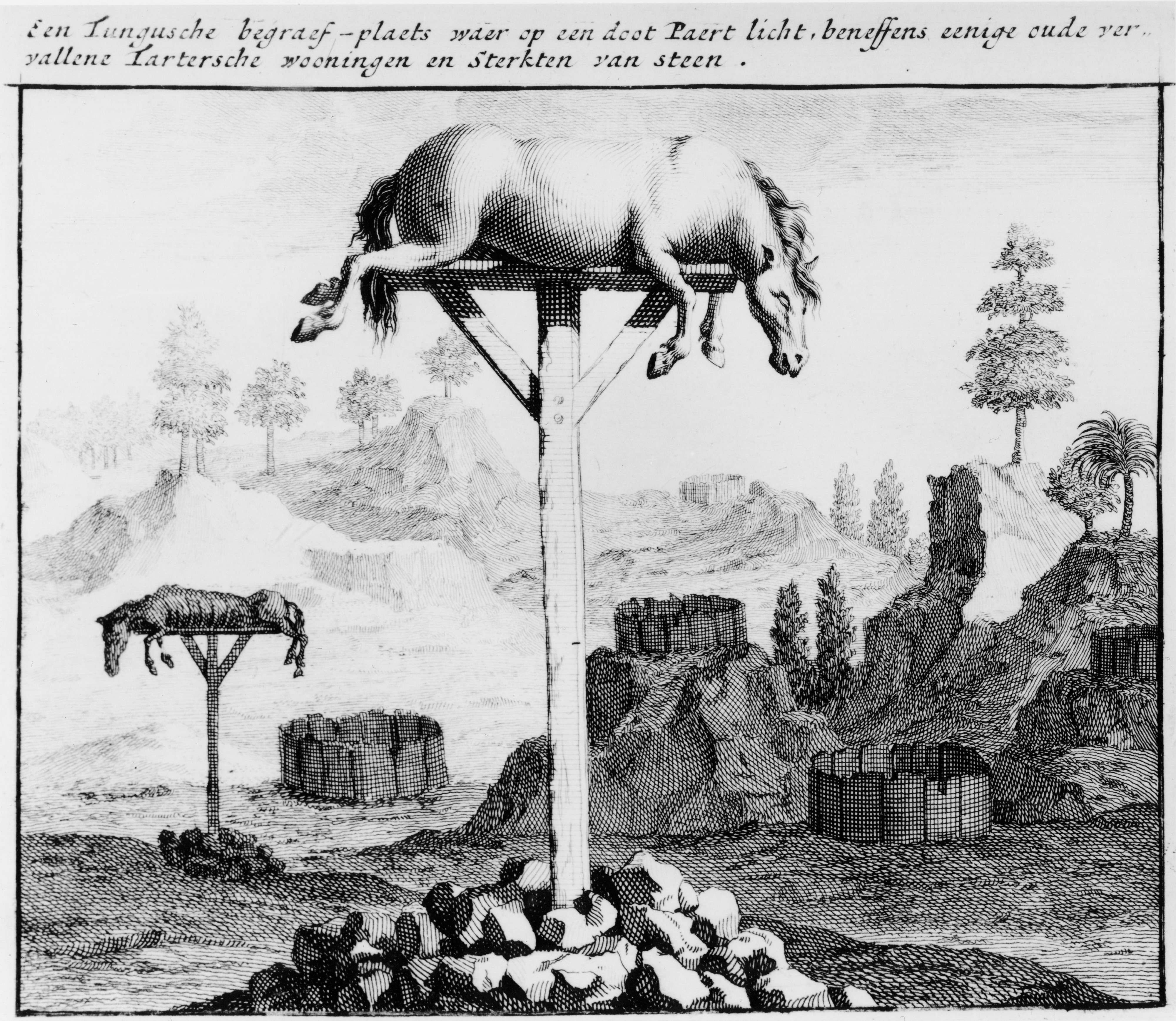 A Tungusian cemetery on which a dead horse lies, next to some old dilapidated Tartarian dwellings and fortresses made of stone. [?The Calmucks and Mongols put dead horses on the graves of their friends.? Central to the religious practices of the shamanist Buryats and Mongols was the Tailgan , a blood-sacrifice to the sky god Tengri, in which a (white) horse was killed and its skin hung on a high pole. ]
A Tungusian cemetery on which a dead horse lies, next to some old dilapidated Tartarian dwellings and fortresses made of stone. [?The Calmucks and Mongols put dead horses on the graves of their friends.? Central to the religious practices of the shamanist Buryats and Mongols was the Tailgan , a blood-sacrifice to the sky god Tengri, in which a (white) horse was killed and its skin hung on a high pole. ]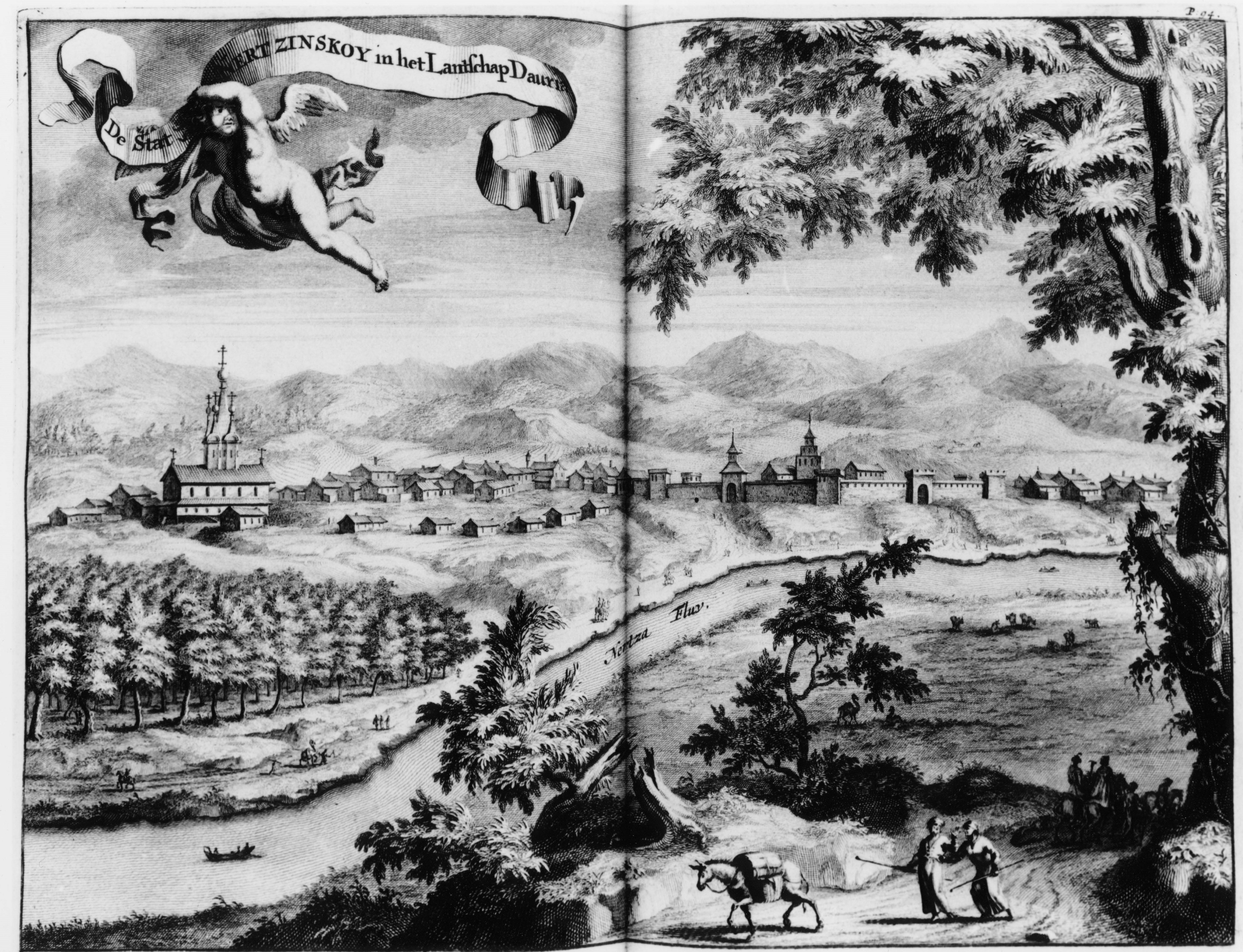 The Town of Nertzinskoy ( Nerchinsk) in the region of Dauria.
The Town of Nertzinskoy ( Nerchinsk) in the region of Dauria.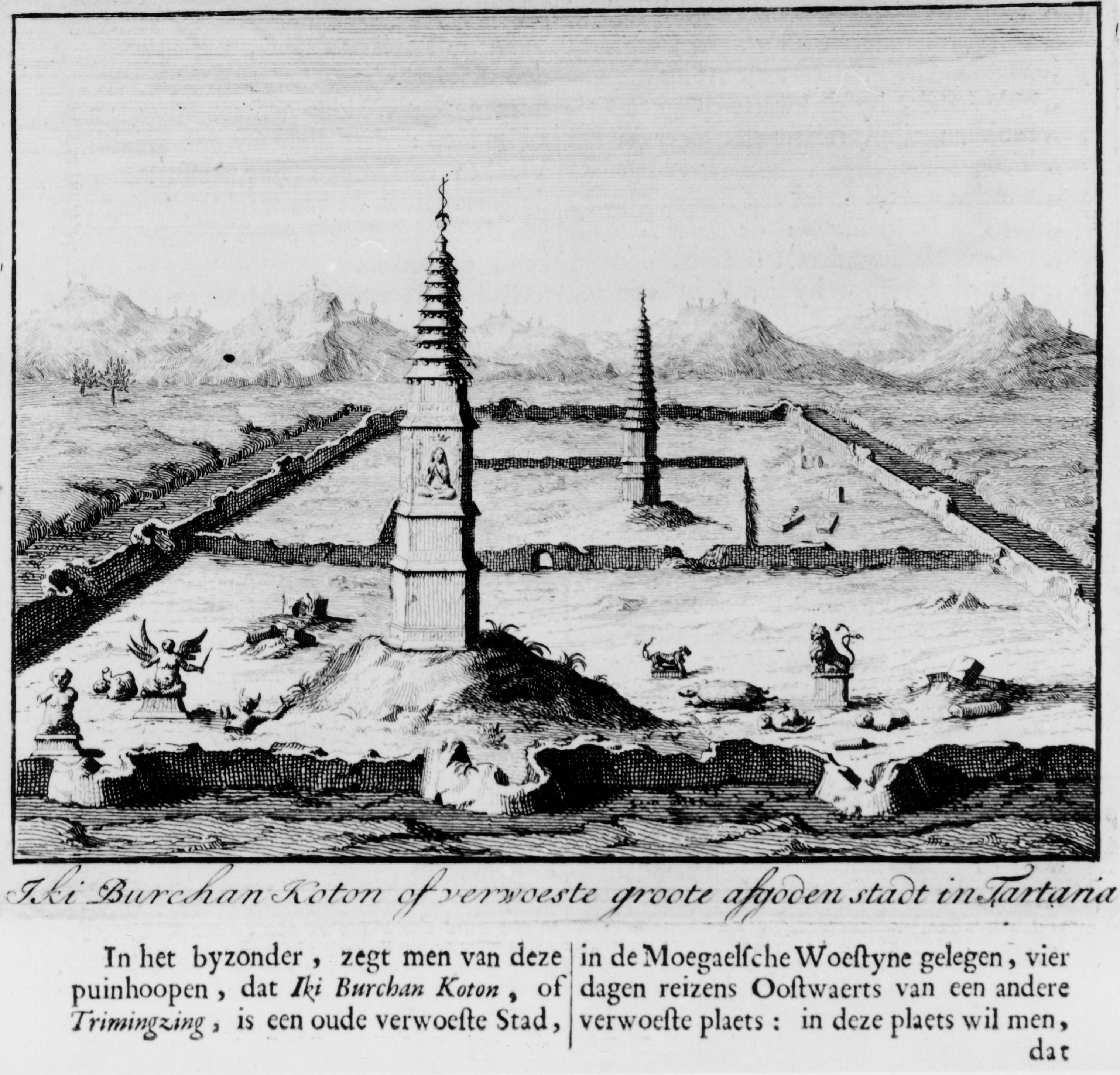 Iki Burchan Koton or destroyed town with big idols in Tartaria.
Iki Burchan Koton or destroyed town with big idols in Tartaria.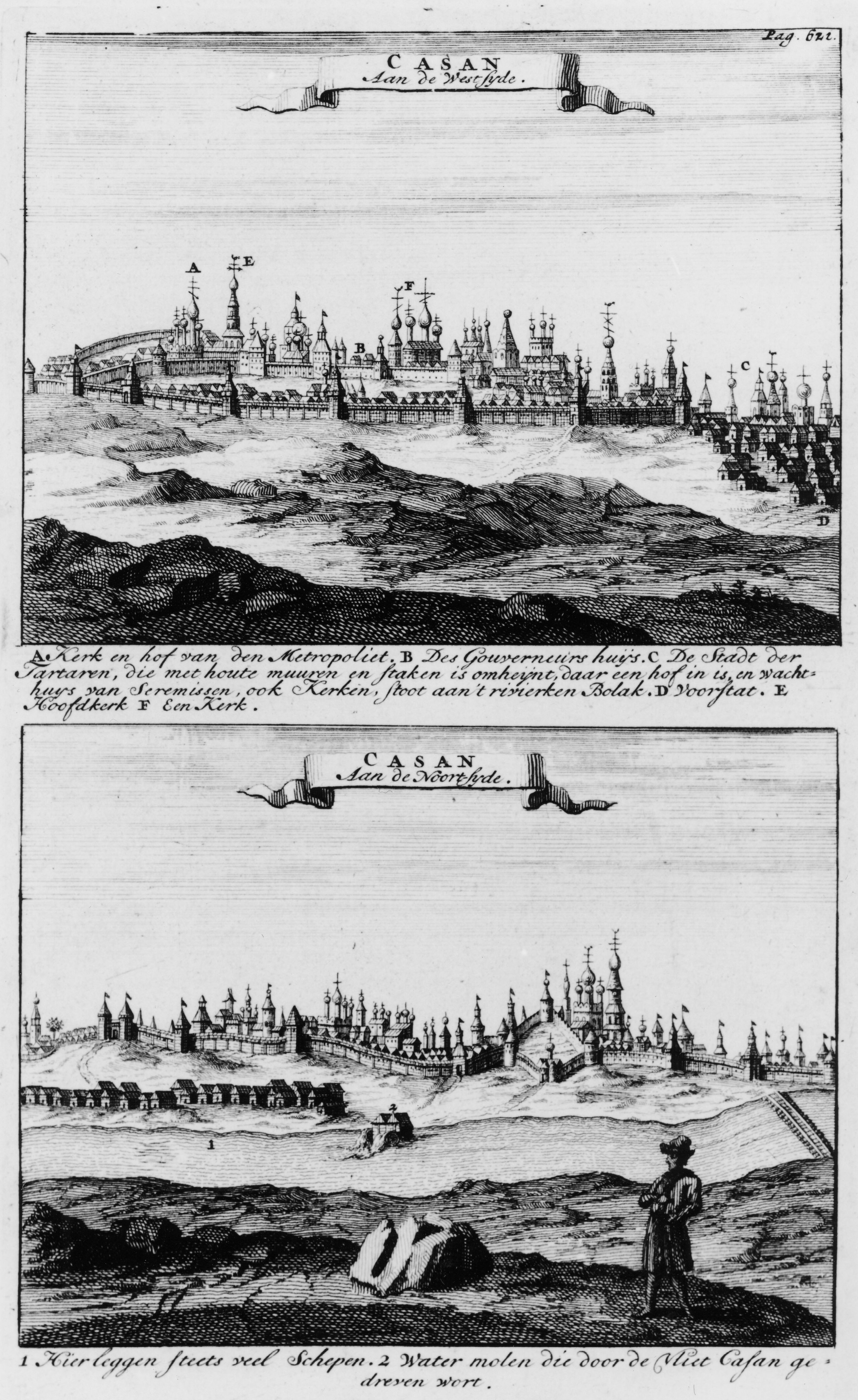 Top: Casan [Kazan] on the Westside (Town of the Tartars surrounded by wooden walls and stakes, in it is a court and watch house and also churches, it borders on the small river Bolak.) Bottom: Casan on the North side.
Top: Casan [Kazan] on the Westside (Town of the Tartars surrounded by wooden walls and stakes, in it is a court and watch house and also churches, it borders on the small river Bolak.) Bottom: Casan on the North side.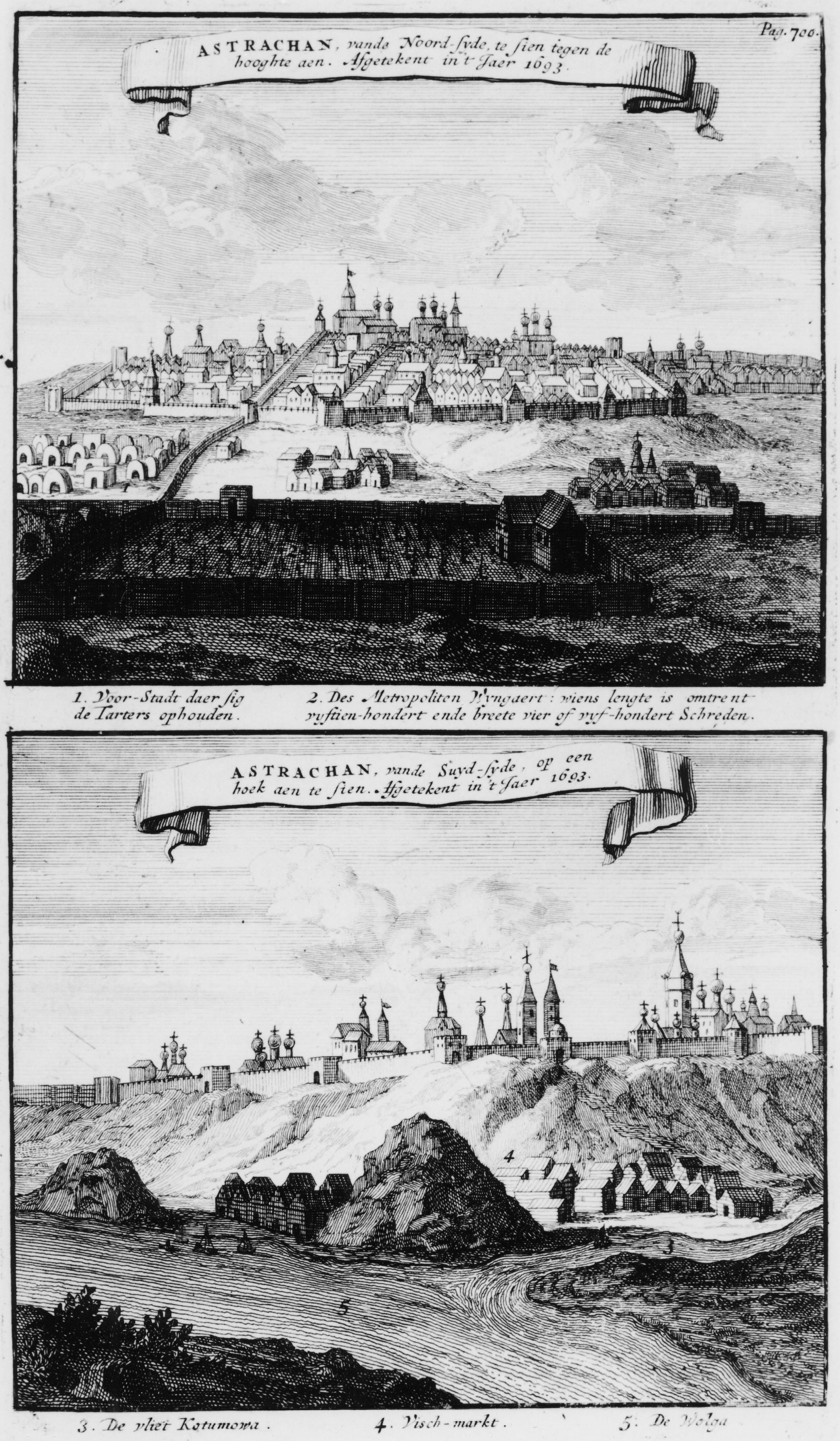 Top: Astrachan seen from the North against the high bank. Bottom: Astrachan seen from the South and looking at a corner. Drawn in the year 1693.
Top: Astrachan seen from the North against the high bank. Bottom: Astrachan seen from the South and looking at a corner. Drawn in the year 1693.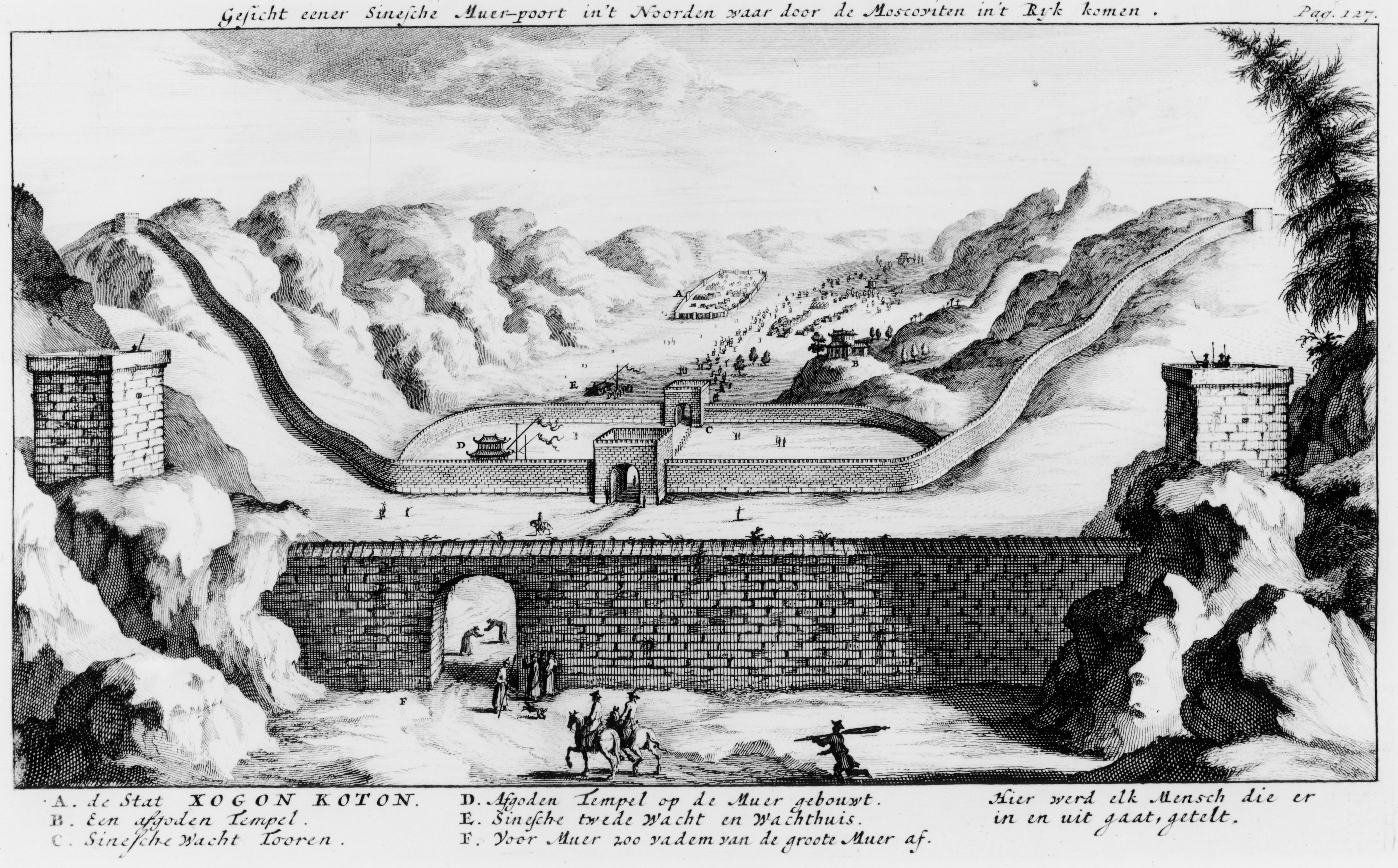 View of one Chinese Wall gate in the North through which the Muscovites enter the Empire. (Chinese Guard Tower F. First Wall, 200 fathoms from the Great Wall, where every entering or leaving person is counted.)
View of one Chinese Wall gate in the North through which the Muscovites enter the Empire. (Chinese Guard Tower F. First Wall, 200 fathoms from the Great Wall, where every entering or leaving person is counted.)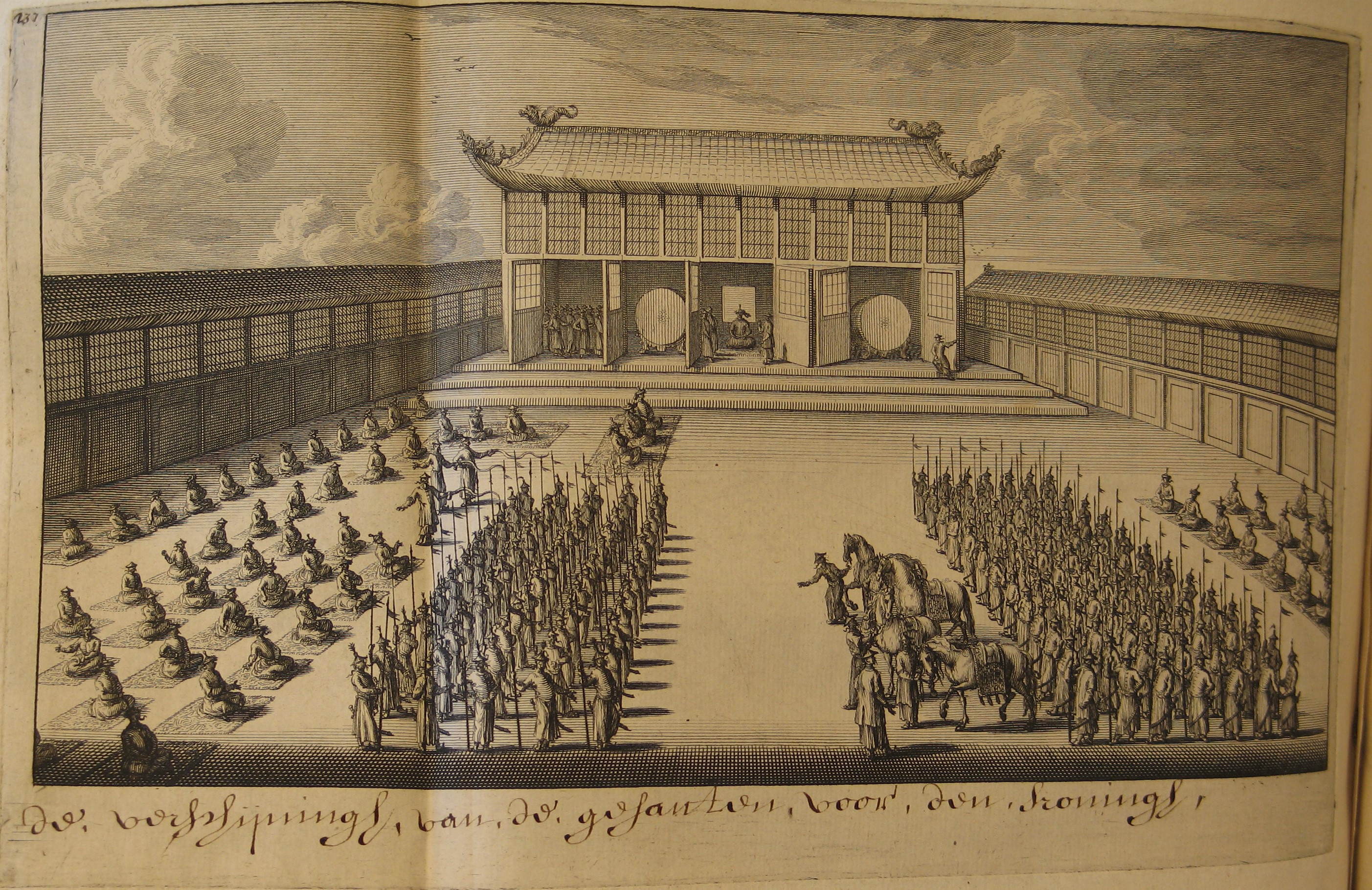 The appearance of the ambassadors before the Chinse king [emperor]. (Farewell audience of the Ambassador with the king of China.)
The appearance of the ambassadors before the Chinse king [emperor]. (Farewell audience of the Ambassador with the king of China.)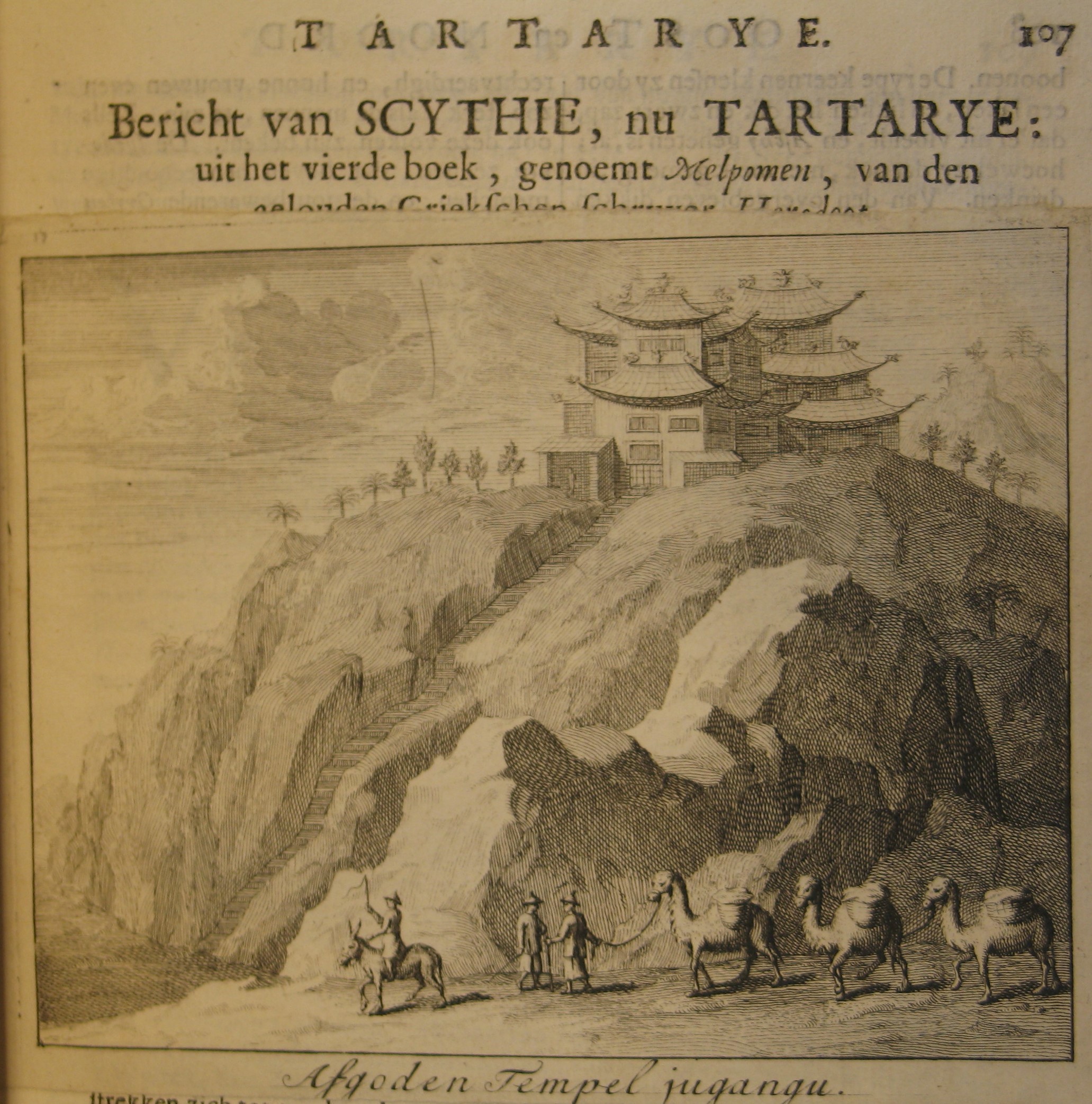 The Idol Temple Jujangu. (Mentiong Scythia and Tartaria.)
The Idol Temple Jujangu. (Mentiong Scythia and Tartaria.)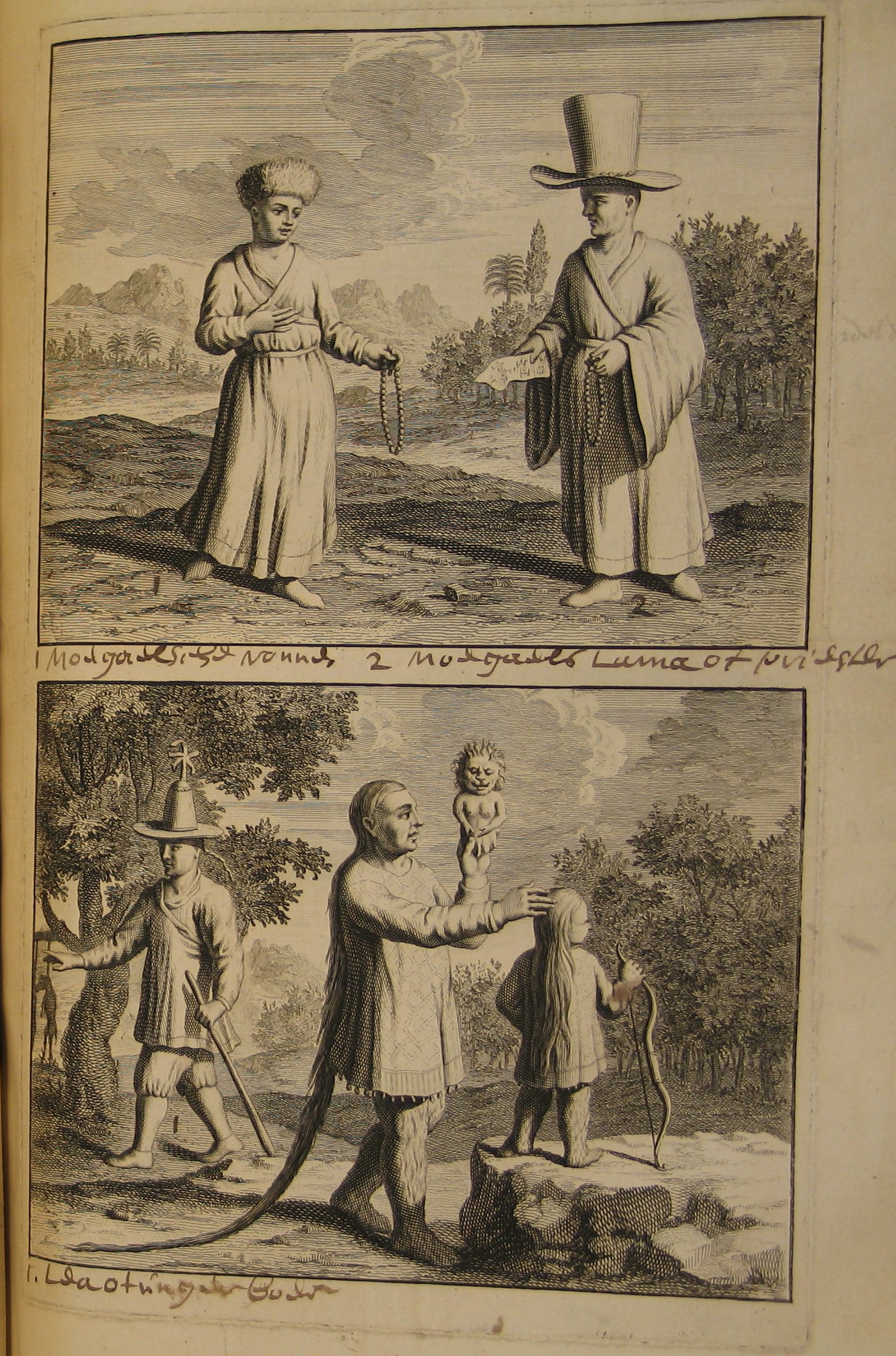 Top: Mongolian Nun Mongolian Lama or Priest. Bottom: Leaotung peasant.
Top: Mongolian Nun Mongolian Lama or Priest. Bottom: Leaotung peasant.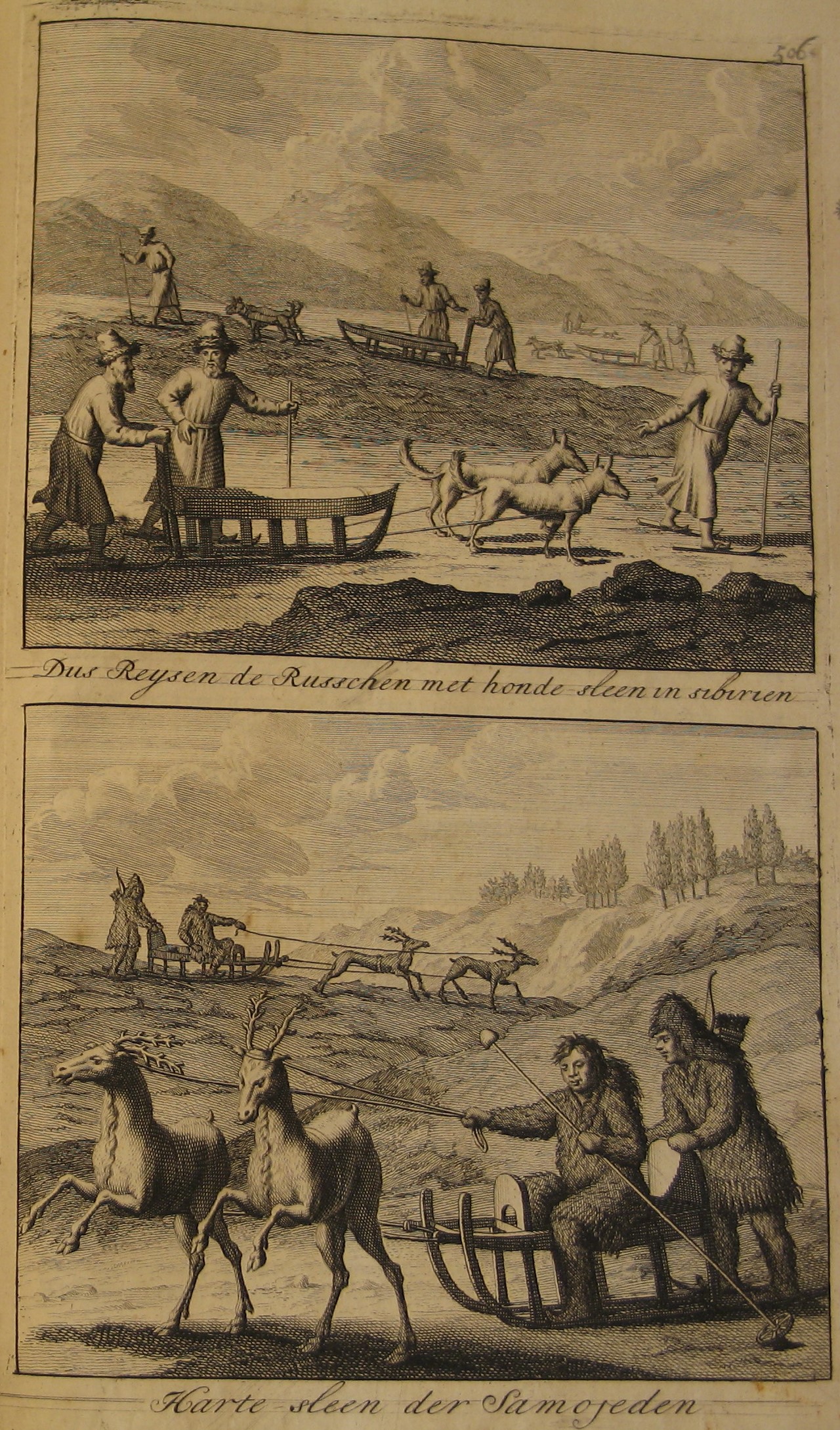 Top: In this way the Russians travel by dog sledge in Siberia. Bottom: Samoyed sledges drawn by deer.
Top: In this way the Russians travel by dog sledge in Siberia. Bottom: Samoyed sledges drawn by deer.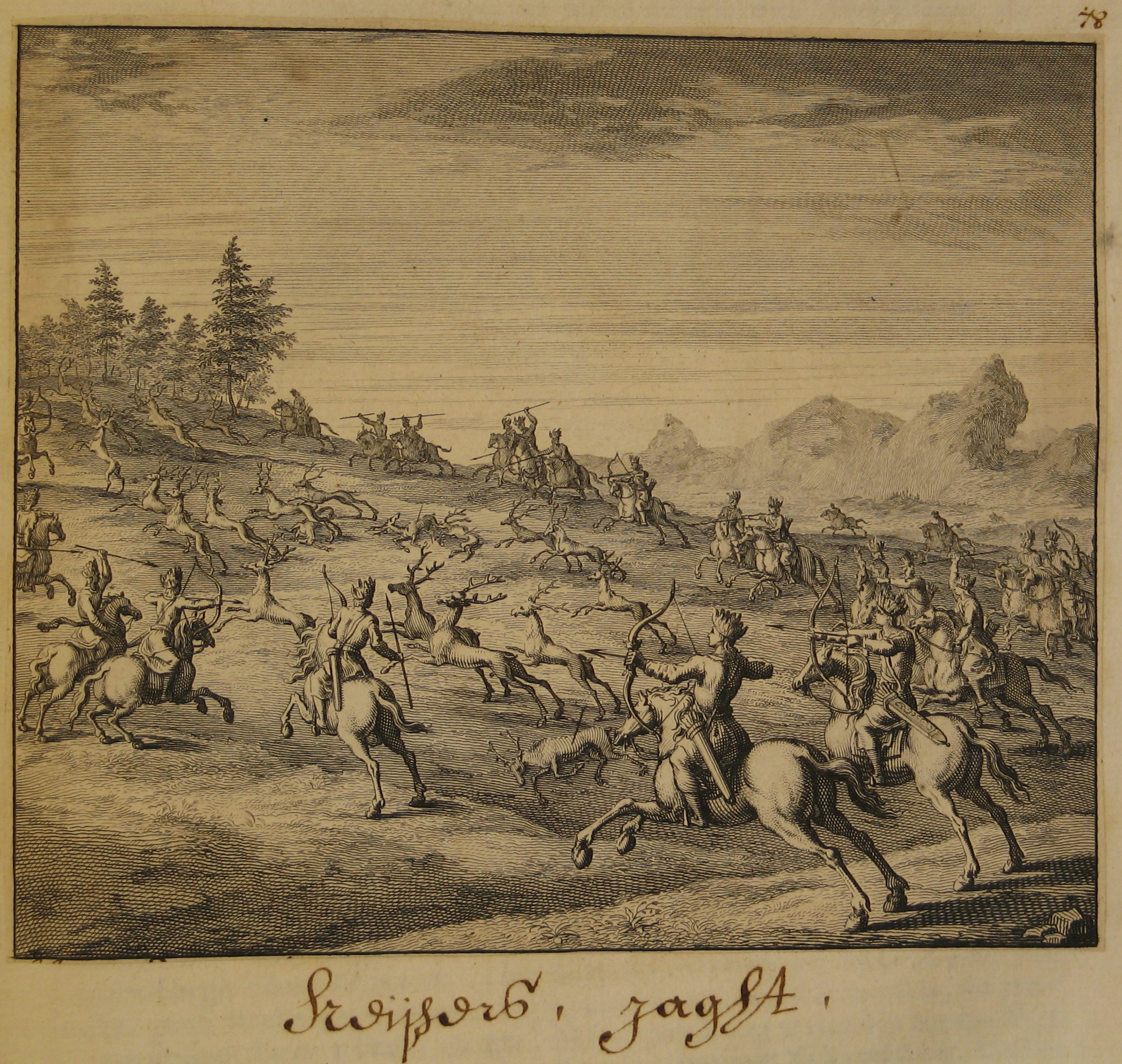 Hunt of the Emperor (In the spring and in the autumn the Buryats group together with many hundreds of people and hunt on horseback deer and wild sheep which they call ablavo.)
Hunt of the Emperor (In the spring and in the autumn the Buryats group together with many hundreds of people and hunt on horseback deer and wild sheep which they call ablavo.)
Maps from the book:
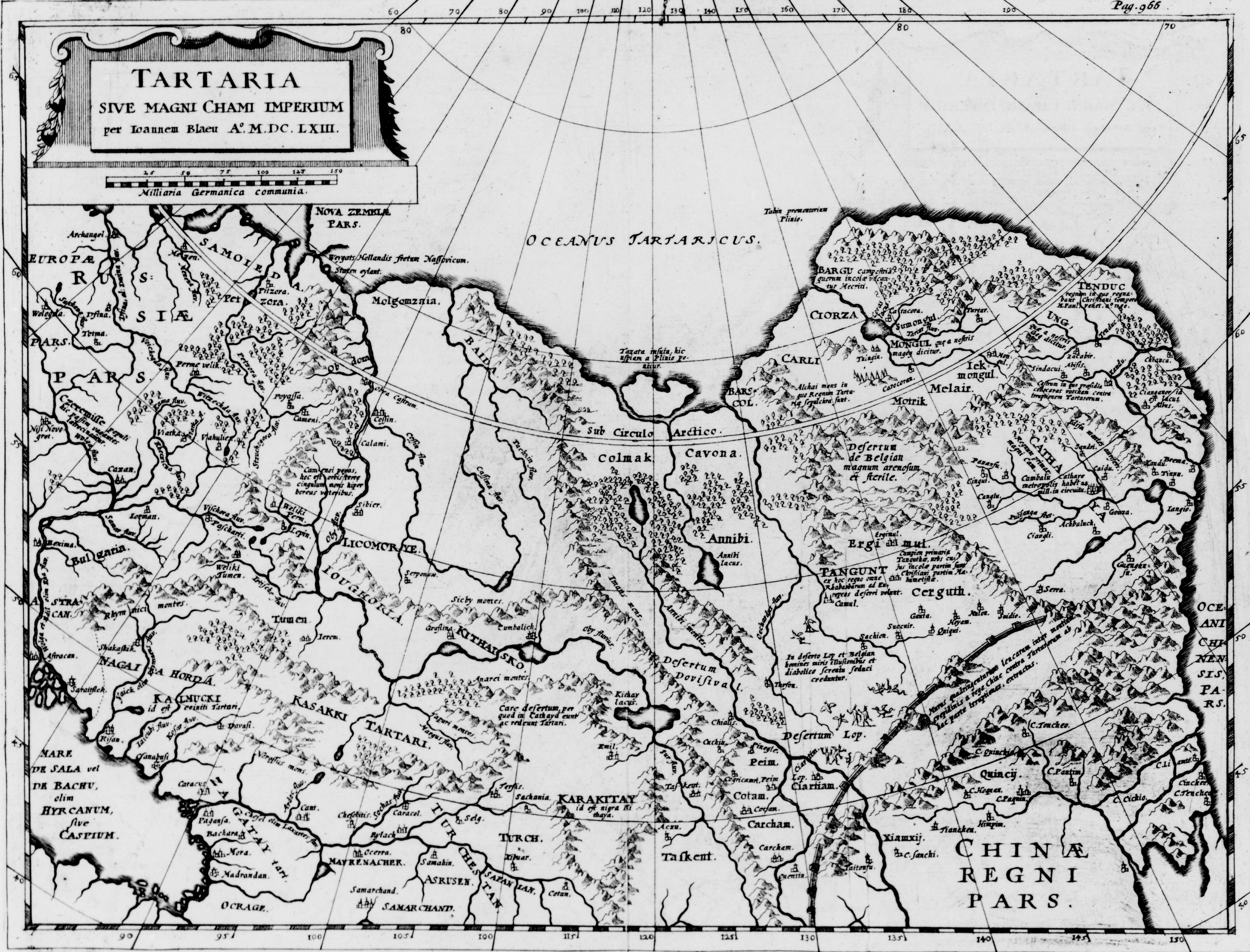
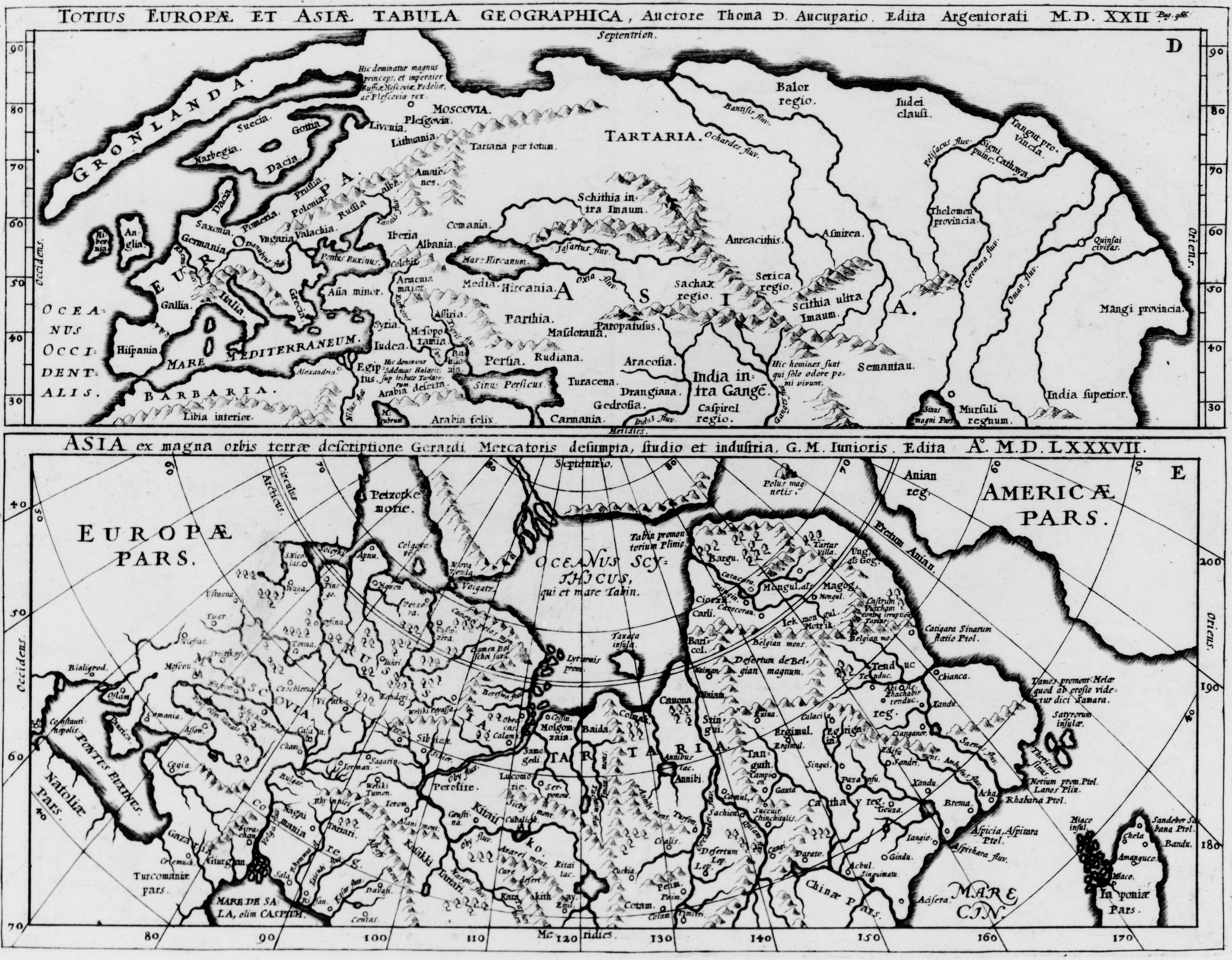
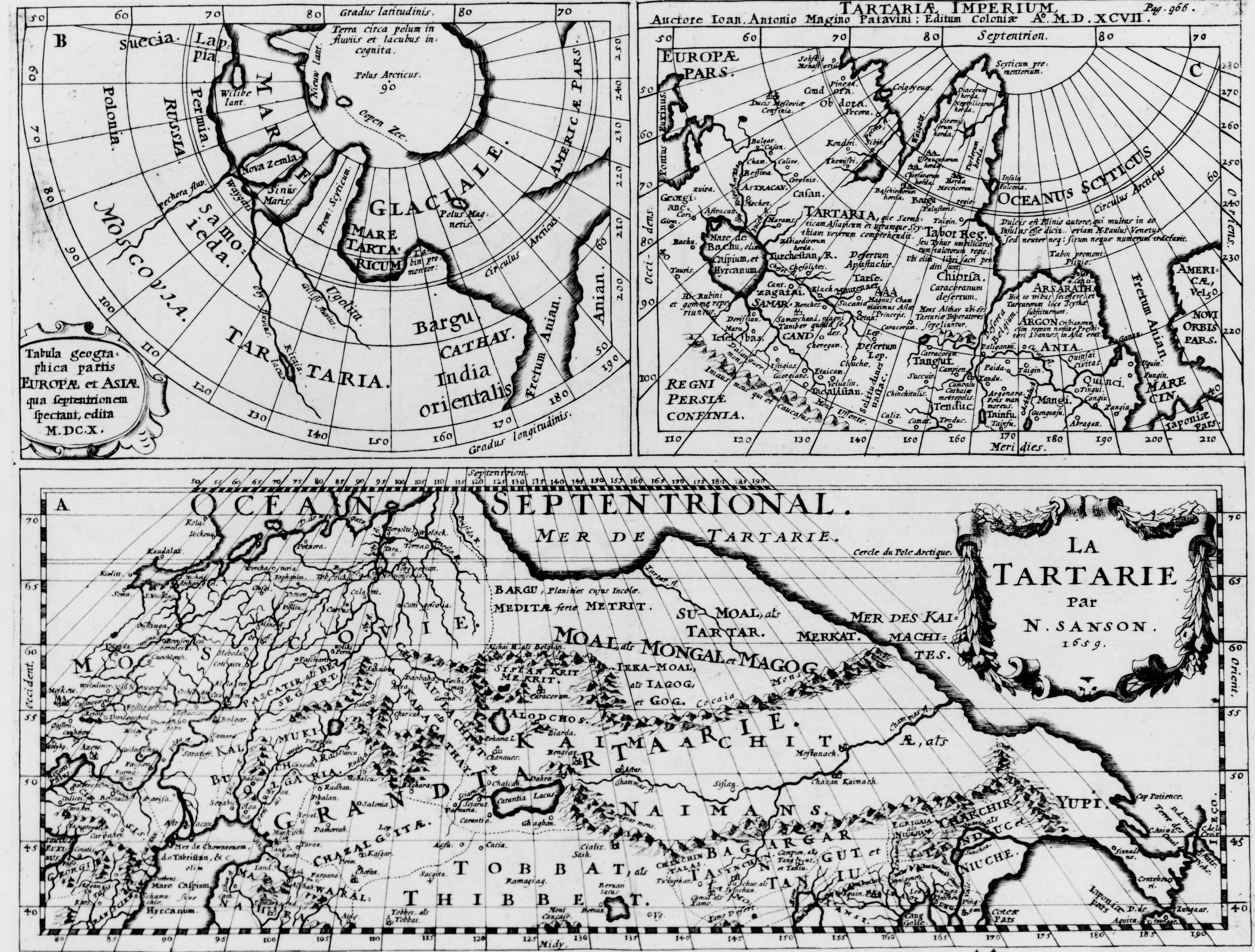 Left: Tartaria or the Imperium of the Great Khan by Johan Blaeu in the year 1613. Middle & Right: Europe & Tartaria maps.
Left: Tartaria or the Imperium of the Great Khan by Johan Blaeu in the year 1613. Middle & Right: Europe & Tartaria maps.
Jewelry
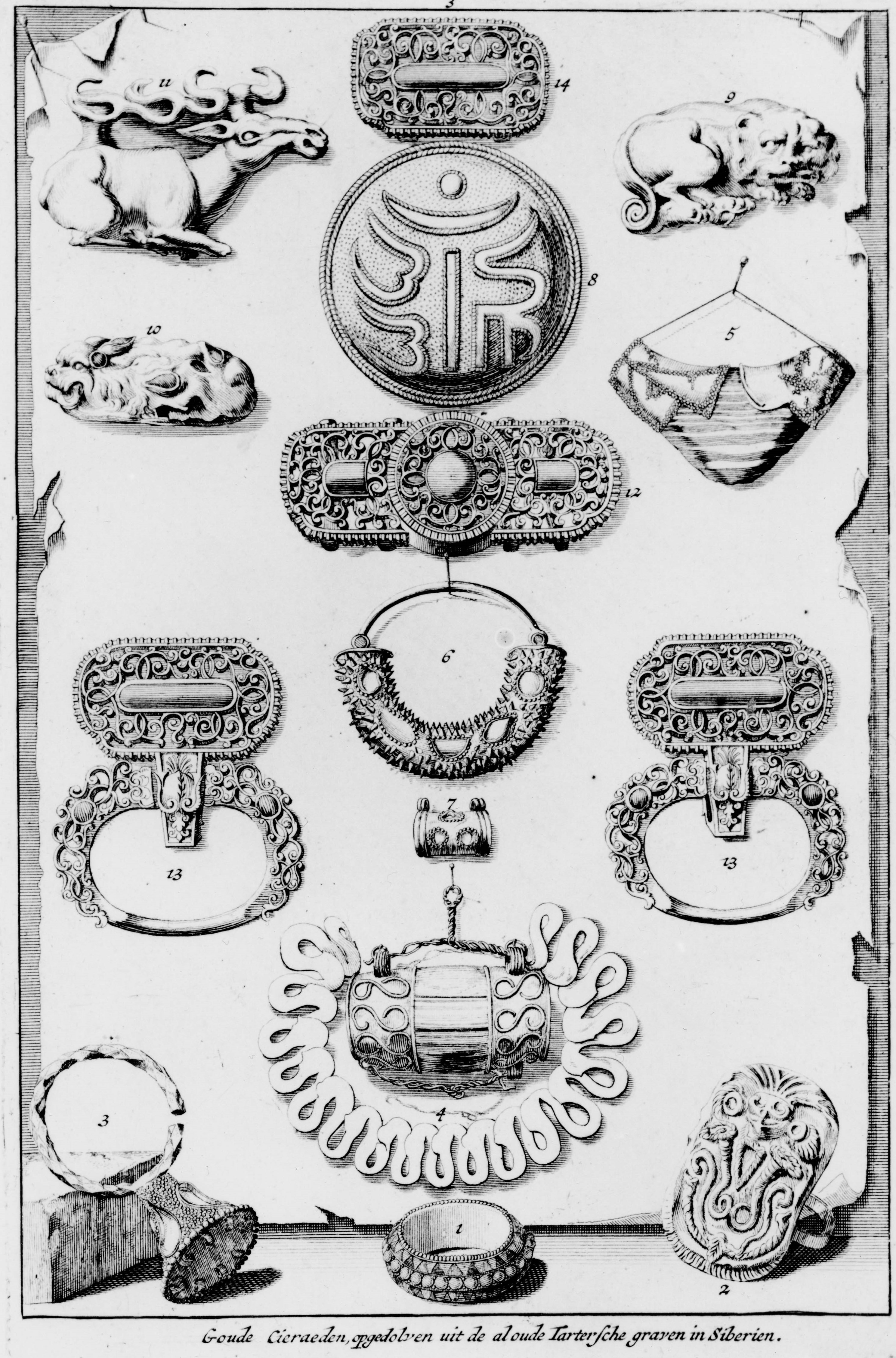
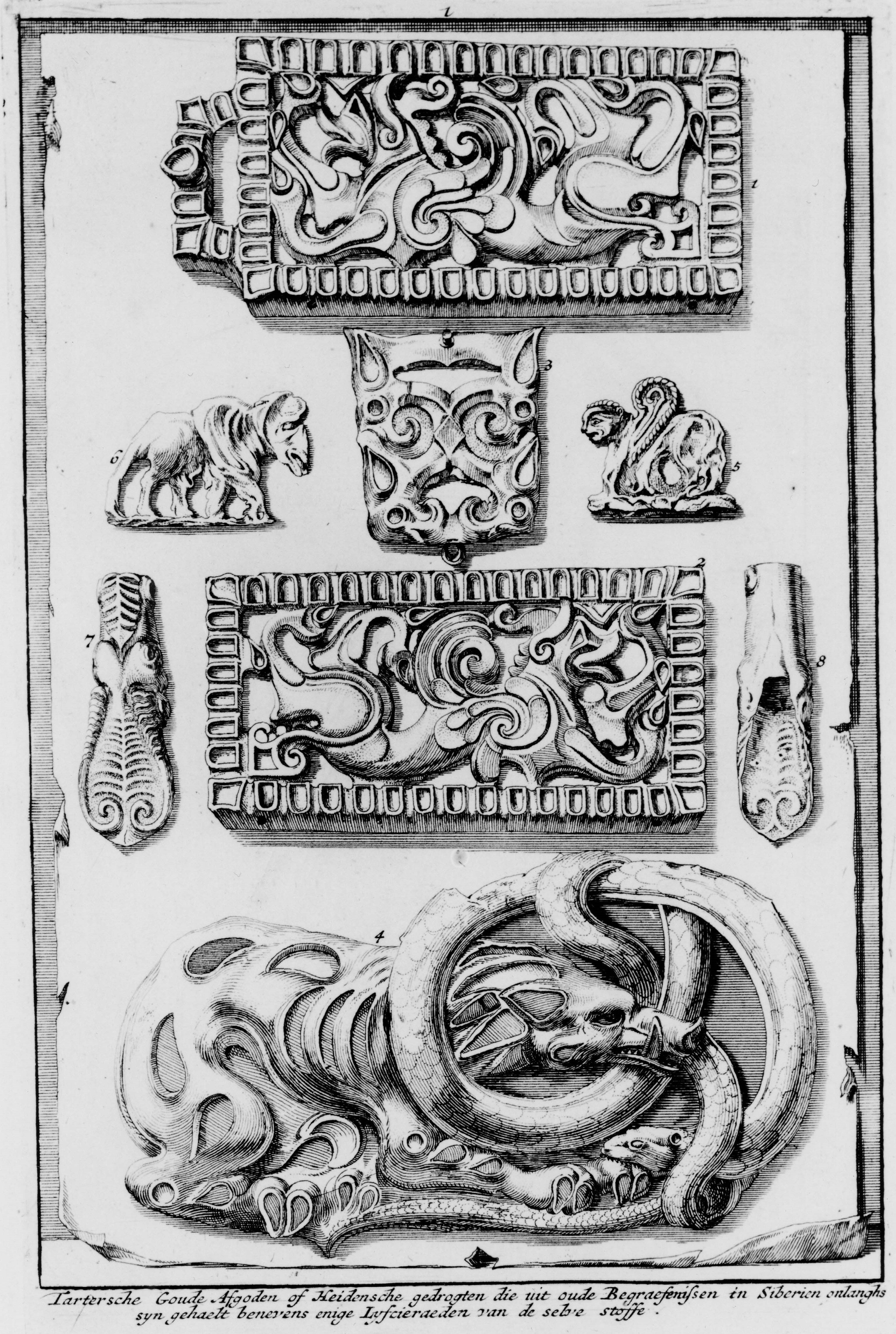 Left: Golden jewels dug out from ancient Tartarian graves in Siberia. Right: Tartarian Golden Idols or Heathen monsters which were recently taken from ancient burial grounds in Siberia together with some body jewels of the same material, Scythian origin. (Source: Book by Nicolaas Witsen ? Noord en Oost Tartarye)
Left: Golden jewels dug out from ancient Tartarian graves in Siberia. Right: Tartarian Golden Idols or Heathen monsters which were recently taken from ancient burial grounds in Siberia together with some body jewels of the same material, Scythian origin. (Source: Book by Nicolaas Witsen ? Noord en Oost Tartarye)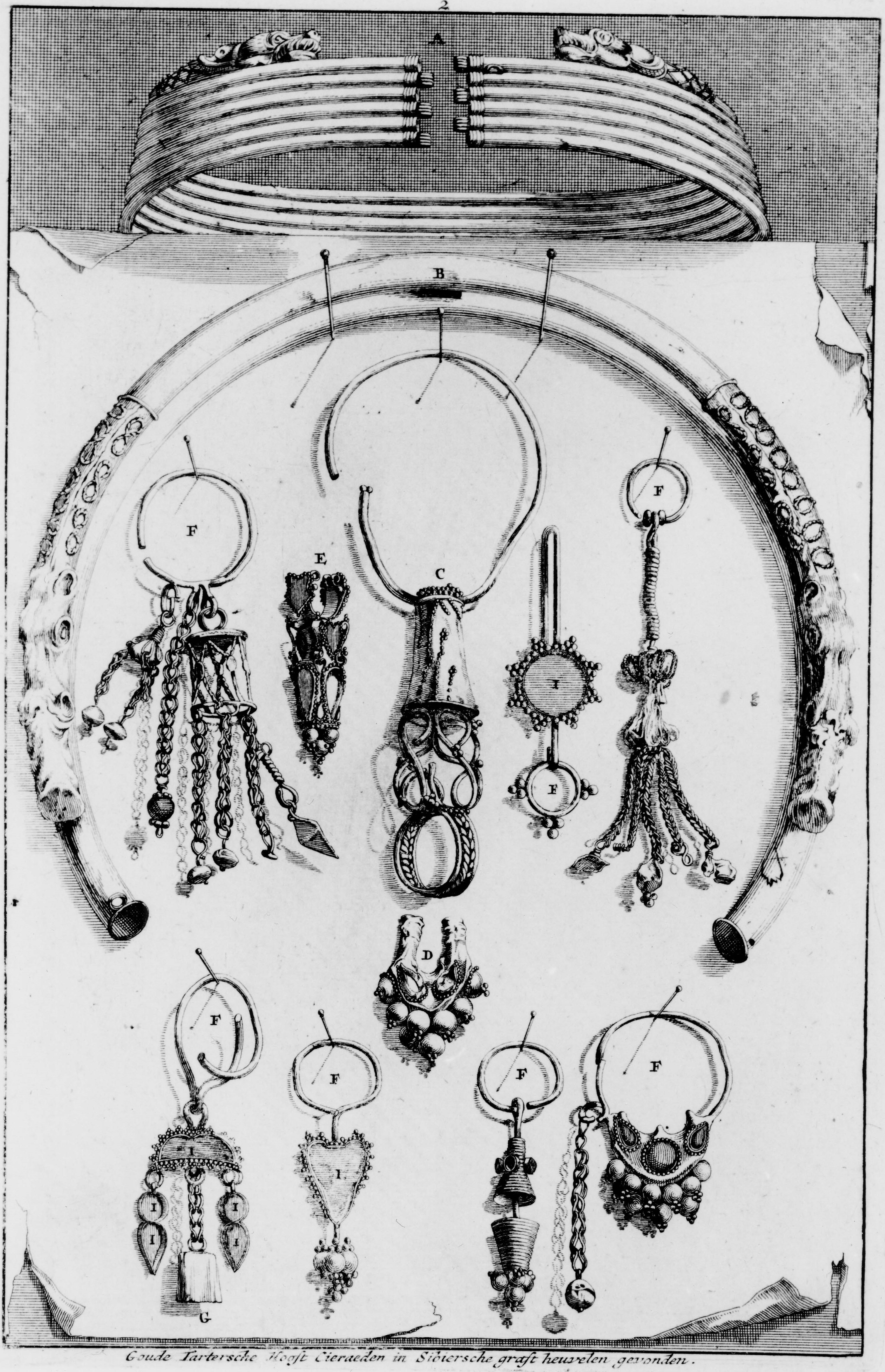 Golden Tartarian Head Jewels found in Siberian burial mounds. (Source: Book by Nicolaas Witsen ? Noord en Oost Tartarye)
Golden Tartarian Head Jewels found in Siberian burial mounds. (Source: Book by Nicolaas Witsen ? Noord en Oost Tartarye)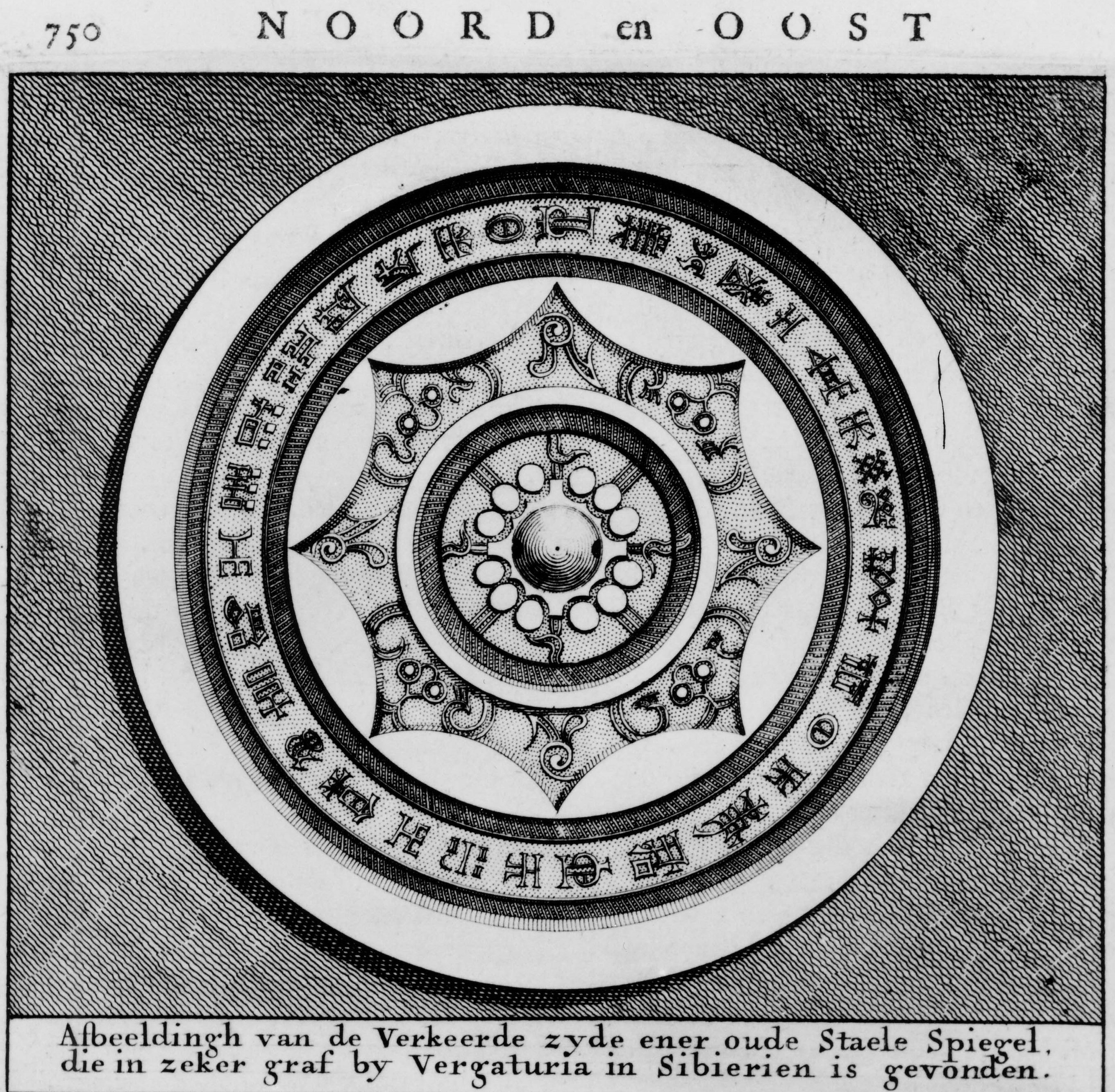 Picture of the underside of an ancient Steel Mirror found in a certain grave near Vergaturia in Siberia.
Picture of the underside of an ancient Steel Mirror found in a certain grave near Vergaturia in Siberia.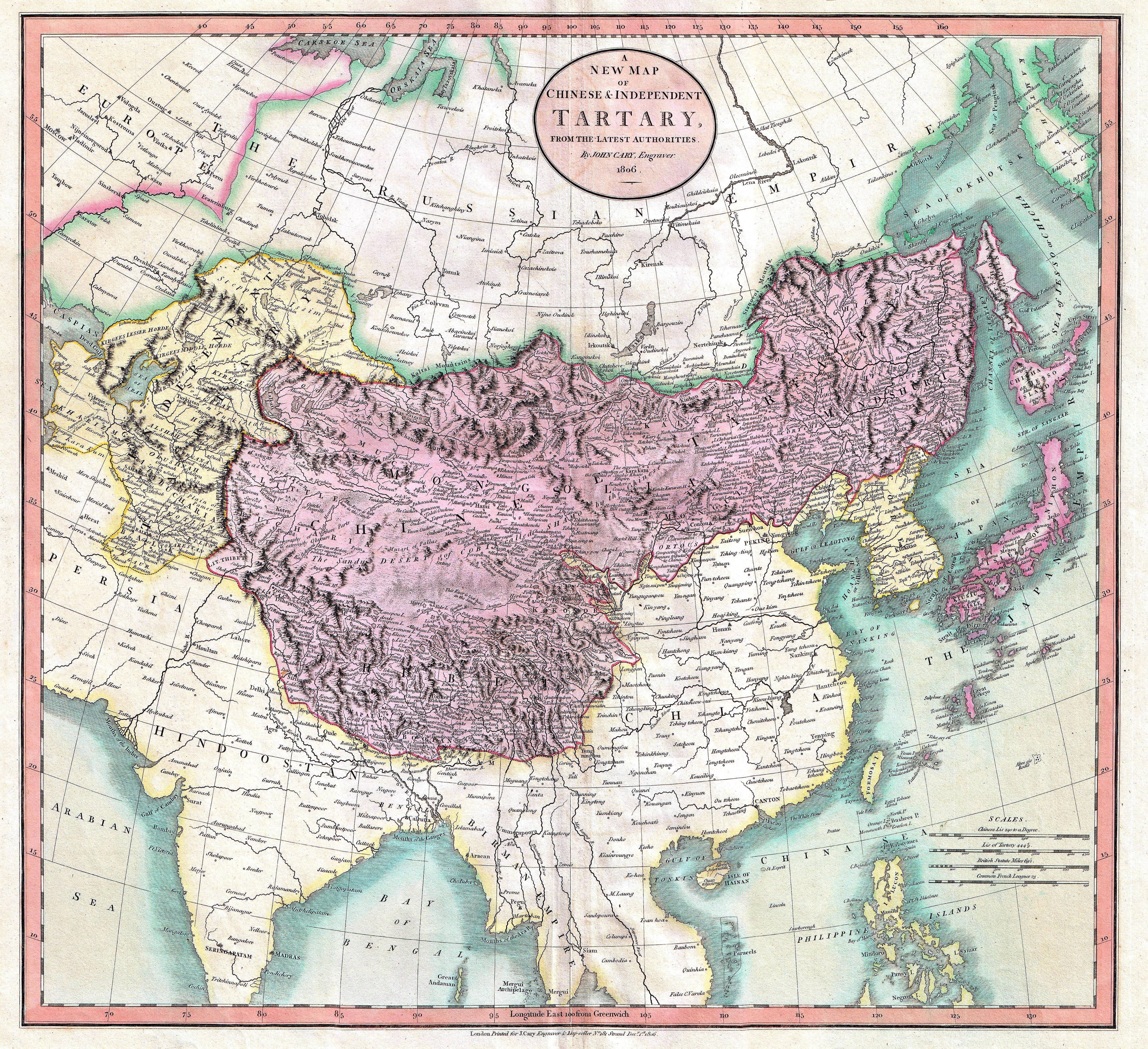 Map of independent Tartary (in yellow on the left) and Chinese Tartary (in violet), in 1806. (Source: Wikipedia)
Map of independent Tartary (in yellow on the left) and Chinese Tartary (in violet), in 1806. (Source: Wikipedia)
At this point I?d like to share the intro of Garry Hogg?s book With Peter Fleming in Tartary, it describes in great poetic detail the vast steppes of Asia and the Silk Road which ran through the lands that we are talking about now.
Two thousand five hundred years ago Chinese merchants were dispatching their great caravans loaded with silk and porcelain jade and lacquer and other rare products of their genius and industry westwards, ever westwards, from the Orient. And at length they reached Europe, to excite the wonder and desire of people who had never dreamed such wares could exist.
These were stupendous overland journeys, covering thousands upon thousands of miles and lasting sometimes for years between start and finish. There were no roads; until the pioneer caravans had worked their arduous way westwards there were not even tracks. There were windswept plateaux, there was endless desert, there were ancient, dried-up riverbeds, there were great mountain ranges. There were sand-dunes growing a thin, tough camel scrub; there were naked rocks split and fractured by the cruel heat of the burning sun and the intense cold of frost and blizzard. But there were no roads, no signposts, nothing to show that anyone had ever passed that way before ? except the skeletons of animals that had collapsed and been abandoned in the desert or mountain pass to die, and the skeletons, too, of their drivers who, in spite of their toughness and great powers of endurance, had died of exhaustion, exposure, or thirst. No man, when he set out westwards from his home in the kindlier eastern part of China, could be certain that he would ever see his home and loved ones again.
That dauntless traveler Peter Fleming, set out on one of his great journeys, from Peking, in Eastern China, to Srinagar, in Northern India: a journey of more than 3,500 miles, most of them along the ancient route of the first Chinese caravans. He has never traveled more courageously, more resourcefully, nor written about his travels more splendidly, than he did on this great journey, about which he wrote his book, ?News from Tartary?.
You will not find the name ?Tartary? in your atlas ? unless it is a very old, out-of-date one ? for the name died out a century ago, giving place to Mongolia, especially Inner Mongolia, and especially, too, that portion of Inner Mongolia today known as Sinkiang, or Chinese Turkestan. Peter Fleming, of course, knew as well as anyone that the name ?Tartary? is not on modem maps; but he chose to use it in his title.
Though geographers and ethnographers refer to the nomadic peoples through whose territory he passed as ?Mongols?, their ancestors were the Tartars, the men who owed allegiance first to the great and ruthless Genghis Khan and later to his grandson, Kublai. The Tartars, under a succession of great and ruthless leaders, dominated China during the early Middle Ages and maintained a reign of terror. Their rule covered the whole vast region that extended between the Sea of Japan and the River Dnieper. They were born horsemen, and grouped together in great bands, swift, unpredictable and cruel. Their home was the great Mongolian Plateau ? a chain of plateaux interrupted here and there by near-impassable mountain ranges. It was, then, and remains still, a vast, empty, desolate region, almost entirely devoid of trees, blistered in summer by an unbearably hot sun and made equally unbearable in winter by the incessant ice-cold winds that sweep over it. Such changes of climate made it necessary for the inhabitants of the plateaux to be constantly on the move, in search of pasture for their flocks and herds; in search, too, of sufficient water.
The hard life made them into hard men. To exist at all they had to fights plunder, ravage, destroy. They gained a reputation for brutality, for destructiveness, that created terror wherever rumors of their movements penetrated. Across the great sweep of plateau and desert where they raided at some of the caravan routes passed; and the men of those caravans knew well that if the hordes of Tartars descended upon them, they would be wiped out to a man. It was Genghis Khan who knit together the scattered communities of Tartars and shaped them into an all-conquering force, and he did it in a curious manner.
Genghis Khan, it meant, quite simply, ?Great and Perfect Warrior?. Genghis Khan soon established his Tartar Empire in North China. Then he turned south and west, and little by little conquered the whole of Asia between Lake Balkash in the west and Tibet in the south. He conquered all the territories of the Indus and the Persian Gulf, Georgia, and the Caspian Sea; when he died, his empire stretched from Korea to Bulgaria; no mean record for a lifetime of sixty-odd years! It is through this vast stretch of inhospitable, dangerous country that the so-called ?Silk Road?, ran. The Silk Road ? so named because it came to be the most important of the desert and mountain routes along which the Chinese silk caravans passed.
Is Tartary mentioned in the history of Russia and Mongolia?
We?ll take a look into some other civilizations to see if they?re related to the Tartarians or if they have taken part in the Tartarian history in some way.
We?ll look into the history of the ancient Russia & Tsars, Mongol Empire & Genghis Khan.
Mongol Empire
The Mongol Empire stretched from present-day Poland & Ukraine in the west to Korea in the east, and from parts of Siberia in the north to the Gulf of Oman and Vietnam in the south, covering some 33,000,000 square kilometres (13,000,000 sq mi), (22% of Earth?s total land area) and had a population of over 100 million people (about a quarter of Earth?s total population at the time).
A khaganate or khanate was a political entity ruled by a khan, khagan, khatun, or khanum. This political entity is typical for people from the Eurasian Steppe and it can be equivalent to tribal chiefdom, principality, kingdom or empire.
After Genghis Khan established appanages for his family in the Mongol Empire during his rule (1206?1227), his sons, daughters, and grandsons inherited separate sections of the empire.
History of the Tatars
Based on Wikipedia:
Crimean Khanate
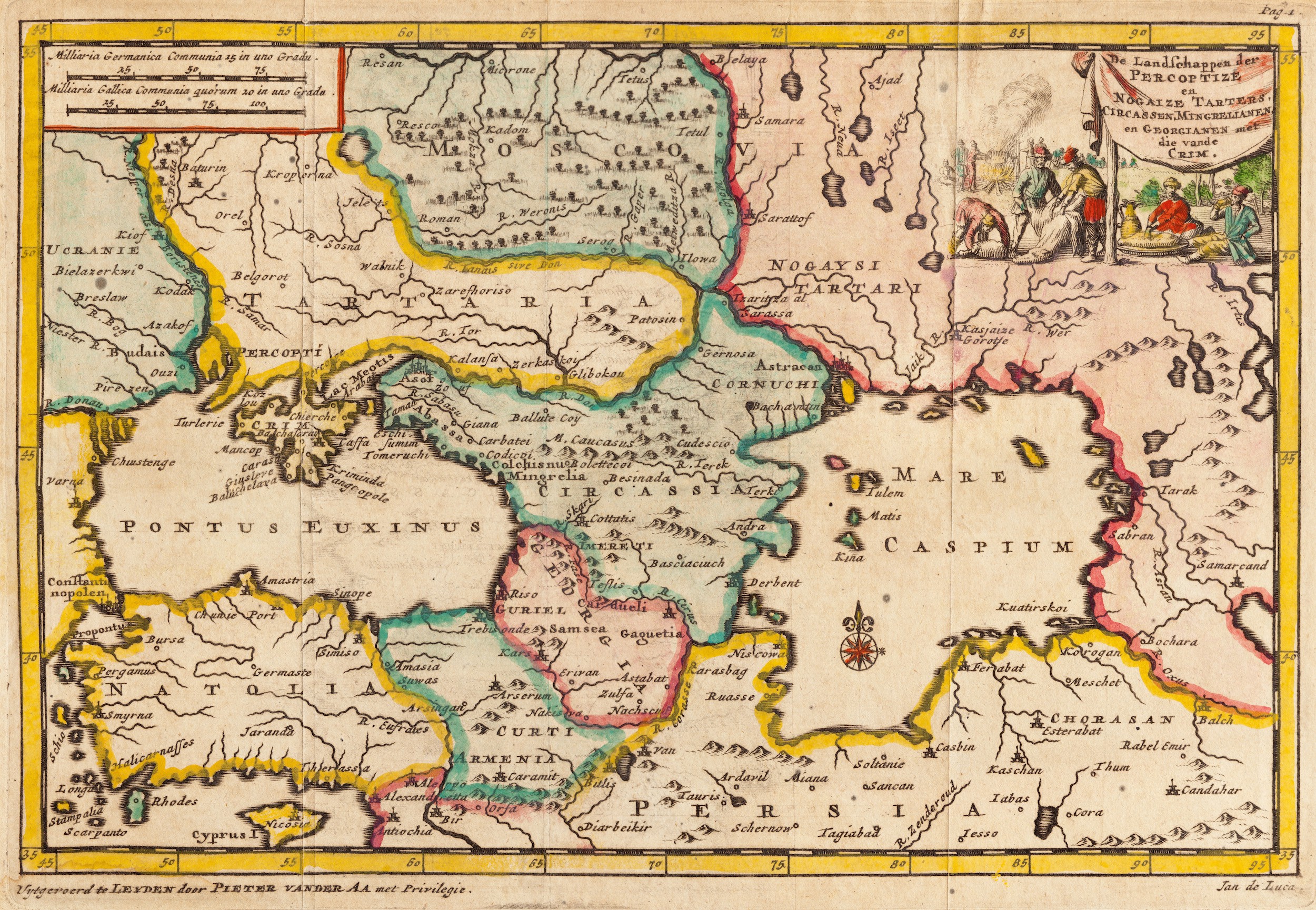 The map of the Crimean Khanate by Pieter van der Aa, 1707. (Source: Wikipedia)
The map of the Crimean Khanate by Pieter van der Aa, 1707. (Source: Wikipedia)
The Crimean Khanate, own name ? Great Horde, in old European historiography and geography ? Little Tartary (Latin: Tartaria Minor) was a Crimean Tatar state existing from 1441 to 1783, the longest-lived of the Turkic khanates that succeeded the empire of the Golden Horde. Established in 1441, it was regarded as the direct heir to the Golden Horde and to Desht-i-Kipchak.
In 1783, violating the 1774 Treaty of Kk Kaynarca (which had guaranteed non-interference of both Russia and the Ottoman Empire in the affairs of the Crimean Khanate), the Russian Empire annexed the khanate. Among the European powers, only France came out with an open protest against this act.
Tatar confederation
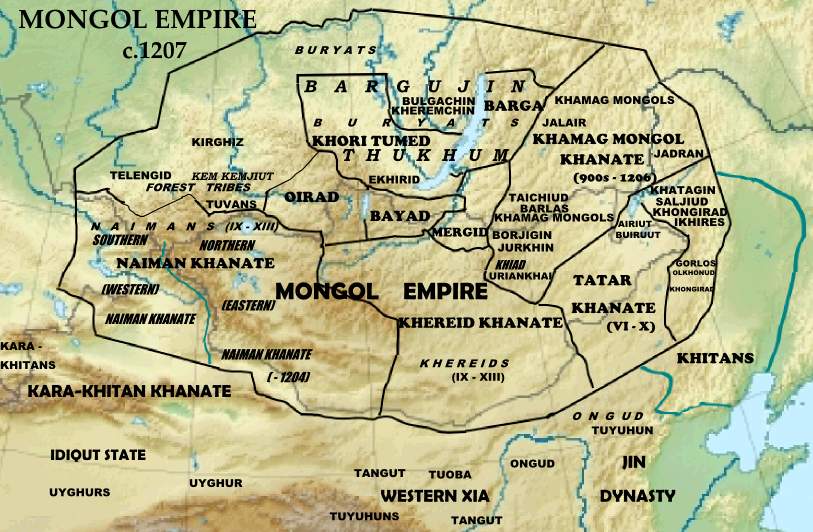 Tatar and their neighbours in the 13th century.
Tatar and their neighbours in the 13th century.
Tatar was one of the five major tribal confederations (khanlig) in the Mongolian Plateau in the 12th century.
The name ?Tatar? was first transliterated in Book of Song as other name of the Rourans, who were of Proto-Mongolic Donghu ancestry. Songshu and Liangshu connected Rourans to the earlier Xiongnu while Weishu traced the Rouran?s origins back to the Donghu.
The first precise transcription of the Tatar ethnonym was on the Orkhon inscriptions referring to the Tatar confederation. Subsequently, the wider region was referred to by Europeans as ?Tartary? or ?Tartaria?.
The Tatars? Rouran ancestors inhabited the north-eastern Gobi in the 5th century and founded the Rouran Khaganate. The scholar Mahmud al-Kashgari noted that the Tatars are bilingual, speaking Turkic alongside their own language.
The Tatars were subjugated by Mongol leader Temujin, who subsequently, as Genghis Khan, founded the Mongol Empire. Under the leadership of his grandson Batu Khan, Tatars accompanied Mongols westwards, driving with them many of the Turkic peoples toward the plains of Russia in the Turkic migrations.
The name Tatar was used by Russians and Europeans to denote Mongols as well as Turkic peoples under Mongol rule, especially in the Golden Horde. Later, it was used for any Turkic or even Mongolic speaking people encountered by Russians. Eventually however, the name stuck onto the Turkic Muslims of Ukraine and Russia, namely, the descendants of Muslim Volga Bulgars, Kipchaks, and Cumans, and Turkicized Mongols or Turko-Mongols (Nogais), as well as other Turkic speaking peoples (Siberian Tatars, Qasim Tatars, Mishar Tatars).
Russian History
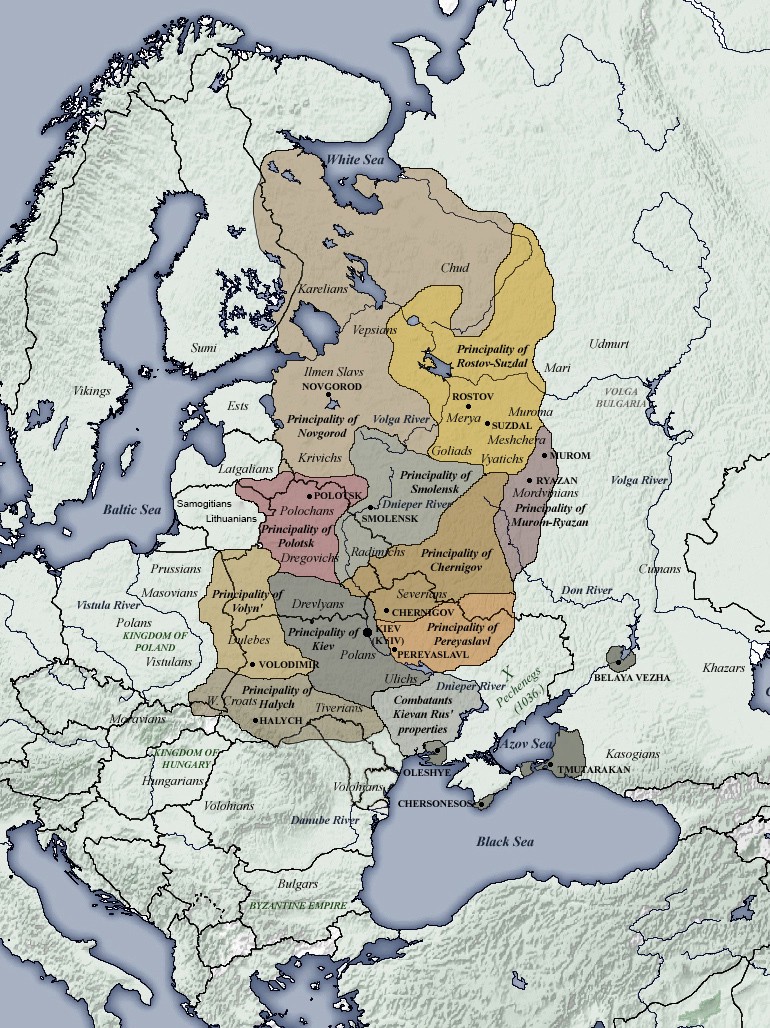 Realm of Kievan Rus? at its height superimposed over modern European borders (with dependent lands). (Source: Wikipedia)
Realm of Kievan Rus? at its height superimposed over modern European borders (with dependent lands). (Source: Wikipedia)
Kievan Rus? (Greek: ?????); Latin: Rus(s)ia, Ruscia, Ruzzia) was a loose federation of East Slavic and Finnic people in Europe from the late 9th to the mid-13th century, under the reign of the Varangian Rurik dynasty. The modern nations of Belarus, Russia, and Ukraine all claim Kievan Rus? as their cultural ancestors, with Belarus and Russia deriving their names from it. Russia itself was ruled by the Rurikid dynasty until 16th century. The state began to decline in the late 11th century and during the 12th century, disintegrating into various rival regional powers. It was further weakened by economic factors, such as the collapse of Rus? commercial ties to the Byzantine Empire due to the decline of Constantinople and the accompanying diminution of trade routes through its territory. The state finally fell to the Mongol invasion of the 1240s.
The Rurik dynasty, was a dynasty founded by the Varangian prince Rurik, who established himself in Novgorod around the year AD 862. The Rurikids were the ruling dynasty of Kievan Rus? (after 882), as well as the successor principalities of Galicia-Volhynia (after 1199), Chernigov, Vladimir-Suzdal, and the Grand Duchy of Moscow, and the founders of the Tsardom of Rus (Tsardom of Russia). Ivan the Terrible was the first Tsar of Russia from 1547 to 1584. They ruled until 1610 and the Time of Troubles, following which they were succeeded by the Romanovs. They are one of Europe?s oldest royal houses, with numerous existing cadet branches.
As a ruling dynasty, the Rurik dynasty held its own in some part of Russia for a total of twenty-one generations in male-line succession, from Rurik (died 879) to Vasili IV of Russia (died 1612), a period of more than 700 years.
The House of Romanov was the reigning royal house of Russia from 1613 to 1917.
On 1613, Michael Romanov was elected Tsar of Russia establishing the Romanovs as Russia?s second reigning dynasty. Michael?s grandson Peter I established the Russian Empire in 1721, transforming the country into a great power through a series of wars and reforms.
The abdication of Tsar Nicholas II on 1917 as a result of the February Revolution ended 304 years of Romanov rule, establishing the Russian Republic under the Russian Provisional Government in the lead up to the Russian Civil War. In 1918, the Tsar and his family were executed by the Bolsheviks and the 47 survivors of the House of Romanov?s 65 members went into exile abroad.
This shows us that Russia?s dynasties and Tsars could easily conquer countries/areas and according to the declassified CIA document, even delete some parts of history to hide their actions.
As we know:
?History is always written by the winners.
When two cultures clash, the loser is obliterated, and the winner writes the history books ? books which glorify their own cause and disparage the conquered foe. As Napoleon once said, ?What is history, but a fable agreed upon???
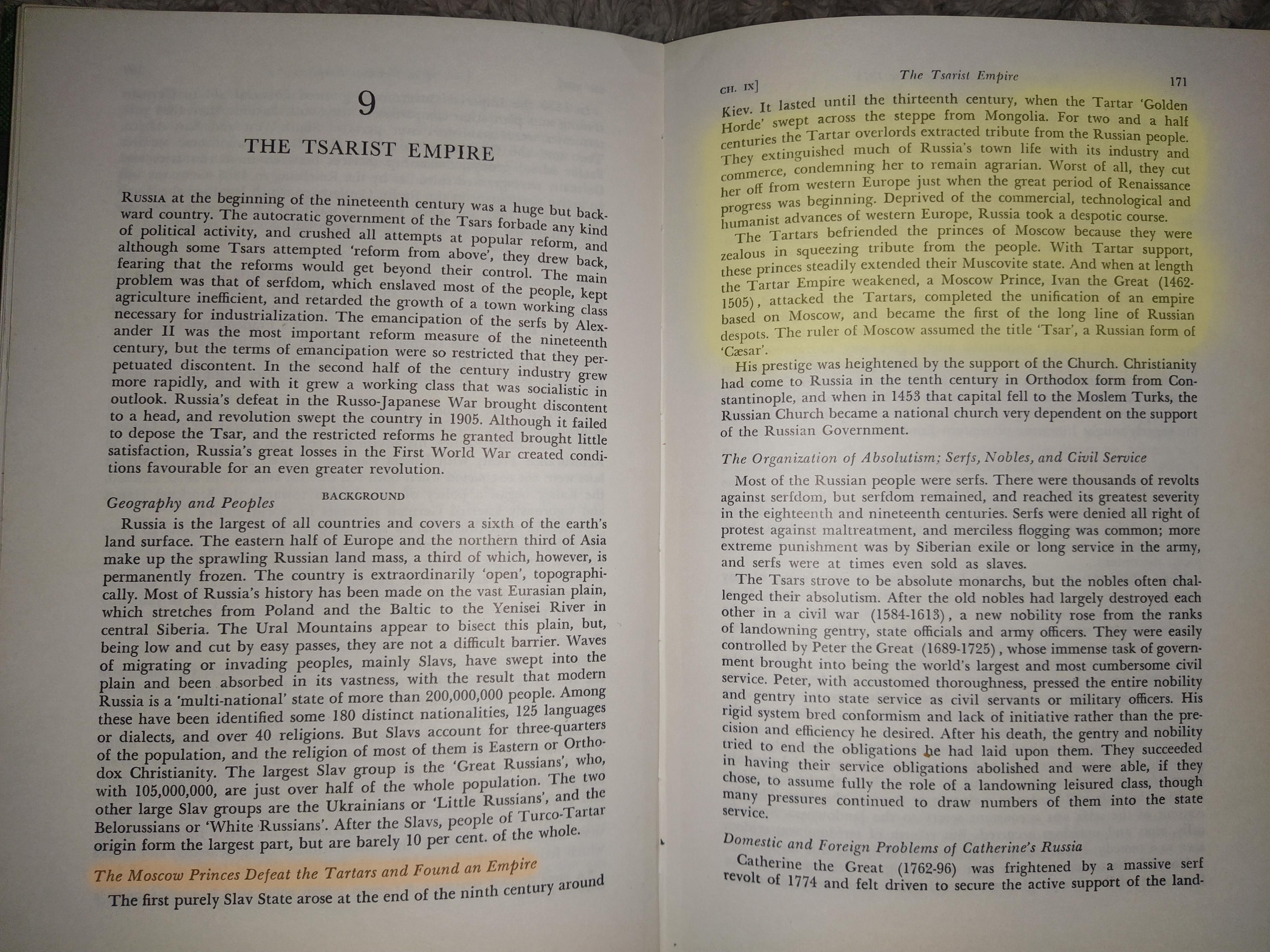
So, the bottom line from the Mongolian and Russian history is that the Tartarian tribes existed since the 4?5th century AD. Genghis Khan united some of these nations and created the Mongol Empire in the 1200s. When he died the empire was divided in Khanates where his sons & grandsons ruled. Later, Russian Tsars defeated them and occupied the Tartarian lands. The Tartarian lands can be at the location of modern Turkestan, Mongolia, China & Russia/Siberia.
Max Igan ? History and Tartaria
In this video of TheCrowHouse, Max Igan talks about the importance of history and explores if it could be altered by the ruling elite of governments throughout the centuries.
In my opinion, it?s worth watching it.
Conspiracy Theories Online ? The Mud Flood and Free Energy
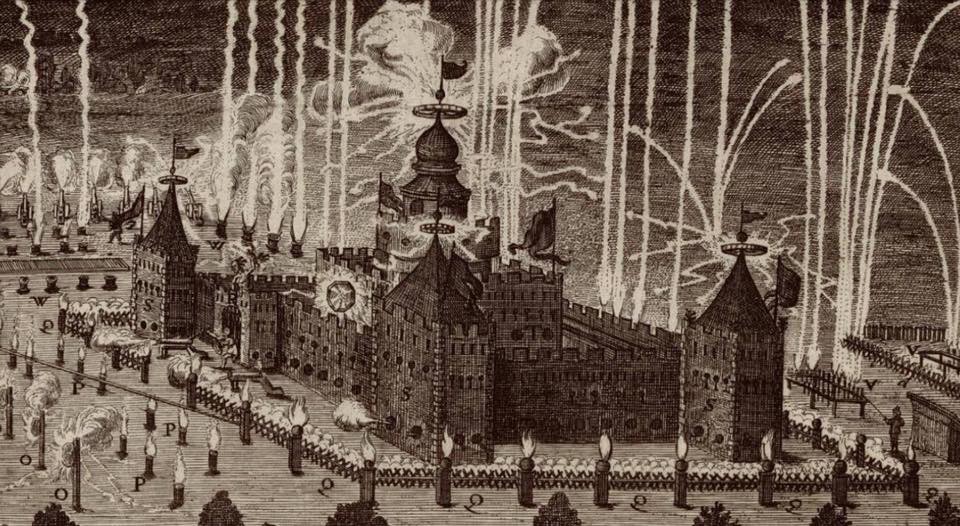 Conspiracy theorists claim there were buildings that produced free energy and that this technology is hidden now.
Conspiracy theorists claim there were buildings that produced free energy and that this technology is hidden now.
If you search for ?Tartary? or ?Tartaria? on Youtube you can find many videos claiming that Tartaria was a vast empire that was defeated by the modern day?s elite, they had gothic architecture buildings that produced free energy out of the ether and that their entire history was hidden & deleted.
The mud flood theory refers to buildings that are half buried in the ground due to a recent big flood that isn?t mentioned by anyone and how it may relate to the lost nation of Tartaria, the reset of civilization, and the rewriting of history as we know it. They go as far as to even claim that the entire history could be altered, that the floods and civilizations of 2,500 years ago actually happened and existed 500 years ago.
Conclusion
My personal opinion on these conspiracy theories is that the history can easily be re-written by the use of genocides and oppressive dictatorships through the centuries, as Max Igan states on his video above, but conspiracy theorists are portraying wild, far-fetched ideas on this one, based on almost no actual facts.
The way I?m approaching these theories is to always look for facts and truth to see if any logical assumptions can be made, and in this case the scale weighs more on the side of fantasy than truth. Sometimes these theories can be right but we don?t have enough available knowledge and evidence to prove or debunk them.
Book Mentions
Tartaria is mentioned in many books of the 18th and 19th centuries by Europeans. A list of these books:
- History Of Mufcovy Tartary Perfia And Other Countries
- History of the two Tartar conquerors of China : including the two journeys into Tartary of Father Ferdinand Verhiest
- Narrative of a pedestrian journey through Russia and Siberian Tartary
- Tibet, Tartary And Mongolia Ed. 2nd
- Travels in Russia, Tartary and Turkey
- With Peter Fleming in Tartary
- Tibet, Tartary, and Mongolia ; their social and political condition, and the religion of Boodh, as there existing
Some of the info was derived from this article: https://www.stolenhistory.org/threads/tartary-an-empire-hidden-in-history-it-was-bigger-than-russia-once.40/


